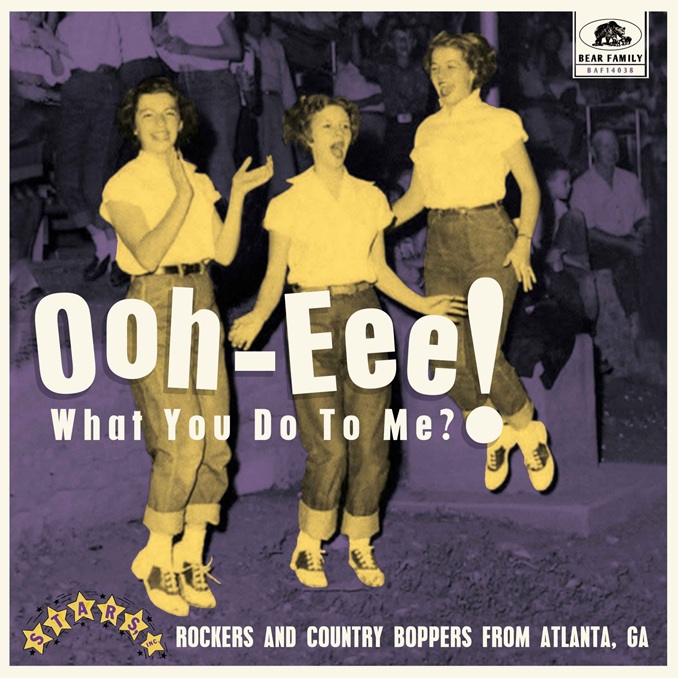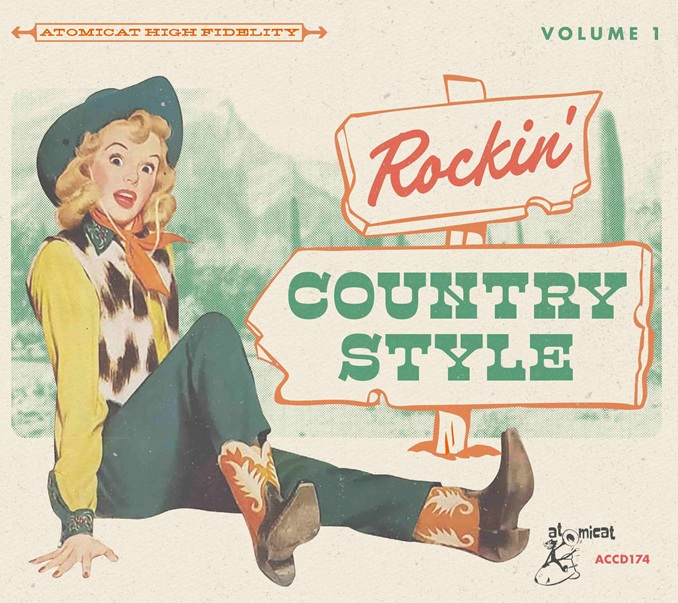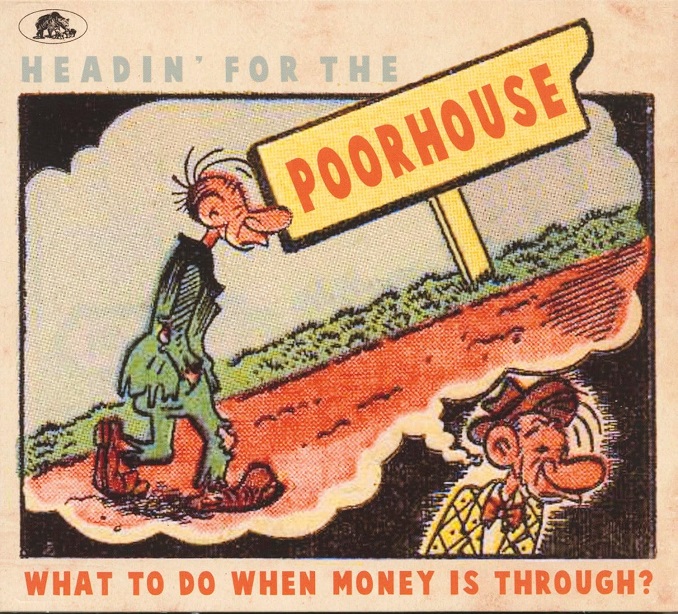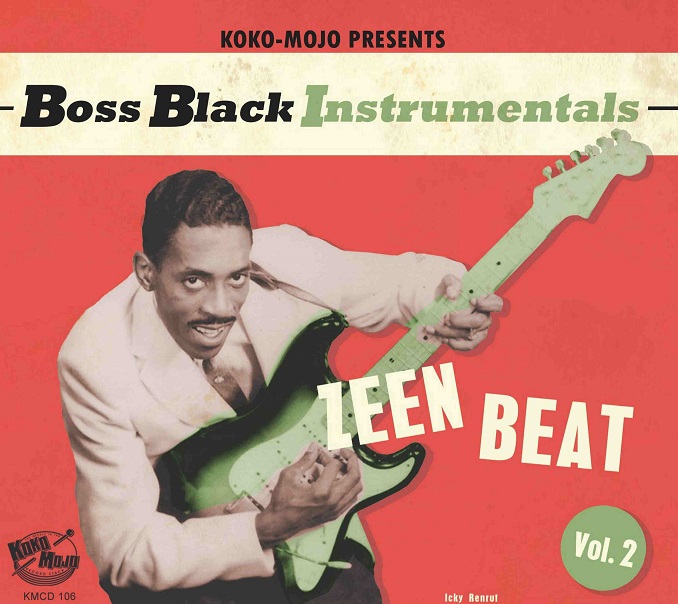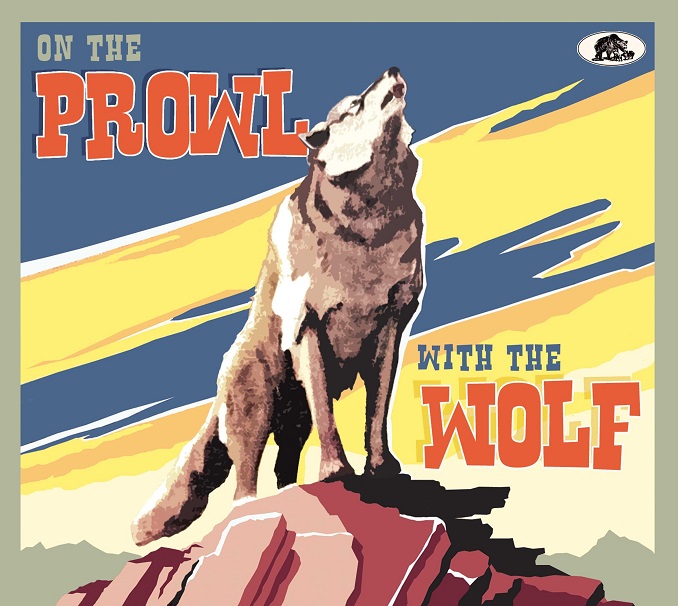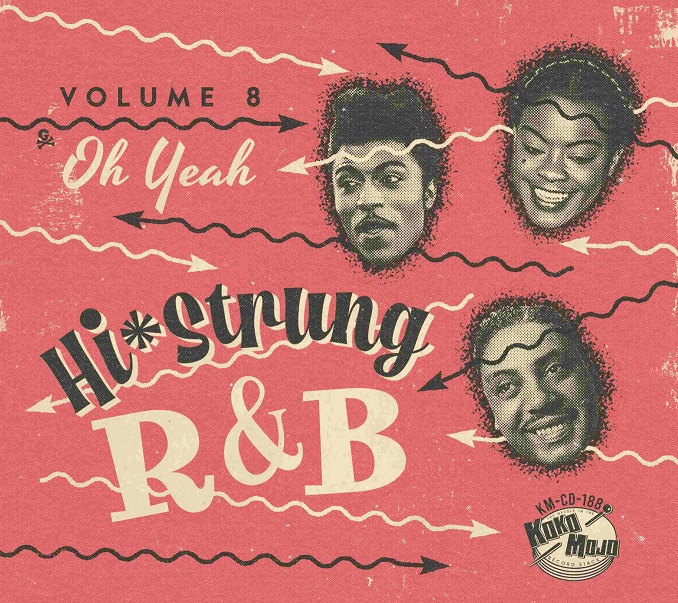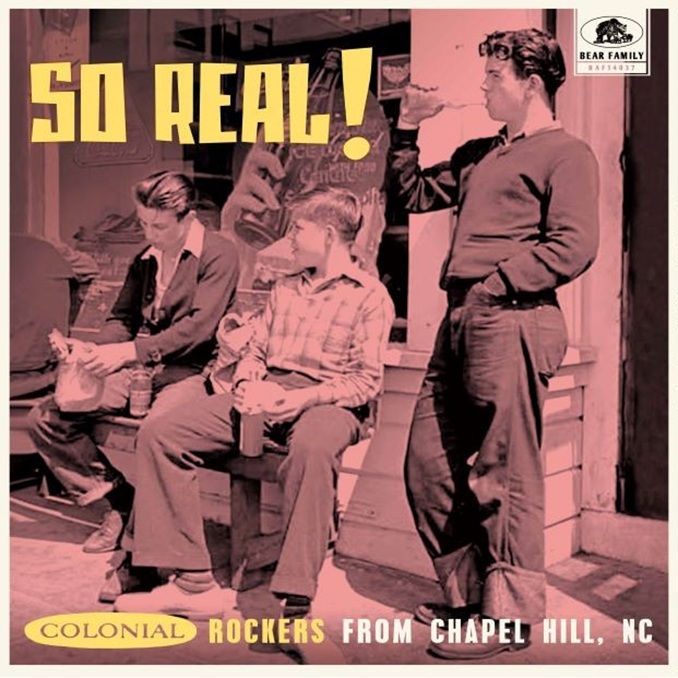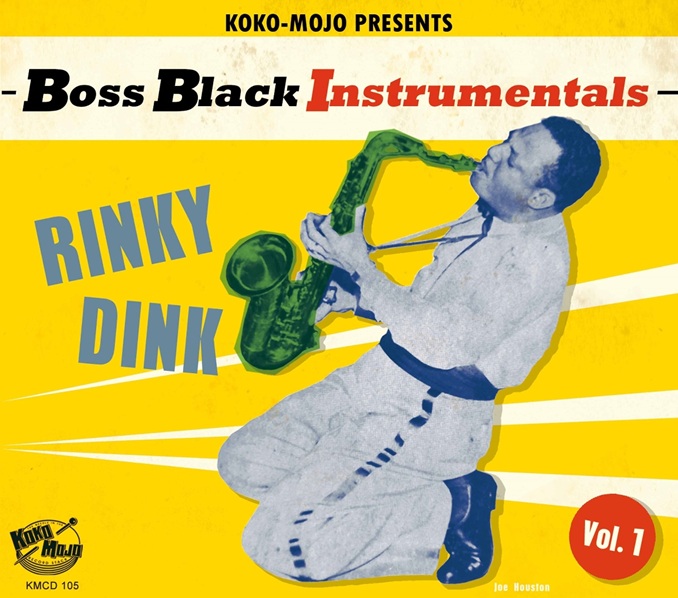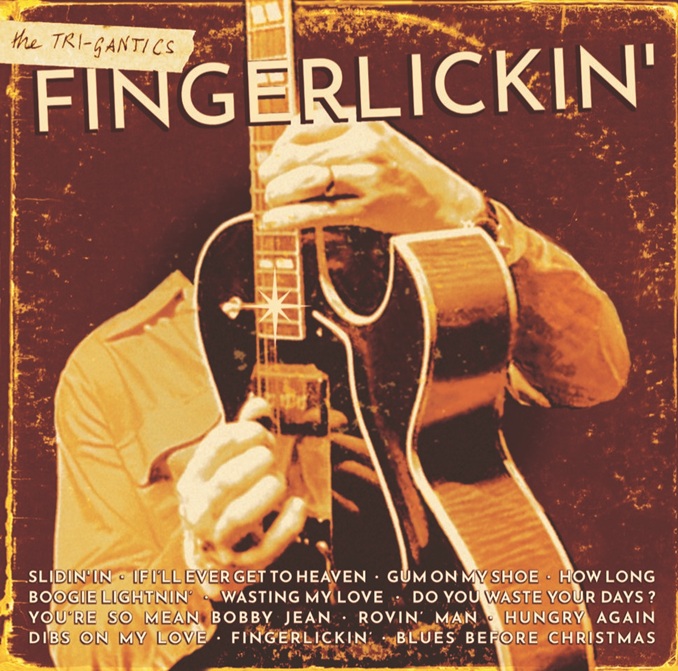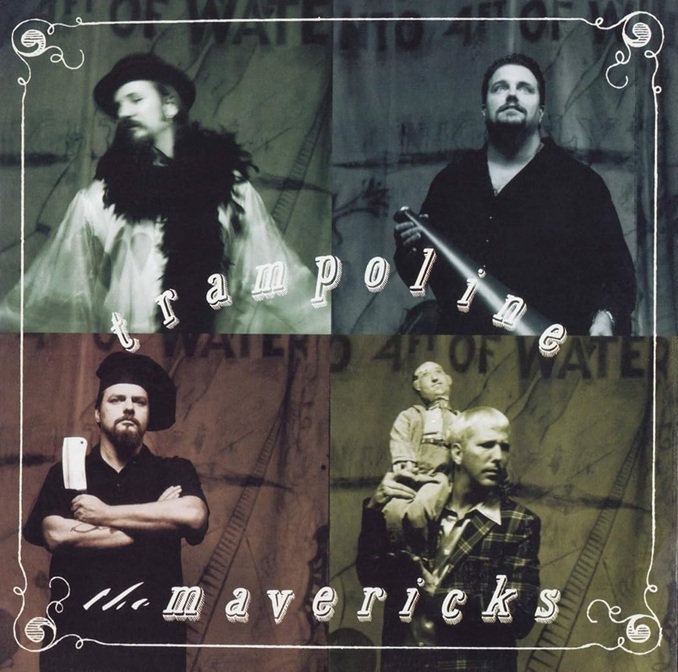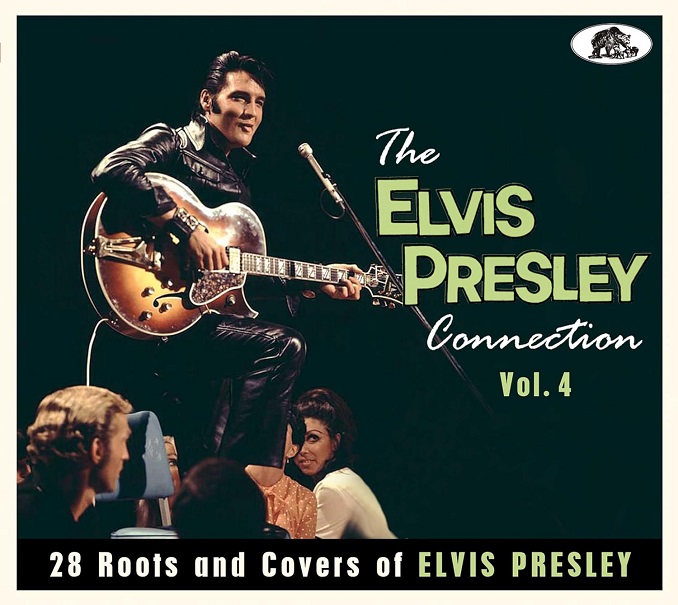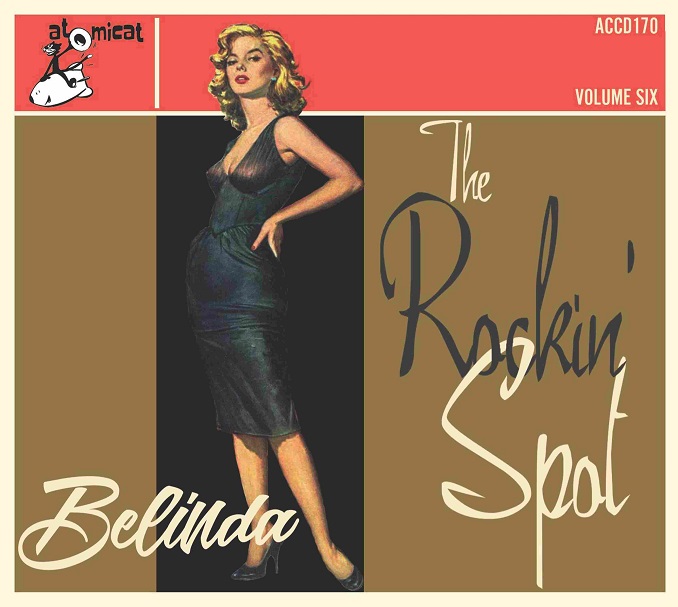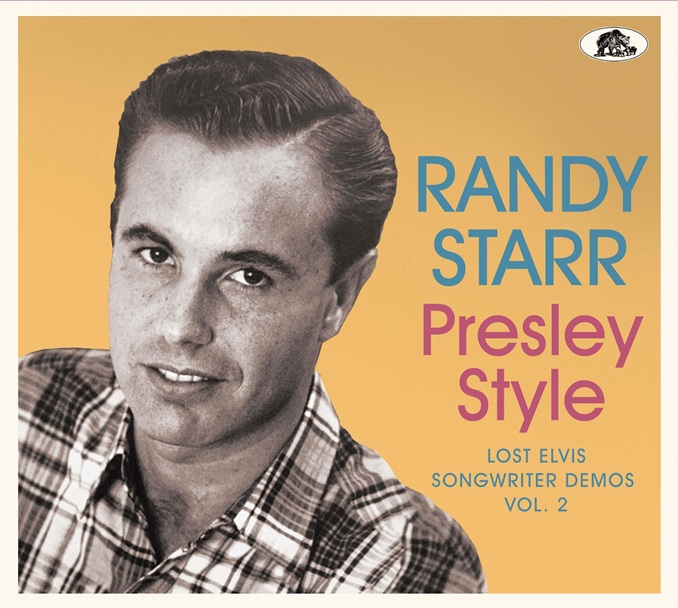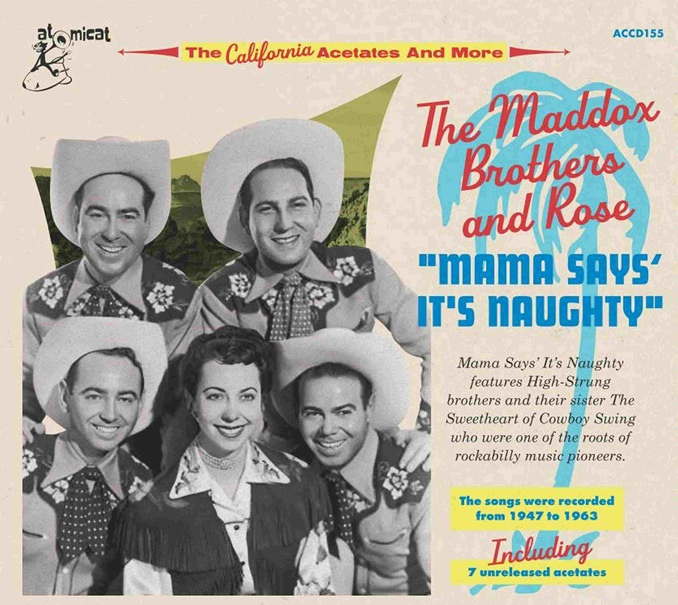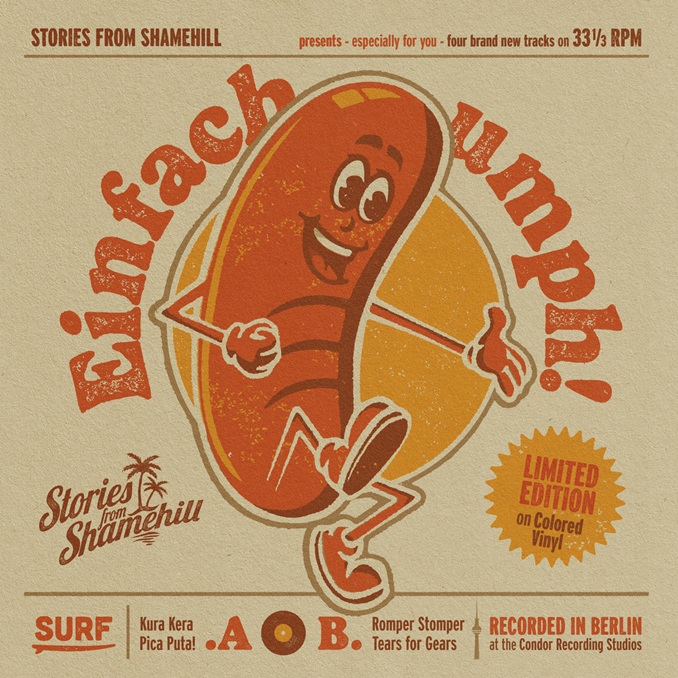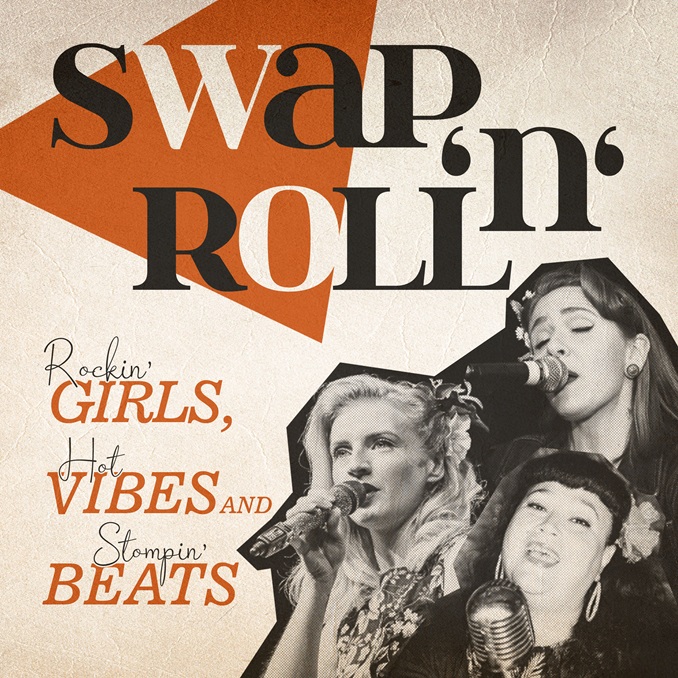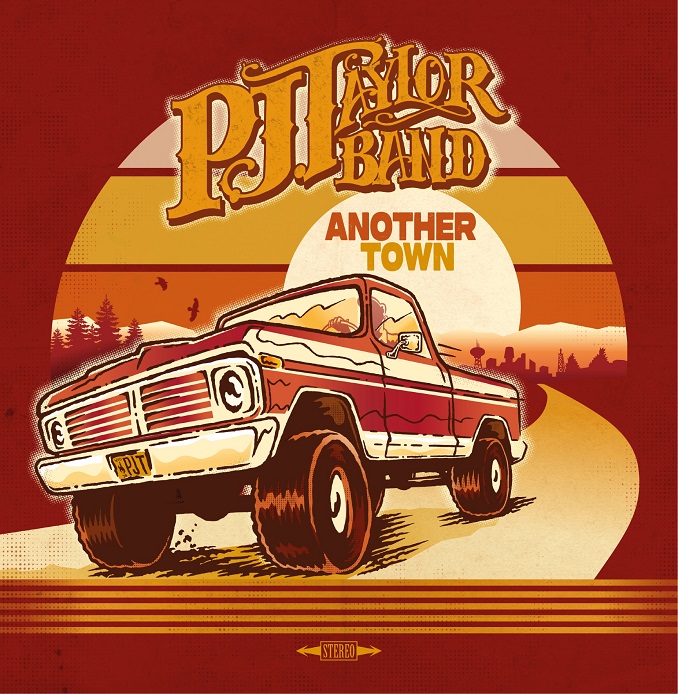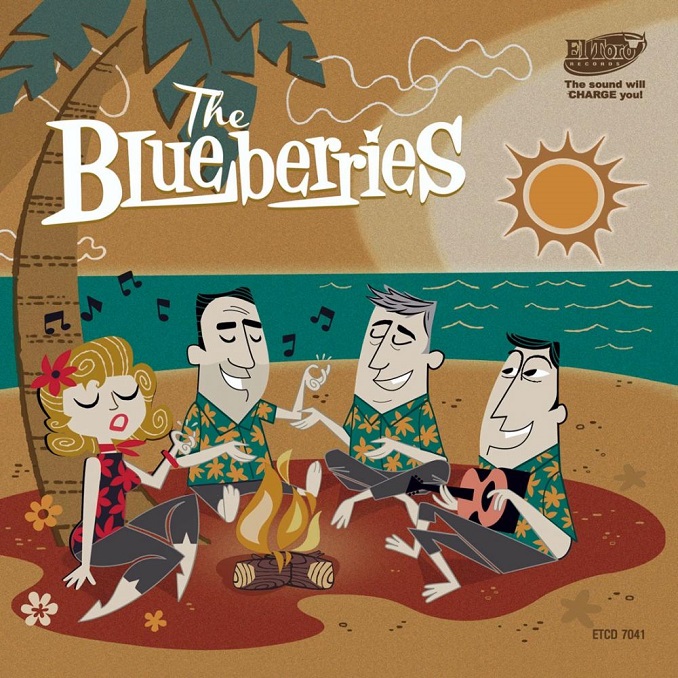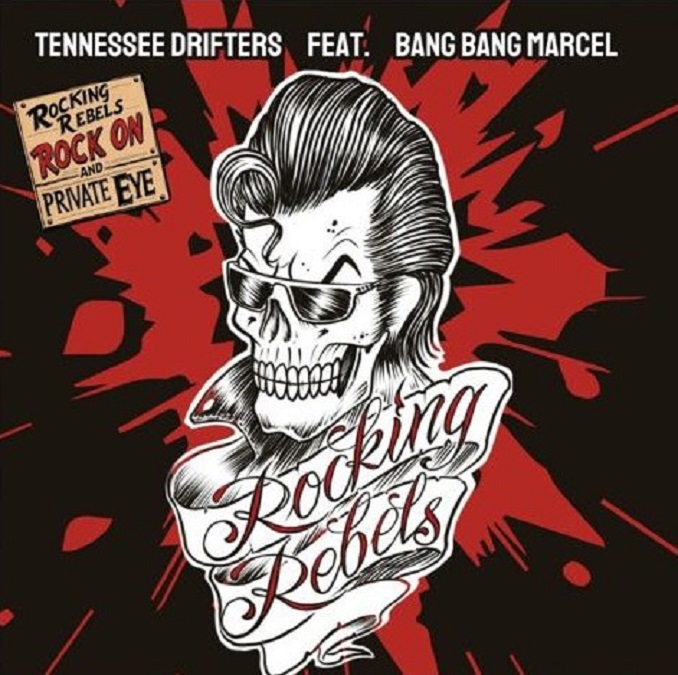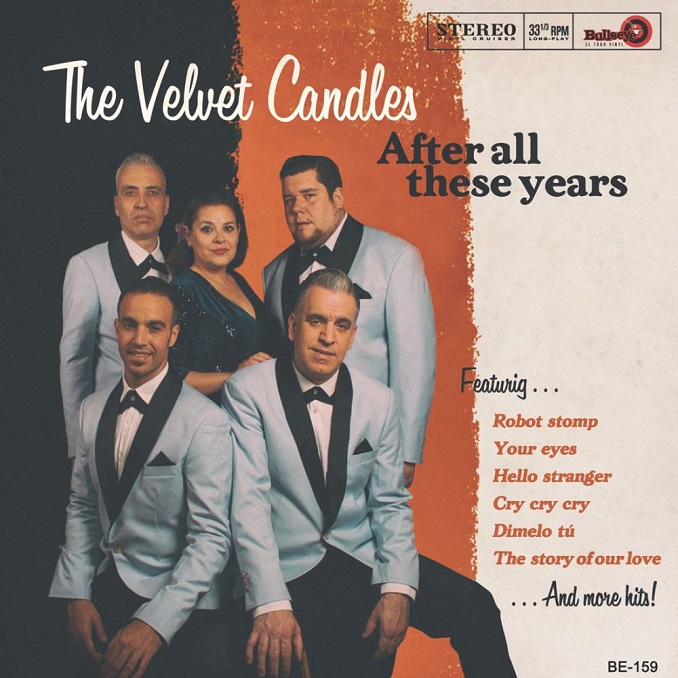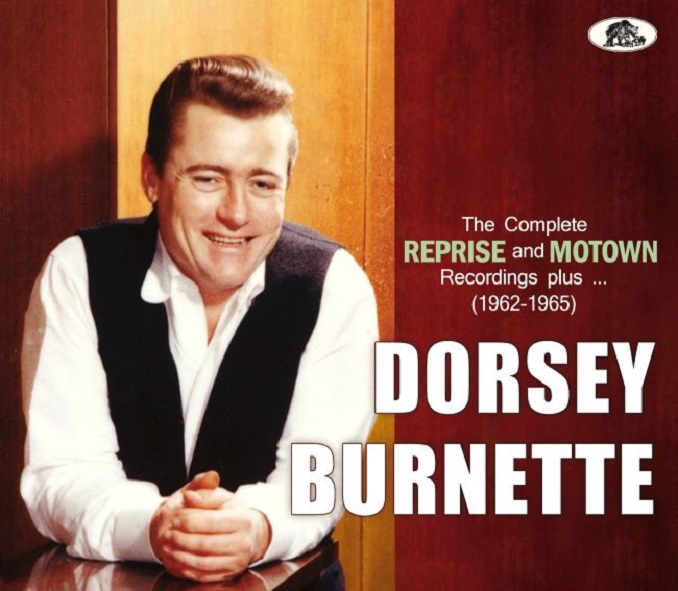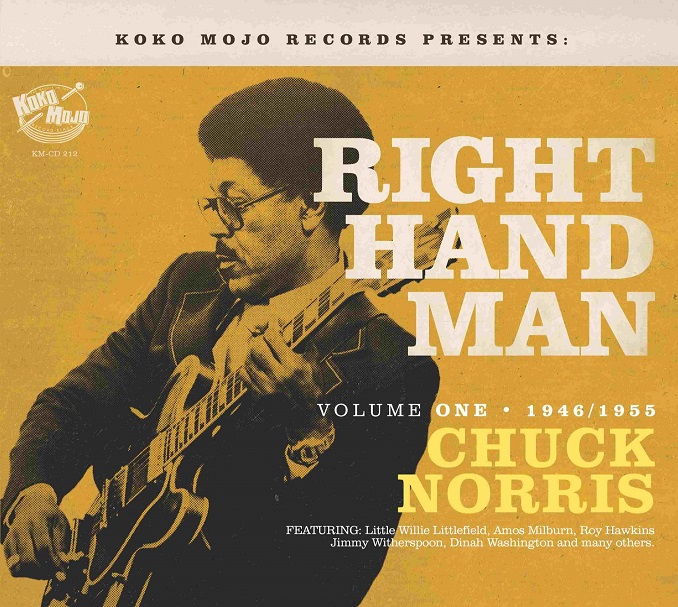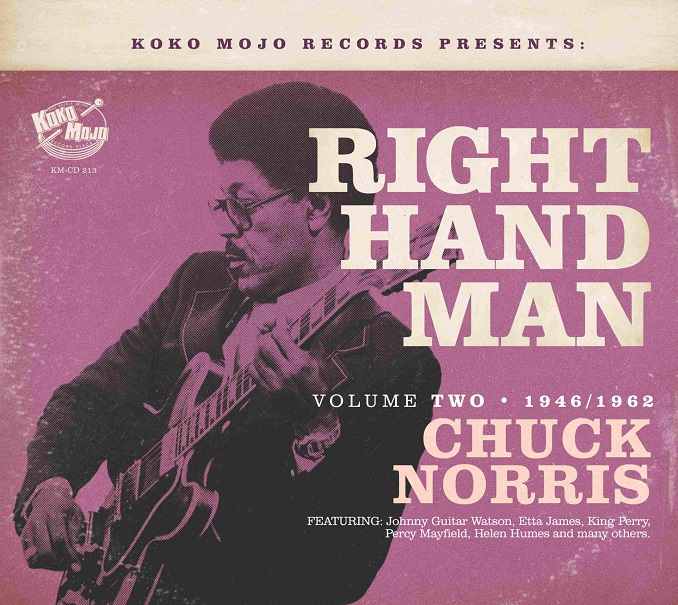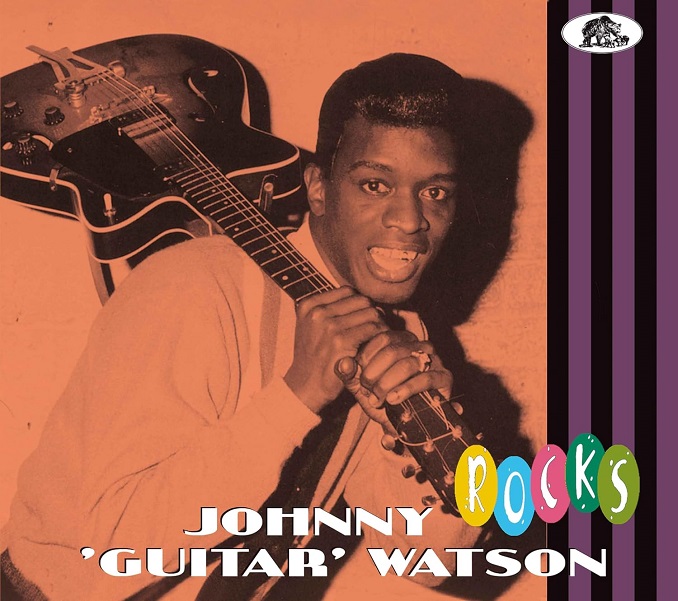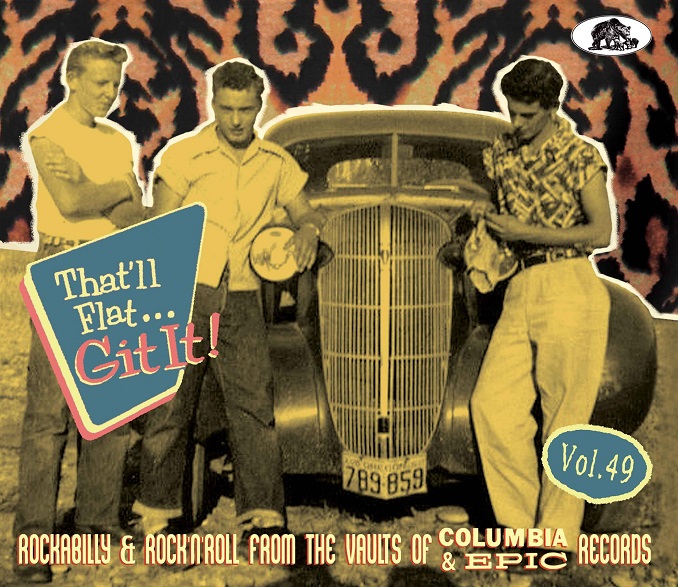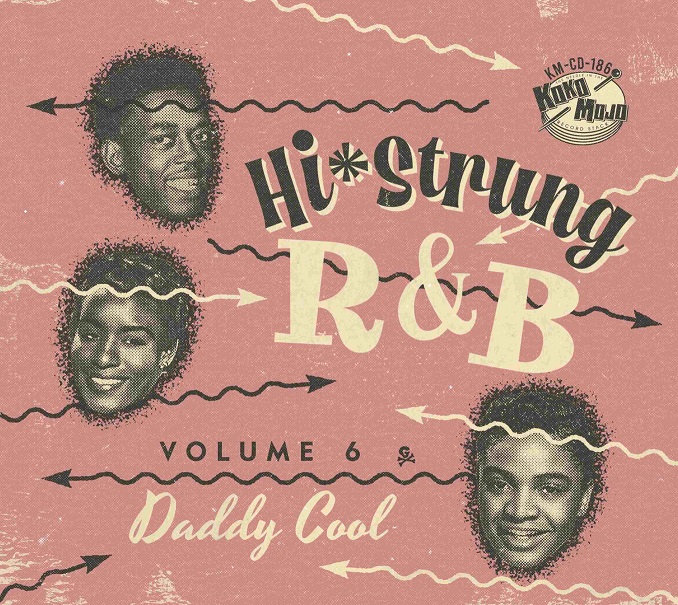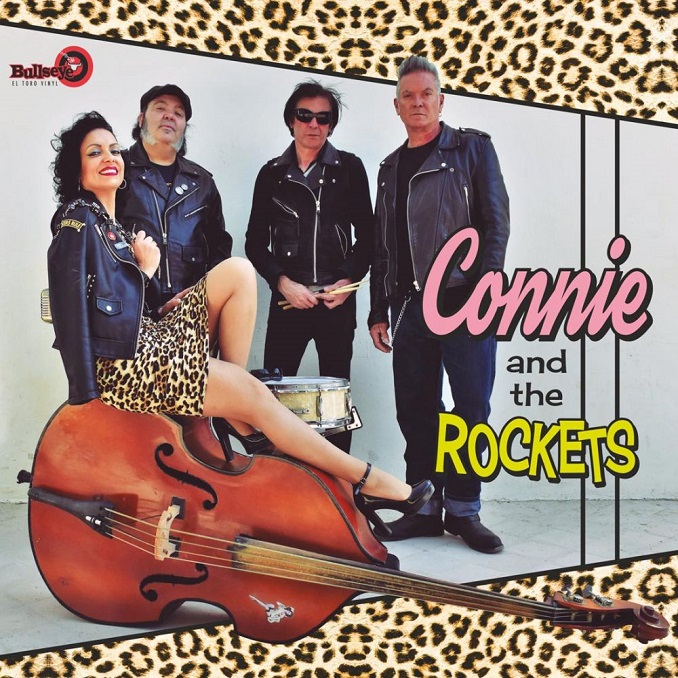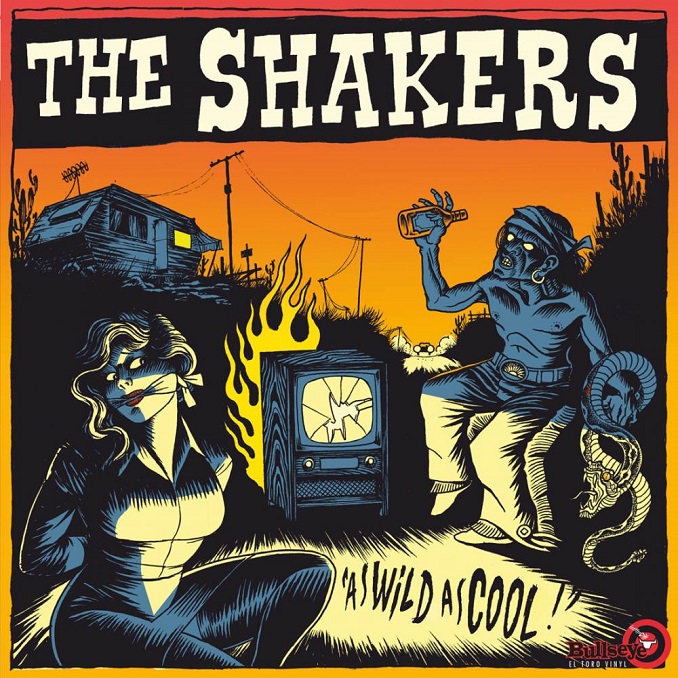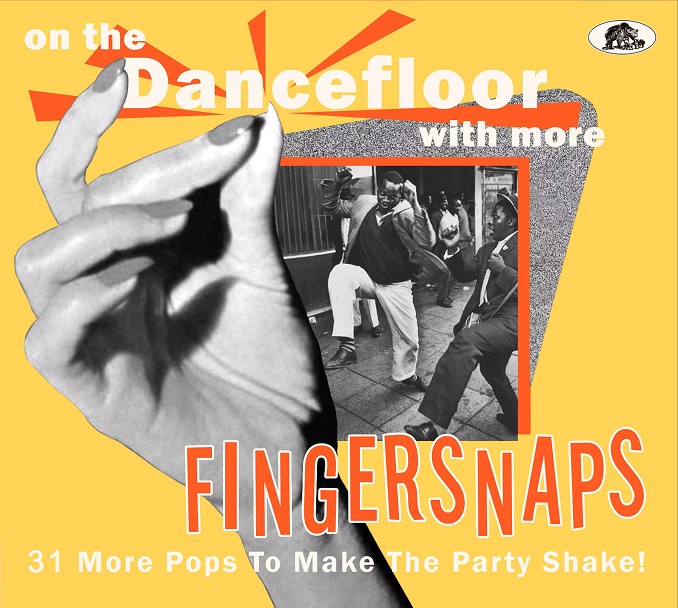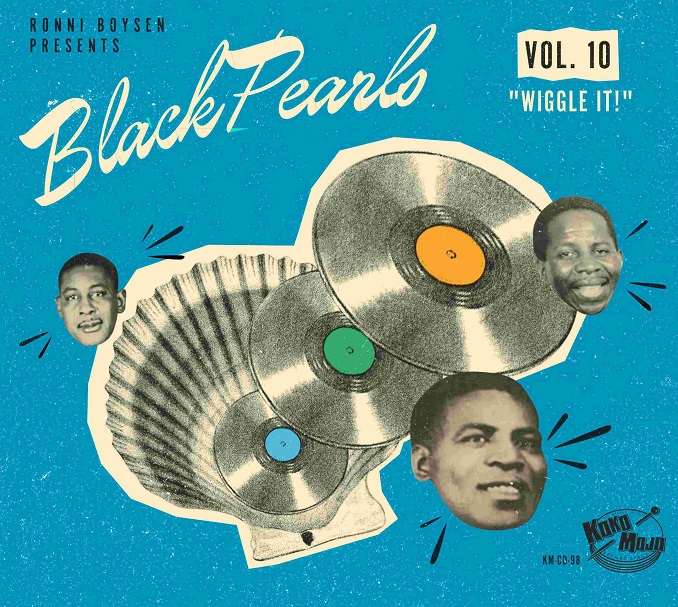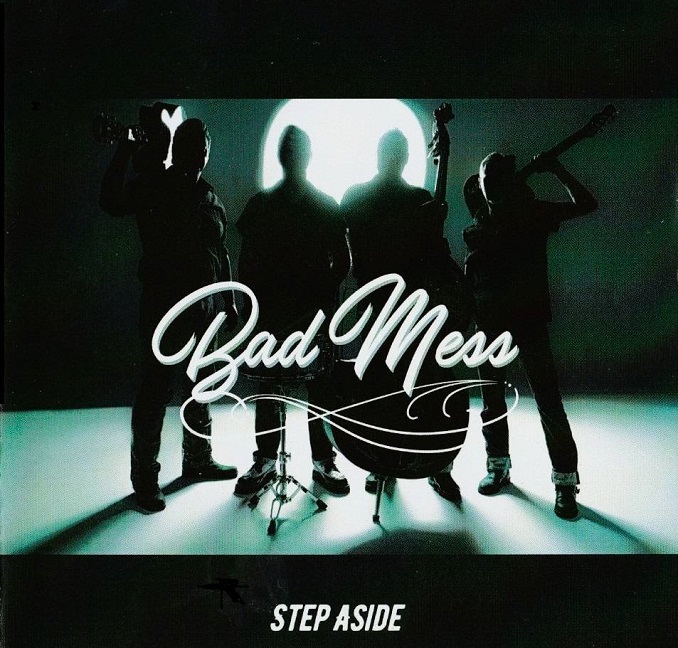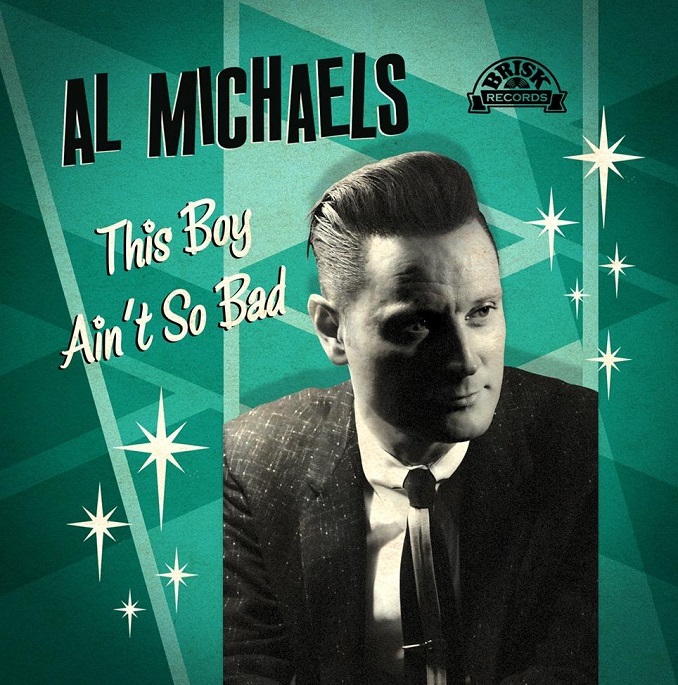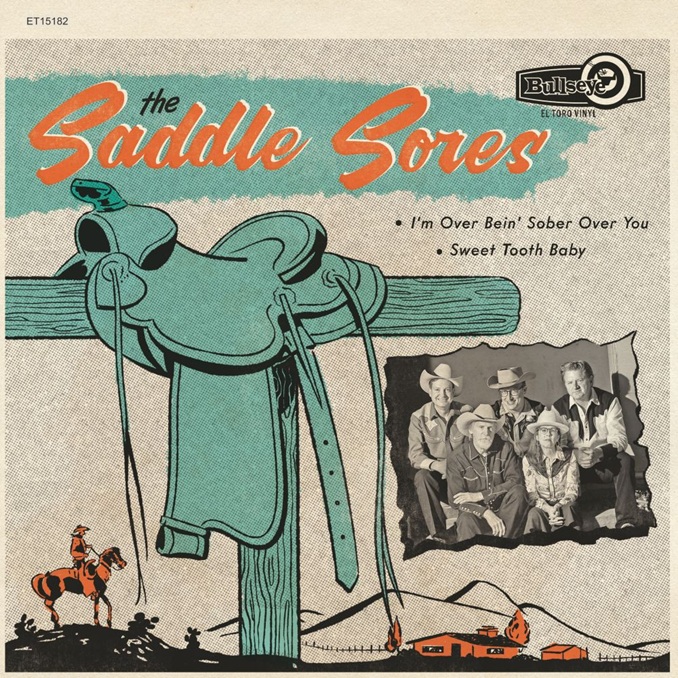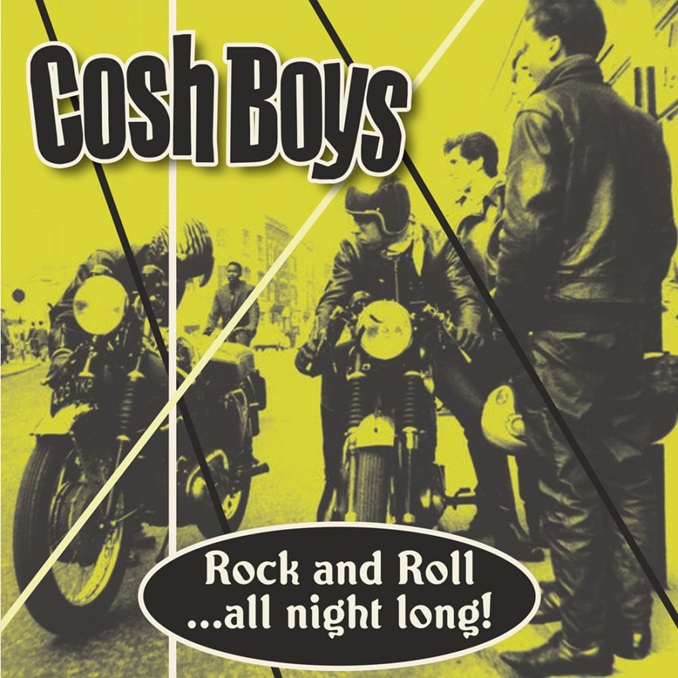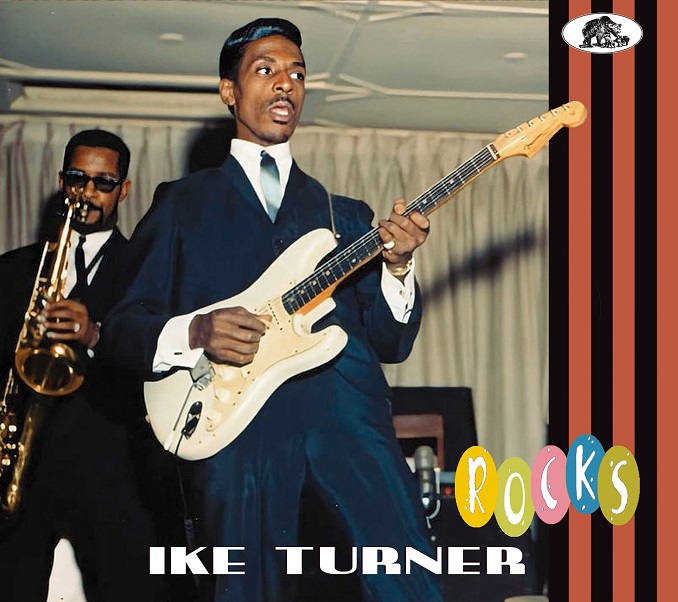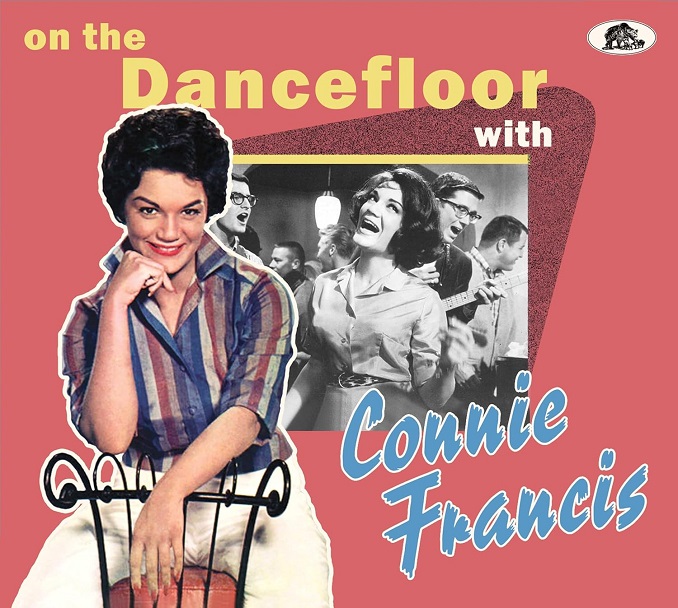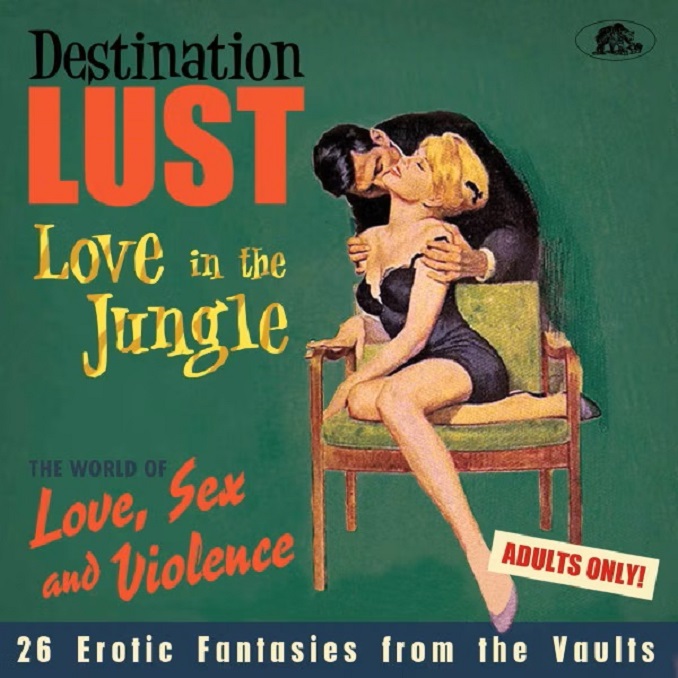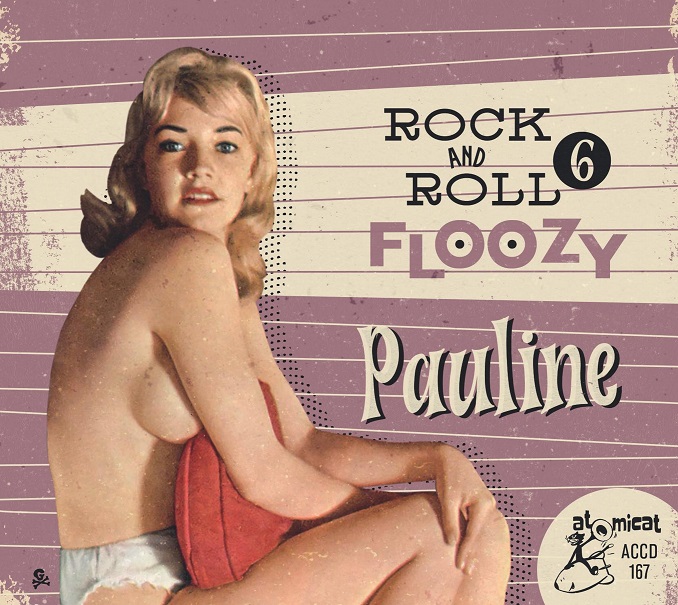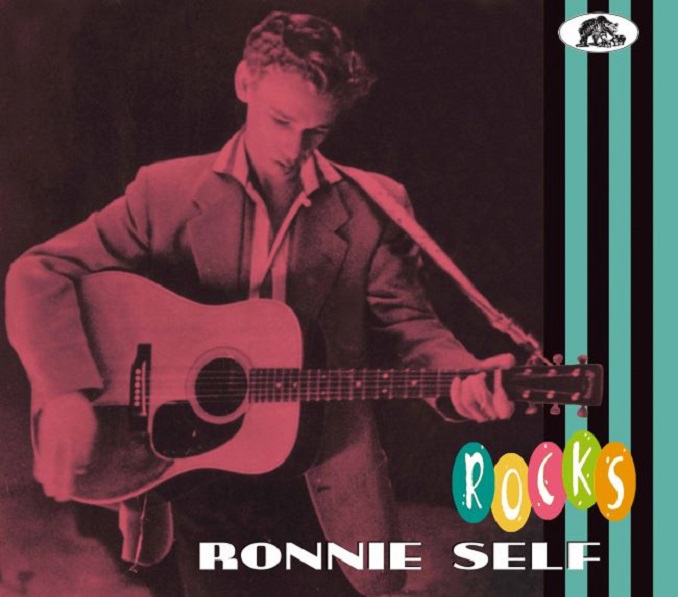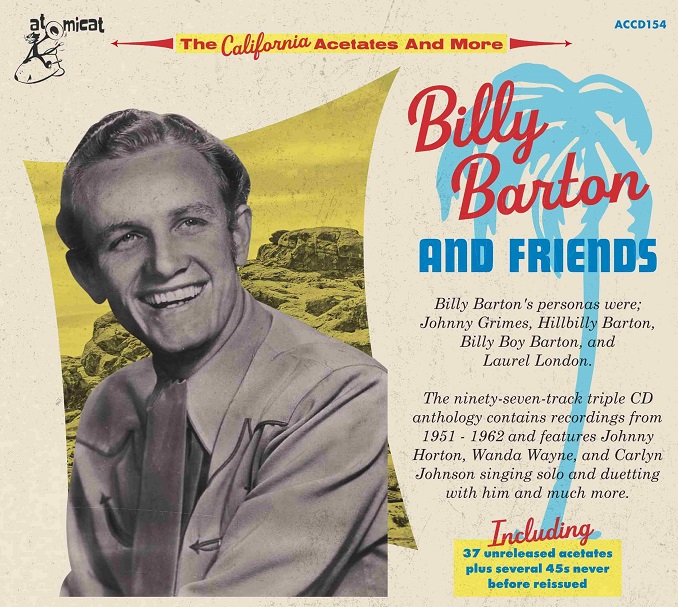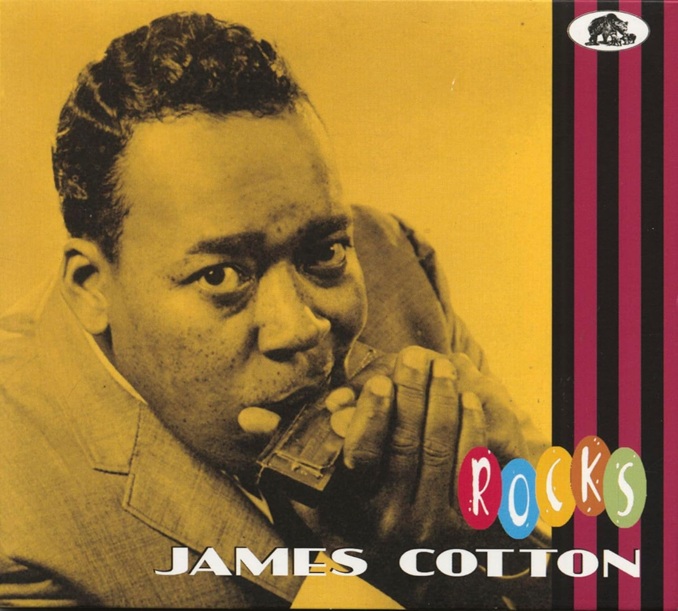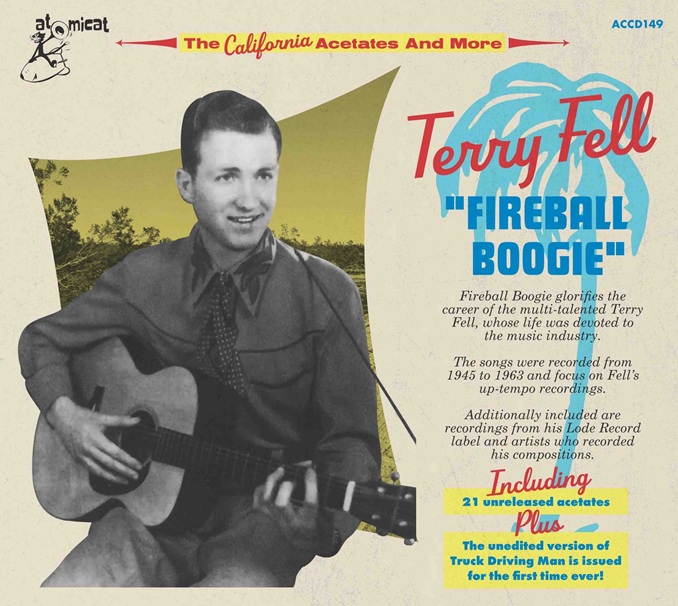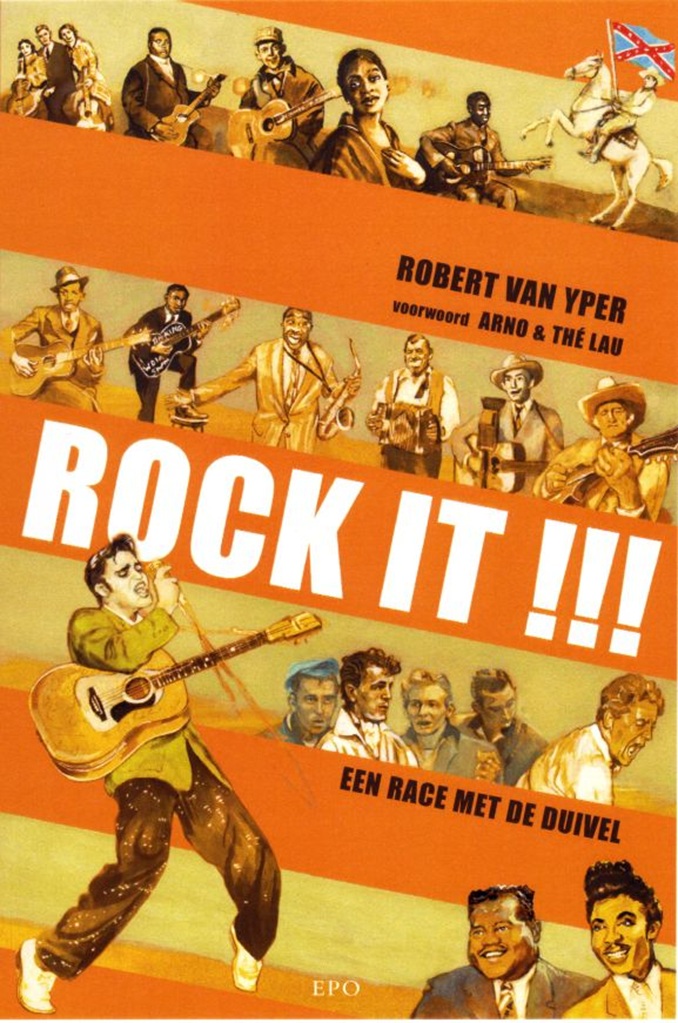
Je
recente release (muziek, boek of wat dan ook) gerecenseerd op onze website?
Stuur deze dan naar de hoofdredactie! |
26 juni
2025
![]()
Vinyl Recensie
| OOH-EEE
Deze individueel genummerde vinyl 10 inch (wij hebben nummer 409/500)
met "rockers and country boppers from Atlanta" kan je beschouwen
als een zijpad van Bear Family's That'll Flat Git It reeks, want de
twaalf tracks zijn allemaal afkomstig van hetzelfde label, Stars Inc,
dat slechts bestond van 1955 tot 1957. Het is mij niet bekend of er
genoeg Stars Inc materiaal zou zijn voor een volledige Flat Git It
CD. Het dozijn nummers op deze 10 inch is in ieder geval de moeite
waard, zij het zeker niet je standaard rock 'n' roll. Het bekendste
nummer met een link naar Stars Inc staat niét op de 10 inch,
want dat was Young Love, de ballade die een gigahit werd in de coverversie
van Sonny James, in de originele uitvoering door Ric Cartey. Het bekendste
nummer op de 10 inch en daarmee ook de bekendste rock 'n' roll song
op Stars Inc, al is dat uiteraard relatief, was de B-kant van Ric
Cartey's Young Love, de swampy rockabilly Oooh-Eee van Ric Cartey,
maar over de 10 inch hangt voor een stuk de schaduw van gitarist Jerry
Reed, de componist van Oooh-Eee tien jaar voor hij bekend werd toen
Elvis zijn Guitar Man en US Male coverde en twintig jaar voor hij
in de Burt Reynolds film Smokey And The Bandit het nummer East Bound
And Down zong. Reed heeft zelf nooit iets uitgebracht op Stars Inc
(jammer, denk aan zijn fantastische rockabilly single When I Found
You op Capitol) maar schreef wel twee van de twaalf nummers hier,
of zo u wilt vier, want van beide staan hier twee versies op, te beginnen
met een tweede Oooh-Eee die de originele Ooh-Eee (What You Do To Me)
blijkt door Chuck Atha, een snellere en hele toffe bopabilly springer,
gezongen met een hoge stem en ingespeeld met een al even hoge gitaar.
Op de twee versies speelt Jerry Reed gitaar. Nog hoger dan Chuck Atha
klinkt I'm Wise To You Now van Judy Tolbert die inderdaad klinkt als
het kindje dat ze toen was, met een frasering die wat lonkt naar Brenda
Lee. Volgens het label van de single was ze toen amper, volgens de
liner notes van Bill Dahl in de bijgestoken folder van tien paginas
op formaat 20 op 20 cm is dertien of veertien jaar waarschijnlijker.
De gitaarsound op I'm Wise To You Now is vergelijkbaar met Atha's
Ooh-Eee, maar de stijl, een uptempo erg bluesy stroller, is helemaal
anders. Een tragere en zelfs nog bluesier stroll is het tweede door
Jerry Reed gecomponeerde nummer, de gitaar instrumental Rock Bottom
# 1 van The Rockateers die wat doet denken aan Eddie Cochran's blues
workouts maar opvalt door de semi-akoestische gitaar (een metalen
National dobro?) en ouderwetser klinkt dan 1957 door de contrabas
en de piano. Muzikaal is de sound te vergelijken met Ric Cartey's
Oooh-Eee. Misschien dezelfde muzikanten? Aangezien Jerry Reed het
schreef ga ik ervan uit dat hij de gitarist is, wat de vraag oproept
op hoeveel andere Stars Inc opnames hij nog heeft gitaar gespeeld.
Wie zal het zeggen? Rock Bottom # 2 heeft een vollere sound met nu
de piano in de hoofdrol. Ook het deinende medium tempo You're My Baby
van The Night Hawks heeft een bluesy inslag in de gitaar.
This
individually numbered 10 inch (we have # 409/500) featuring “rockers
and country boppers from Atlanta” could be considered the vinyl
equivalent of Bear Family's That'll Flat Git It series as the twelve
tracks are all from the same label, Stars Inc, which only existed
from 1955 to 1957. I don't know if there is enough Stars Inc material
for a entire Flat Git It CD, but at any rate the dozen songs on the
10 inch are worth your while, albeit certainly not standard rock ‘n’
roll. The most famous song linked to Stars Inc is not on the 10 inch,
for that was Young Love, the ballad that became a huge hit in the
cover version by Sonny James, while the original recording was by
Ric Cartey on Stars Inc. The most famous rock 'n' roll song on the
10 inch and therefor the most famous rock ‘n’ roll song
on Stars Inc, even though that is of course relative, was the flip
of Ric Cartey's Young Love, the swampy rockabilly Oooh-Eee, yet the
entire 10 inch is haunted by the presence of guitarist Jerry Reed
who wrote Oooh-Eee ten years before becoming a household name when
Elvis covered his Guitar Man and US Male and twenty years before he
sang the song East Bound And Down in the Burt Reynolds movie Smokey
And The Bandit. Reed never released anything himself on Stars Inc
(pity, remember his fantastic rockabilly 45 When I Found You on Capitol)
but he did write two of the twelve songs here, or four if you will,
as there are two versions of each on here, starting with a second
Oooh-Eee that turns out to be the original Ooh-Eee (What You Do To
Me) by Chuck Atha, a faster and pretty cool bopabilly jumper, sung
in a high pitched voice and played with an equally high pitched guitar.
On both versions it's Jerry Reed bending the strings. Even higher
than Chuck Atha sounds I'm Wise To You Now by Judy Tolbert who indeed
sounds like the child she was, with a phrasing that reminds us a bit
of Brenda Lee. According to the 45's label she was barely then - according
to Bill Dahl's liner notes in the ten page 20x 20 cm sized folder
thirteen or fourteen is more likely. The guitar sound on I'm Wise
To You Now is similar to Atha's Ooh-Eee, but the style, an uptempo
very bluesy stroller, is completely different. A slower and even bluesier
stroll is the second Jerry Reed composition, a guitar instrumental
titled Rock Bottom # 1 by The Rockateers that is somewhat reminiscent
of Eddie Cochran's blues workouts but stands out because of the semi-acoustic
guitar (a metal National dobro?) and sounds more old-fashioned than
1957 because of the double bass and piano. Musically the sound is
similar to Ric Cartey's Oooh-Eee, so perhaps it's the same musicians?
Since Jerry Reed wrote it I assume he's the guitarist, which raises
the question of how many other Stars Inc recordings he played guitar
on. Who's to say? Rock Bottom # 2 has a fuller sound now with the
piano in the lead. The Night Hawks' swaying medium tempo You're My
Baby also has a bluesy slant in the guitar playing. |
![]()
CD Recensies
| ROCKIN'
COUNTRY STYLE VOLUME 1
Een
nieuwe lente maar geen nieuw geluid, oude wijn in nieuwe zakken of
iets van die strekking, met dien verstande dat goeie wijn beter wordt
met de jaren. De titel van deze nieuwe Atomicat reeks zegt waar het
op staat: niet alleen rock 'n' roll diep verankerd in de country maar
vooral country die je met wat goeie wil rockend kan noemen. Curley
Millikin & the Sundowners' opener Rock And Roll Country Boy is
gewoon een rocker met piano, beschaafde achtergrondkoortjes en een
gitaarintro die me doet denken aan een ander obscuur nummer, Rock
'n' Roll On A Saturday Night van Dwain Bell & the Turner Brothers.
Billy Walker was een bekende countryzanger en zijn WhirLPool is gestroomlijnde
medium tempo country swing boogie met jankende steel gitaar. Uiteraard
staat hier nog meer van die gestroomlijnde country swing op, zoals
That'll Be Love van Glenn Reeves die trouwens ooit een nummer opnam
getiteld Rockin' Country Style maar dat staat dan weer niet op de
CD. Een nog grotere ster dan Billy Walker was Eddy Arnold die op z'n
Perry Como best wellicht hoopte wat tienerzakgeld in de wacht te slepen
door een proper alternatief voor rock 'n' roll aan te bieden in de
vorm van zijn beschaafde stroll Crazy Dream. Johnny Duncan, de man
van Last Train To San Fernando, is evenmin onbekend, en zijn That's
All Right Darlin' hier klinkt heel jazzy met bongo'tjes en flashy
Les Paul-achtig werk op de gitaar. De Nellie Lutcher cover He's A
Real Gone Guy van Anita Carter, de zus van June Carter, in essentie
hele snelle country met supersonische steel gitaar, zou probleemloos
op een CD met female rockers kunnen staan. Simon Crum was het comedy
pseudoniem waaronder Ferlin Husky novelty gerichte nummers opnam,
en Stand Up Sit Down Shut Your Mouth was een duidelijk op de tiener
rock 'n' roll markt mikkende stroll. De stem van Johnny Bond herken
je uit duizenden, en op Sale Of Broken Hearts zette hij zijn rockendste
Johnny Cash beentje voor. Er is gezapige boppin' hillbilly in de vorm
van Lee Bonds' Done Gone Crazy met een jazzy trompetje en honky tonk
piano, two-step countrybilly (You Done Got Me van Eddie Noack) en
een humoristisch hick duet met Hillbilly Wedding van Shorty Long &
Dolly Dimple, in essentie een squaredans. Red Hays vermengt ingrediënten
uit gospel, bluegrass en fingerpicking tot Doggone Woman, en Mitchell
Torok vormt Chuck Berry's blues stop-starter No Money Down om tot
country. Ik had bijna geschreven dat The Half Brothers Bird Dog van
The Everly Brothers maar half zo goed coveren, maar dat zou een flauwe
woordspeling zijn. Laat ik het gewoon houden op een meer landelijke
versie. Billy Starr's rhythm 'n' blues-achtige Hound Dog is geïnspireerd
op Big Mama Thornton in plaats van op Elvis om de eenvoudige reden
dat hij het opnam vóór Elvis. Texas Bill Strength speelt
Cry Cry Cry sneller dan Johnny Cash en geeft het nummer in tegenstelling
tot de spaarzame Cash sound een full band backing met piano, elektrische
boogie gitaar en steel - het resultaat is kermismuziek. Dave Edge
had duidelijk goed geluisterd naar White Lightning toen hij Wham Bam
opnam, net als James O'Gwynn voor zijn soepele jiver Easy Money. Een
van de top western swing klassiekers is Chew Tobacco Rag, nummer waarvan
ik de eerste slechte versie nog moet tegenkomen. Spade Cooley houdt
de pruimtabak traditie hoog en mikt 'em netjes in de kwispedoor. Moon
Mullican's Country Boogie is, euh, een country boogie, al had Instrumental
Country Boogie Woogie net ietsje completer, zij het minder kernachtig
geweest. Traditioneler, zeg maar gerust ouderwetser, zijn het oudere
of in elk geval ouder klinkende Knock It Off van Eddie Hill, Leo Ogletree's
krakkemikkig krakende Crooked Dice, Tommy Hill's trage tearjerker
Mr. Jukebox, de gitaarboogie Stomp That Thing van Louie Innis &
the String Dusters, de shuffelende western swing stop-starter Rattle
Snakin' Daddy van Boots Woodall & his Radio Wranglers en Buffalo
Johnson & his Melody Rangers' semi-akoestische countryblues gitaarpicker
Something Within Me (Is Telling On You) uit 1947, de oudste track
op de CD. Jim Fair's budget Eddy Arnold cover Hepcat Baby zal eerder
gesmaakt worden door wie graag een walsje danst dan door de gemiddelde
hepcat, net zoals Lucky Joe Almond & his Hillbilly Rockers' medium
tempo Gonna Roll And Rock eerder een showcase voor hillbilly's piano
roots is dan rock 'n' roll. Nog ouder klinkt het puur jaren '30 gejodel
van Charlie Duke's Jimmie Rodgers cover California Blues dat ouder
lijkt dan het vermelde jaartal 1952. New
season doesn't mean new music, old wine in new bottles, something
along those lines anyway, with the understanding that good wine gets
better with age. The title of this new Atomicat series is exactly
what you get: not only rock ‘n’ roll deeply rooted in
country music but also and mostly country music that with some goodwill
gesture can be labelled rockin'. Curley Millikin & the Sundowners'
opening track Rock And Roll Country Boy is basicly a rocker with piano,
civilized background vocals and a guitar intro that reminds me of
another obscure song, Rock ‘n’ Roll On A Saturday Night
by Dwain Bell & the Turner Brothers. Billy Walker was a well known
country singer and his WhirLPool is slick medium tempo country swing
boogie with a crying steel guitar. Obviously there's a lot more streamlined
country swing to be enjoyed here like That'll Be Love by Glenn Reeves
who incidentally at one point recorded a song titled Rockin' Country
Style which is not on the CD. Eddy Arnold's star shone even brighter
than Billy Walkers and het tried his Perry Como best hoping to rake
in some teenage pocket change by offering a clean alternative to rock
‘n’ roll with his civilized stroll Crazy Dream. Johnny
Duncan, the Last Train To San Fernando man, is no stranger either,
and his That's All Right Darlin' here sounds very jazzy with bongos
and flashy Les Paul styled guitar fills. The Nellie Lutcher cover
He's A Real Gone Guy by Anita Carter, June Carter's sister, essentially
very fast country with supersonic steel guitar, could easily be placed
on a CD of female rockers. Simon Crum was the comedy alter ego Ferlin
Husky used to record novelty songs, and Stand Up Sit Down Shut Your
Mouth was a stroll clearly aimed at the teenage rock ‘n’
roll market. You can recognize Johnny Bond among a thousand voices
and on Sale Of Broken Hearts he put his rockinest Johnny Cash foot
down. There's easy going boppin' hillbilly in the form of Lee Bonds'
Done Gone Crazy with a jazzy trumpet and honky tonk piano, two step
country billy (Eddie Noack's You Done Got Me) and a humorous hick
duet with Shorty Long & Dolly Dimple's Hillbilly Wedding, essentially
a squared dance. Red Hays blends ingredients from gospel, bluegrass
and fingerpicking into Doggone Woman, and Mitchell Torok turns Chuck
Berry's blues stop-starter No Money Down into country. I almost wrote
that The Half Brothers covered The Everly Brothers' Bird Dog only
half as good, but that would be a very lame pun, so let me refrase
that as more of a country version. Billy Starr's rhythm ‘n’
blues-like Hound Dog is inspired by Big Mama Thornton rather than
by Elvis for the simple reason that he recorded it before Elvis. Texas
Bill Strength plays Cry Cry Cry faster than Johnny Cash and avoiding
the sparse Cash sound gives the song a full band backing with piano,
electric boogie guitar and steel, turning it into merry-go-round music.
Dave Edge clearly had been listening carefully to White Lightning
when he recorded Wham Bam, as did James O'Gwynn for his smooth jiver
Easy Money. One of the ultimate western swing classics is Chew Tobacco
Rag, a song I haven't come across any bad version so far. Spade Cooley
upholds the chewing tradition and spits 'em neatly in the spittoon.
Moon Mullican's Country Boogie is, err, a country boogie, though Instrumental
Country Boogie Woogie would have been just a tad more complete, albeit
less catchy title. More traditional, read: more old-fashioned, are
Eddie Hill's older or at least older sounding Knock It Off, Leo Ogletree's
squeaky Crooked Dice, Tommy Hill's slow tearjerker Mr. Jukebox, Louie
Innis & the String Dusters' guitar boogie Stomp That Thing, Boots
Woodall & his Radio Wranglers'western swing stop-starter shuffle
Rattle Snakin' Daddy, and Buffalo Johnson & his Melody Rangers'
semi-akoestic countryblues guitar picker Something Within Me (Is Telling
On You) from 1947, the oldest track on the CD. Jim Fair's budget Eddy
Arnold cover Hepcat Baby is more likely to be enjoyed by those who
like to waltz than by the average hepcat, just as Lucky Joe Almond
& his Hillbilly Rockers' medium tempo Gonna Roll And Rock is more
a showcase for hillbilly's piano roots than rock ‘n’ roll.
Even older sounds the 1930s yodeling of Charlie Duke's Jimmie Rodgers
cover California Blues which appears to be older than the listed year
1952. |
11 juni 2025
![]()
| HEADIN'
FOR THE POORHOUSE
Oh,
de ironie: plaatjes kopen over arm zijn! Of misschien niet eens zó
gek, want liedjes gaan over de gevoelens des mensen en dus ook over
miserie, en als er één ding miserie is dan is het wel
het gebrek aan poen, duiten, noppen, ping ping, jak. Deze CD bevat
30 tracks 1947-1967 over geld en vooral over het gebrek daaraan zoals
bijvoorbeeld de doo-woppers Headin' For The Poorhouse van The Silhouettes,
Money Talks van The Penguins op stroll tempo met een priemende rhythm
'n' blues gitaarsolo en Money Money Money van Freddie Carpenter &
the Rookies. Die Freddie Carpenter zou later als Freddie North in
1961 de single Don't Make Me Cry/ Someday She'll Come Along uitbrengen
op Sun sublabel Phillips International, twee nummers die je niet meteen
herkent als Sun: het eerste is vroege soul à la Jackie Wilson
en Jimmy Jones, het tweede een bolero waarin Carpenter/North klinkt
als een zwarte Brook Benton versie van Roy Orbison - maar dit geheel
terzijde. Meer bluesgetinte opnames zijn het uptempo jazzy swingende
I Ain't Got No Money, in 1953 de debut 78 van Billy (Boy) Arnold (het
is Arnold's mondharmonica die het tot blues maakt), de beschaafde
blues swing No Money van Johnny Ace in 1954 de B-kant van Ace's hitballade
Pledging My Love, Slim Harpo's funky bluesrocker I Need Money (Keep
Your Alibis) uit 1964 en de trage piano blues Broke And Hungry van
Sunnyland Slim onder het pseudoniem Dr. Clayton's Buddy met Big Bill
Broonzy op gitaar. Het kan altijd erger: Jimmy Witherspoon is niet
alleen platzak en hongerig maar bovendien dronken in Drunk Broke And
Hungry, een snellere piano boogie. En wat brachten al die muziekjes
voort? Wilde zwarte rock 'n' roll natuurlijk, zoals Ain't Got No Money
van The Great Gates dat in 1952 al rockte als de beesten.
Oh,
the irony: buying records about being poor! Or maybe it's not that
odd, for songs tell stories about feelings and thus also about misery,
and if there's one thing that spells misery it is the lack of money,
dough, bucks, bacon, bread. This CD contains 30 tracks 1947-1967 about
money and especially the lack thereof such as for example the doo-woppers
Headin' For The Poorhouse by The Silhouettes, Money Talks by The Penguins
at a strolling tempo with a piercing rhythm 'n' blues guitar solo
and Money Money Money by Freddie Carpenter & the Rookies. In 1961
Carpenter would release a 45 titled Don't Make Me Cry/ Someday She'll
Come Along on Sun sublabel Phillips International as Freddie North
with two songs that you don't identify as Sun: the first one is early
soul à la Jackie Wilson and Jimmy Jones, the second a bolero
in which Carpenter/North sounds like a black Brook Benton version
of Roy Orbison - but this is entirely beside the point here. More
blues tinged recordings are the uptempo jazzy swinging I Ain't Got
No Money, the 1953 debut 78 by Billy (Boy) Arnold (it's Arnold's harmonica
that makes it blues), the civilized blues swing No Money, in 1954
the B-side of Johnny Ace's hit ballad Pledging My Love, Slim Harpo's
funky blues rocker I Need Money (Keep Your Alibis) from 1964 and the
slow piano blues Broke And Hungry by Sunnyland Slim using the nom
de plume Dr. Clayton's Buddy with Big Bill Broonzy on guitar. Neveretheless
things can always turn out worse: Jimmy Witherspoon is not only broke
and hungry but also drunk in Drunk Broke And Hungry, a faster piano
boogie. And what did all that music become ? Wild black rock 'n' roll
of course, like Ain't Got No Money by The Great Gates who already
rocked like crazy back in 1952.From the social nature of things one
would expect that the majority of the songs would be black, but there's
also a lot of country music, for the fate of many a sharecropper was
as unenviable as that of a poverty stricken black bugger. Country
artists with only their hands in their pockets complaining as much
as their colored brethren are Howard Crockett whose 1961 Just A Poor
Man fused Johnny Cash's boom chicka boom with the narrative folk of
Johnny Horton (no surprise as Crockett wrote Honky Tonk Man), Al Terry
with Doug & Rusty Kershaw waltzing to Money, Glen Paul & the
Sunset Wranglers' I'm Broke, and Stonewall Jackson's folky sing-along
Life Of A Poor Boy based on Johnny Horton/ Grandpa Jones banjo riffs.
Carl Perkins who knew damn well what he was singing about since it's
well documented that he grew up as poor as a church mouse sang his
blues away in Poor Boy Blues, neither blues nor rockabilly but easy
going funky country from 1967, and although written by Carl Perkins
first recorded by Bob Luman in 1965. Much more streamlined sounds
include Faron Young's I'm A Poor Boy, Carl Runner's country swinger
No Money and The Louvin Brothers' Cash On The Barrel Head, music that
harkens back to honky tonk songs like Got Money On My Mind by Curly
Borgen with Ted Daffan's Texans from 1948. Cecil Moore's My Money's
Gone is 1961 electrified country with a straightforward rockin' guitar,
and Arkie Shibley performs the narrative I'm A Poor Oakie in his characteristic
hot rod style, with a honky tonkin' piano and a handful of chords
“borrowed” from Johnny Horton's Battle Of New Orleans. |
|
ZEEN BEAT: BOSS BLACK INSTRUMENTALS
Vol. 2
Volume
1 was goed, dus op naar Volume 2 in deze nieuwe reeks met rockende
instrumentals in alle mogelijke geuren en, euh, kleuren, al moet je
dat laatste niet letterlijk nemen want ze zijn natuurlijk allemaal
van zwarte origine. Zeen Beat is geen schrijffout want zo heet de
zogezegd zelf gecomponeerde drum instro van Gene Redd wel degelijk,
maar hij is duidelijk gekopieerd van Teen Beat van Sandy Nelson uit
hetzelfde jaar 1959. Redd was geen drummer maar een trompettist, vibrafonist
en bandleider die onder meer voor Earl Bostic werkte, en volgens de
informatie op een Franse EP waar dit nummer op staat speelde hij hier
xylofoon en timbales en was de drummer ene Philip Paul, met ene John
Fair op gitaar. Volgens diezelfde EP werd Zeen Beat opgenomen op 4
september 1959, dus nà Sandy Nelson. De CD opent met de aan
elkaar geplakte Parts 1 en 2 van Wiggle-Tail van bandleider Googie
René, eigenlijk een pianist, maar in deze succulente jiver
hoor ik in de eerste plaats vrolijke saxofoons. Van nog andere twee
nummers staan zowel voor- als ommezijde op de CD, Let It Roll van
Cliff Davis & the Turbo-Jets en Drum Village van Earl Palmer,
een van de beste studiodrummers van de jaren '50 - u hoort hem op
platen van Fats Domino, Little Richard, Eddie Cochran, Ritchie Valens,
Ricky Nelson en Bob Luman, en tussendoor rookt hij luidens de foto
op de achterflap rustig een sigaartje achter zijn drumstel. Met de
titel Drum Village verwacht je een drum instro à la Sandy Nelson,
doch dat blijkt niet het geval. Het nummer is immers geheel in de
stijl van Wiggle-Tail van Googie René, zij het met impressionant
drumwerk en inderdaad een aantal korte drumsolo’s. Part 2 is
een tragere uitvoering van Part 1 die halfweg in hogere versnelling
schakelt. Let It Roll van Cliff Davis & the Turbo-Jets is medium
gitaar/sax/piano in Frolic Diner stijl, waarbij Part 2 een meer bluesy
uitvoering is. Nog Frolic Diner is Hot Cross Buns van Paul Gayten,
en ook op The Strip van The Upsetters, de band van Little Richard
zonder Little Richard, kan u allerlei vreemde dansjes doen. Over Little
Richard gesproken: Cal Green's wilde sax-gitaar rocker The Big Push
lijkt bij momenten verdacht veel op een snellere Lucille. Je zou dan
denken dat ie misschien in The Upsetters zou hebben gespeeld, maar
dat is niet het geval: Cal Green was gitarist van Hank Ballard &
the Midnighters op nummers als Tore Up en co-auteur van The Twist.
Volume
1 was good, so bring on Volume 2 in this new series of rockin’
instrumentals in all sorts of shapes and sizes but not colour, as
they are all black. Zeen Beat is not a spelling error for it’s
in fact the title of Gene Redd's supposedly self composed drum instro
which was obviously lifted from Sandy Nelson's Teen Beat from the
same year 1959. Redd was not a drummer but a trumpet and vibraphone
playing bandleader who worked for Earl Bostic among others, and according
to the information on a French EP that includes this tracks he’s
playing xylophone and timbales here, with one Philip Paul on drums
and one John Fair on guitar. According to the same EP Zeen Beat was
recorded on September 4, 1959, so indeed after Sandy Nelson. The CD
kicks off with the joined together Parts 1 and 2 of Wiggle-Tail by
bandleader Googie René, actually a pianist, though in this
succulent jiver I hear primarily upbeat saxophones. There are both
front and back sides of two more songs on the CD, Let It Roll by Cliff
Davis & the Turbo-Jets and Drum Village by Earl Palmer, one of
the best studio drummers of the 1950s - you can hear him on platters
by Fats Domino, Little Richard, Eddie Cochran, Ritchie Valens, Ricky
Nelson and Bob Luman, and according to the photo on the back of the
CD in between sessions he sat behind his kit quietly smoking a cigarillo.
With a title like Drum Village you expect a drum instro à la
Sandy Nelson, but that's not the case as it’s in the same style
of Googie René’s Wiggle-Tail, albeit with impressive
drumming and indeed a couple of short drum solo’s. Part 2 is
a slower version of Part 1 shifting into higher gear halfway through.
Let It Roll by Cliff Davis & the Turbo-Jets is medium guitar/sax/piano
in Frolic Diner style, with Part 2 being a more bluesy rendition.
More Frolic Diner is provided by Paul Gayten’s Hot Cross Buns
and you can also do all kinds of strange dances on The Strip by The
Upsetters, Little Richard's band without Little Richard. Speaking
of Little Richard: Cal Green's wild sax-guitar rocker The Big Push
sometimes sounds suspiciously like a faster Lucille. You'd think he
might have played in The Upsetters, but Cal Green was guitarist with
Hank Ballard & the Midnighters on songs like Tore Up and co-authored
The Twist. |
28 mei 2025
![]()
|
ON THE PROWL WITH THE WOLF
Omdat het niet altijd over cats and chicks moet gaan: een thema CD
over de wolf, een merkwaardig dier, nauw verwant aan de hond die afstamt
van de wolf, maar in tegenstelling tot die laatste zeker niet de beste
vriend van de mens. De wolf, al dan niet in schapenvacht, kan verschillende
gedaantes aannemen, van de boeman in de sprookjes tot de figuurlijke
geldwolf, van de spirituele symboliek bij de indianen en van zijn
extreemrechts symbolisme in nazi-Duitsland en het huidige Turkije
tot de weerwolf die verandert in een mens en vice versa. Voer voor
psychologen, zeer zeker, maar waar het hier om gaat is dat de wolf
ook opduikt in veel liedjes van lang geleden (denk aan Hank Williams'
Howling At The Moon) via de jaren '50 (Little Pig van Dale Hawkins)
tot op heden (de befaamde Wolf van The Delta Bombers). Geen van die
drie liedjes staat op de CD trouwens. De wolf zit diep ingebed in
folklore, mythes en sprookjes, maar in Amerika is een wolf ook wat
wij dan weer een rokkenjager noemen, in de tekenfilms van Tex Avery
steevast afgebeeld als gladde jongen in een tuxedo, en die wolf vinden
we in een aantal van de songs hier, met name in Freddie Bell &
the Bell Boys' jazzy maar bijzonder rock 'n' roll swingende The Big
Bad Wolf en de vrolijkabilly Stop Whistling Wolf van The Maddox Brothers
& Rose waarin fluks op de vingers de vrouwen worden nagefloten.
Andere artiesten identificeerden zich met de karaktereigenschappen
van de lone wolf zoals we die ook terugvinden in de wolfjes van de
padvinderij. Ray Harris bijvoorbeeld, in zijn gedreven en opvallende
zwart klinkende Sun rocker Lonely Wolf, origineel onuitgebracht gebleven
bij Sun, mogelijk wegens net iets te wild. Elvis zat ook bij Sun maar
tien jaar later in films in Hollywood, en uit Girl Happy (1965) werd
zijn nummer Wolf Call geplukt, zeker niet slecht is voor jaren '60
soundtrack Elvis. Vreemd genoeg heeft juist dit nummer een wat dof
geluid op de CD. Zoals gezegd staat Dale Hawkins' op het sprookje
van De Wolf En De Drie Biggetjes gebaseerde Little Pig hier niet op,
maar wel een ander sprookje, Roodkapje, en dat in verschillende interpretaties,
zoals Red Ridin' Hood And The Wolf van Bunker Hill uit 1962, het wildste
nummer op de CD en badend in een explosie van fuzz. Ook van de partij
is Round Robin's bekende fuzzrocker uit 1965 I'm The Wolf Man. De
sixties fuzz-harmonica instrumental Weerdo The Wolf van Frankie Stein
& his Ghouls uit 1964 bevat een huilende wolf en daarmee zitten
we rond Halloween, seizoen waarin menig weerwolf rondstruint, en zo
raakte Skipper Ryle verstrikt in het web van een Wolf Gal, parlando
Halloween single uit 1962. Mark Anthony's straight forward rocker
Wolf Call uit 1957 kondigde reeds de sixties aan, en Big Bad Wolf
van Clinton O'Neal & the Country Drifters klinkt als een jaren
'60 rechtdoor gitaarrocker maar is eigenlijk net als zoveel van dat
soort songs uptempo honky tonk met een zware basgitaar.
Because
rock 'n' roll shouldn't always be about cats and chicks, here's a
theme CD about the wolf, an unusual animal, closely related to the
dog who is a descendant of the wolf, but unlike the latter most certainly
not man's best friend. The wolf, in sheepskin or otherwise, can take
on various guises, from the bogeyman in fairy tales to the figurative
money wolf, from its spiritual symbolism among Native Americans and
from its extreme right wing symbolism in Nazi Germany and present-day
Turkey to the werewolf that turns into a human and vice versa. The
stuff that psychologists dream of, most certainly, but what matters
here is that the wolf also appears in many songs from long ago (think
Hank Williams' Howling At The Moon) through the 1950s (Dale Hawkins'
Little Pig) to the present (The Delta Bombers' popular Wolf). None
of those three songs are on the CD, by the way. The wolf is deeply
embedded in folklore, myths and fairy tales, but in America a wolf
is also what we call a womanizer, invariably depicted in Tex Avery
cartoons as a smooth guy in a tuxedo, and that wolf we find in a number
of the songs here, most notably in Freddie Bell & the Bell Boys'
jazzy but very rock 'n' roll swinging The Big Bad Wolf and The Maddox
Brothers & Rose's joyabilly Stop Whistling Wolf that features
- you guessed it - wolf whistles. Other artists identified with the
character traits of the lone wolf as exemplified in the wolve badge
of the boy scouts. Ray Harris for example, in his driving and distinctive
black sounding Sun rocker Lonely Wolf, originally shelved by Sun,
possibly because it was considered just a little too wild for the
times. Once upon a time Elvis was also on Sun but ten years later
he found himself making films in Hollywood, and from 1965's Girl Happyc
omes his song Wolf Call which is certainly not too shabby is for sixties
soundtrack Elvis. Oddly enough it's the only song on the CD with a
somewhat muffled sound. Also on hand is Round Robin's well known 1965
fuzz rocker I'm The Wolf Man. 1964's sixties fuzz-harmonica instrumental
Weerdo The Wolf by Frankie Stein & his Ghouls features a howling
wolf, which brings us to Halloween, the season when many a werewolf
roams, and that's how Skipper Ryle got caught up in the web of a 1962
Wolf Gal, a spoken word Halloween single. Mark Anthony's 1957 straight
forward rocker Wolf Call already heralded the sixties, while Clinton
O'Neal & the Country Drifters' Big Bad Wolf sounds like a straightforward
sixties guitar rocker but is actually like so many similar songs basicly
uptempo honky tonk with a heavy bass guitar. |
| HI-STRUNG
R & B VOLUME 8: OH YEAH
Nummer 8 in de reeks die geen rhythm 'n' blues maar zwarte rock 'n'
roll offreert (29 tracks 1949-1962) en van alle markten thuis is met
een royale portie jive (Shake Till I'm Shook van Beverly Wright &
the Students en dat was een alias voor The Cues, het New Orleans gepeperde
Funny Face van Earl King, Oop Boopy Oop van Don Julian & the Meadowlarks
en als hoogtepunt voor de dansers het onweerstaanbare Whoa-Ho van
(Let's Get Together) van Kitty & Clay) en veel rockers van vergeten
artiesten als Cledus Harrison (Broke), Billy Lamont (I Got A Rock
'n' Roll Gal), Otis Smith (You're So Good Looking) en Steve Gibson
& the Red Caps met op zang Dave Patillo (Rock 'n' Roll Stomp).
Er zijn proevertjes rhythm 'n' blues swing (Don't You Know van Jimmie
Huff) en doo-wop (At My Front Door van The El Dorados), en u kan zelfs
boppen op René Hall's zich in vreemde bochten wringende instrumental
Twitchy met centraal Willie Joe Duncan's zelfgebouwde éénsnarige
Unitar gitaar. I Let Him Move Me is een jazzy pré-rock 'n'
roll medium tempo crooner piano boogie uitstapje van zangeres Del
Thorne uit 1953, Rock Sock The Boogie van Pat Flowers, in zijn hoogdagen
een Fats Waller imitator, is een throwback naar de boogie woogie piano,
en er is een blokje early sixties met de zwoel deinende Larry Williams
in 1960 met Oh Baby en Don't Tell It All van Pearl Woods uit 1962.
Met After The Hop van Bill Pinky & the Turks staat hier zelfs
een Sun opname op, een typische Sun saxrocker (Bill Justis) verschenen
op sublabel Phillips International die klinkt als Chicken Hearted
van Roy Orbison met zwarte zang en doo-woppende backing vocals.
Number
8 in the series that does not offer rhythm 'n' blues but black rock
'n' roll in all its styles and glory (29 tracks 1949-1962) with a
generous helping of jive (Shake Till I'm Shook by Beverly Wright &
the Students which was an alias for The Cues, Earl King's New Orleans
tinged Funny Face, Oop Boopy Oop by Don Julian & the Meadowlarks
and, a highlight for the dancers, Kitty & Clay's irresistible
Whoa-Ho (Let's Get Together), plus loads of rockers by forgotten artists
like Cledus Harrison (Broke), Billy Lamont (I Got A Rock 'n' Roll
Gal), Otis Smith (You're So Good Looking) and Steve Gibson & the
Red Caps with Dave Patillo on vocals (Rock 'n' Roll Stomp). Get a
taste of rhythm 'n' blues swing (Jimmie Huff's Don't You Know) and
doo-wop (The El Dorados with At My Front Door), and bop to Rene Hall's
moving in mysterious ways instrumental Twitchy showcasing Willie Joe
Duncan's self-built single string Unitar guitar. I Let Him Move Me
is a jazzy 1953 pré-rock 'n' roll medium tempo crooner piano
boogie outing by singer Del Thorne, Rock Sock The Boogie by Pat Flowers,
in his heyday a Fats Waller impersonator, is a throwback to piano
boogie woogie, and there's some early sixties with Larry Williams
sultry swaying to 1960's Oh Baby and Pearl Woods' 1962's Don't Tell
It All. With Bill Pinky & the Turks' After The Hop there's even
a Sun recording on board, a typical Sun sax rocker (that's Bill Justis
tootin' his horn) released on sublabel Phillips International that
sounds like Roy Orbison's Chicken Hearted with black vocals and doo-woppin'
backing vocals. |
21 mei 2025
![]()
Vinyl Recensie
| SO
REAL: COLONIAL ROCKERS FROM CHAPEL HILL, NC
Volume
31 BCD17567 van Bear Family's That'll Flat Git It reeks was gewijd
aan het Colonial Label, en twaalf van de 34 tracks van die CD verschenen
nu op een genummerde 10 inch vinyl (500 exemplaren, wij hebben nummer
463). Of het de twaalf beste zijn is uiteraard voor elkeen verschillend,
maar het zijn niet noodzakelijkerwijs de bekendste: If You Don't Know
van George Hamilton IV staat er wel op, maar Sittin' In The Balcony
van Johnny Dee niet. Al is ook dat relatief, want het is best mogelijk
dat u sommige nummers kent omdat u ze toevallig al van vroeger op
een of andere verzamelplaat hebt. Zo vind ik het jammer dat That's
All I've Got van Ebe Sneezer & the Epidemics er wel op staat en
hun niezende Asiatic Flu niet. Maar ik loop vooruit op de feiten,
dus ter zake, op naar 1951 toen Colonial werd opgericht. Het label
bracht zowel pop als gospel, folk, bluegrass, comedy en rockabilly
uit, en om dat laatste is het ons uiteraard te doen. Onder de rock
'n' roll artiesten op Colonial zijn er een paar die later bekend werden
maar op Colonial hun allereerste single'tjes uitbrachten, met name
Billy Craddock wiens Colonial single in feite niet zijn debuut maar
zijn tweede single was, John D. Loudermilk en George Hamilton IV.
Hamilton werd een hele grote countryzanger, maar If You Don't Know,
de ommekant van zijn debuut single A Rose And A Baby Ruth, gelijk
de eerste hit voor de toen 19-jarige Hamilton die zo'n succes was
dat Colonial de vraag niet kon bijhouden en de single leasde aan ABC-Paramount,
was in 1957 een geinige verhalende rockabilly gitaarpicker met een
humoristische tekst. Terzijde: Hamilton nam in 1962 een fuzz country
versie op van If You Don't Know, zeker een keertje opzoeken op YouTube.
Craddock maakte het in de country als de in een Elvis jumpsuit gestoken
Billy "Crash" Craddock maar heette in 1957 als tiener Bill
Craddock. Je hoorde de invloed van Elvis reeds in Craddock's Colonial
single Birddoggin', een proper afgeborstelde maar toffe jiver met
een steady tempo, een duidelijk op de Jordanaires geïnspireerd
"bop bop" achtergrondkoortje en een geslaagde piano solo
(ik denk de enige op deze 10 inch) én gitaarsolo, dus zijn
jumpsuit maakte in de jaren '70 de cirkel rond. Die Jordanaires van
dienst waren The Bluenotes die wel meer artiesten vokaal ondersteunden
bij Colonial, maar ze brachten ook zelf dingen uit, getuige hun Mighty
Low hier met leadzang van Doug Franklin die de klankkleur van Pat
Boone benadert. De echo waarin de zang baadt maakt veel goed, de drumbeat
is geprononceerd, The Bluenotes fungeren uiteraard als male achtergrondkoortje,
en de algehele sfeer is die van medium tempo Eddie Cochran in een
iets meer variété gerichte rocker die klinkt alsof Colonial
de platen van grotere platenfirmas goed had bestudeerd. Doug Franklin
was blijkbaar geen lid van The Franklin Brothers die vertegenwoordigd
zijn met drie songs, en hun Wake Up (Little Boy Blue) is een goeie
ruraal klinkende rocker die schittert door prachtig gitaarwerk en
mooie samenzang. Ze klinken als de boerterige neefjes van The Everly
Brothers, en hun My Little Girl is helemaal in de stijl van Don en
Phil. So Real is allesbehalve ruraal: de stop-starts bij de intro
herinneren aan Let's Have A Party, maar voor de rest is dit een bijna
white rock rechtdoor gitaarrocker.
Volume 31 BCD17567
of Bear Family's That'll Flat Git It series focussed on the Colonial
Label, and twelve of the 34 tracks from that CD are now out on a numbered
10 inch vinyl (500 copies, we have # 463). Whether they're the twelve
best is obviously different for everone, but they're not necessarily
the most famous: George Hamilton IV's If You Don't Know is featured,
but Johnny Dee's Sittin' In The Balcony is not. But even this is relative,
as it's of course possible that you know some of the songs because
you happen to have them since back in the day on one or another compilation.
I for one regret that Ebe Sneezer & the Epidemics' That's All
I've Got is on the vinyl and their sneezing Asiatic Flu ain't. But
let's get to the point, more specifically to the point in time when
Colonial was founded in 1951. The label released pop as well as gospel,
folk, bluegrass, comedy and rockabilly, and obviously it's the latter
that matters. A few of the rock 'n' roll artists on Colonial gained
fame later on but made their very first recordings for Colonial, notably
Billy Craddock whose Colonial 45 was actually his second single, John
D. Loudermilk and George Hamilton IV. Hamilton, 19 at the time, became
a very big country singer, but If You Don't Know, the flip side of
his debut 45 A Rose And A Baby Ruth which was his first hit, taking
off so fast that Colonial couldn't keep up with the demand and leased
it to ABC-Paramount, was in 1957 a witty narrative rockabilly guitar
picker with humorous lyrics. Trivia: in 1962 Hamilton recorded a fuzz
country version of If You Don't Know which is definitely worth looking
up on YouTube. Craddock made it in country music wearing an Elvis
jumpsuit as Billy “Crash” Craddock but as a teenager in
1957 called himself Bill Craddock. The Elvis influence manifested
itself already on his Colonial 45 Birddoggin', a clean cut but cool
jiver with a steady tempo, a definitely Jordanaires-inspired “bop
bop” background chorus and a decent piano solo (I think the
only piano solo on this 10 inch) as well as guitar solo, so his jumpsuit
made him come full circle in the seventies. Those Jordanaires on duty
were The Bluenotes who provided vocal support for several Colonial
artists but also released stuff of their own, as evidenced by their
Mighty Low here with lead vocals by Doug Franklin who comes close
to Pat Boone's timbre. The echo in which the vocals are drenched makes
up for a lot, the drumbeat is pronounced, The Bluenotes of course
act as the male background chorus, and the overall atmosphere is that
of medium tempo Eddie Cochran in a slightly more variety oriented
rocker that sounds as if Colonial had carefully studied the output
of the larger record companies. Apparently Doug Franklin was not one
of The Franklin Brothers who are represented with three songs. Their
Wake Up (Little Boy Blue) is a good rural sounding rocker shining
with great guitar work and beautiful harmony vocals. They sound like
the peasant cousins of The Everly Brothers, and their My Little Girl
is definitely in Don & Phil style. So Real is anything but rural:
the stop-starts in the intro recall Let's Have A Party, but otherwise
it's an almost white rock straight ahead guitar rocker. |
![]()
CD Recensies
| RINKY
DINK: BOSS BLACK INSTRUMENTALS Vol. 1
Ieder vogeltje zingt zoals hij gebekt is, maar de jaren '50 waren
de hoogdagen van de instrumental, de tijdspanne waarin menigeen bewees
dat een zanger hoegenaamd niet nodig was om te kunnen rocken. Na Boss
Black Rockers en More Boss Black Rockers lanceert Koko Mojo nu een
reeks Boss Black Instrumentals met op Volume 1 op voor- en achterkant
een foto van saxofonist Joe Houston. Het vermoeden dat we hier met
een verzameling honkers te maken hebben zou gerechtvaardigd zijn,
want zoals de zwarte saxofonisten toen toeterden hebben ze nooit meer
getoeterd. Ten dele klopt onze veronderstelling want er wordt op deze
CD heel wat bij elkaar geblowd, tenorsax in de aanslag, maar omdat
dat misschien op den duur toch zou vervelen wegens te veel van hetzelfde,
staan op Volume 1 ook diverse anderssoortige zwarte instrumentals,
te beginnen met de gemeen rockende rhythm 'n' blues gitaar in Malibu
van Bob Reed. Ook in Shuckin van Joe Houston is evenveel plaats ingeruimd
voor de gitaar als voor Houston's sax, wat het dreigende nummer er
niet minder goed om maakt. Strollin' With Nolen van Jimmy Nolen is
eerder een rhythm 'n' blues gitaarrocker dan een stroll, net zoals
Country Boogie van Preston Love niets met country te maken heeft en
evenmin een boogie is, wel een exemplaire uptempo voorttuffende instrumental
met sax, piano en gitaar met weerhaakjes. Het valt overigens op dat
veel van de nummers die op zich niet per sé rock 'n' roll zijn
wel degelijk een vrolijk rockende of boogie-ënde piano bevatten.
Naast de rhythm 'n' blues gitaar kan ook de mondharmonica het hoofdinstrument
zijn, zoals in Boogie Beat van Levi Seabury en Flying Saucer van Little
Walter dat behalve de titel totaal niets met vliegende schotels te
maken heeft. Lazy Lester is allesbehalve lazy want hij geeft 'em flink
van jetje in Lester's Stomp. In Get Up And Go van Al Smith is de mondharmonica
dit keer niet geënt op de blues maar op jazzy early sixties met
een bijrol voor een trombone. Nog meer variatie? Wat dacht u van Piano
Red's wilde hard rockende piano boogie woogie Wild Fire met zelfs
een contrabas solo? Of Elmore James' stevig potje slide in Elmore's
Contribution To Jazz. Jazz? Vergeet het, daarvoor moet je bij Red
Prysock zijn in het wild doch jazzy om zich heen toeterende 2 Point
8. Beter dan bij Jimmy Nolen kan wie wil strollen terecht bij de tempo’s
van Edgar Blanchard's Mr. Bumps en Cootie Williams's Rinky Dink dat
niets te maken heeft met de Rinky Dink van Dave "Baby" Cortez
dat niét op dit album staat. Bunny hoppen kan dan weer op de
Big Boy's Bounce van Ervin (Big Boy) Groves. Het leukste nummer op
de CD vind ik het onverwachtste, Destination Mars van Frosty &
the Diamonds, een verslavende beatnik bebop interpretatie van Django
Reinhardt's gypsy gitaarswing. Ja, Boss Black Instrumentals is echt
wel variatie troef: met The Big Wheel van Clifton Chenier staat er
zelfs een zydeco accordeon boogie op, en die rockt nog ook! Both male and female birds
can sing before, during and after the breeding season, but the 1950s
were the heyday of the instrumental, the days when it was proven that
you don't need a vocalist to rock. After Boss Black Rockers and More
Boss Black Rockers Koko Mojo now launches a series of Boss Black Instrumentals
into outer space. The photos of saxophonist Joe Houston on the front
and back sleeve would justify the idea that we're dealing with a collection
of honkers here as back then black saxophonists blew their lungs out
as if they were trying to bring down the walls of Jericho. Our assumption
is partly correct as there is a whole lot of honking goin' on this
CD, tenor sax at the ready, but since too much of a good thing might
get boring in the long run Volume 1 also includes several other types
of black instrumentals, starting with the mean rockin' rhythm 'n'
blues guitar in Bob Reed's Malibu. Even in Joe Houston's Shuckin there
is as much room for the guitar as there is for Houston's sax, which
doesn't make the menacing track any less good. Jimmy Nolen's Strollin'
With Nolen is more of a rhythm 'n' blues guitar rocker than a stroll,
just like Preston Love's Country Boogie has nothing to do with country
nor is it a boogie, but an exemplary uptempo propulsive instrumental
with sax, piano and barbed wire guitar. It's noteworthy by the way
that many of the tunes that are not necessarily rock 'n' roll per
se do feature upbeat rockin' or boogie piano. Besides the rhythm 'n'
blues guitar the main instrument can also be the harmonica, as in
Levi Seabury's Boogie Beat and Little Walter's Flying Saucer which
except for its title has absolutely nothing to do with unidentified
flying objects. Lazy Lester is anything but lazy as he rages through
Lester's Stomp. In Al Smith's Get Up And Go the harmonica is not inspired
by the blues but by jazzy early sixties with a supporting role for
a trombone. You want even more variety? How about Piano Red's wild
hard rockin' piano boogie woogie Wild Fire with even a double bass
solo? Or Elmore James' solid slide work in Elmore's Contribution To
Jazz. Jazz? Forget it, if you want jazz head on over to Red Prysock's
wild yet jazzy honking 2 Point 8. If you wanna stroll forget Jimmy
Nolen but follow the tempos of Edgar Blanchard's Mr. Bumps and Cootie
Williams's Rinky Dink which has nothing to do Dave “Baby”
Cortez's Rinky Dink which is not on the CD. Bunny hopping on the other
hand can be done to Ervin (Big Boy) Groves' Big Boy's Bounce. The
track I enjoy the most is the least expected one, Destination Mars
by Frosty & the Diamonds, an addictive beatnik bebop interpretation
of Django Reinhardt's gypsy guitar swing. Yep, Boss Black Instrumentals
really does offer a variety of sounds: with Clifton Chenier's The
Big Wheel there's even a zydeco accordion boogie, which even rocks!
|
14 mei 2025
![]()
| FINGERLICKIN'/
THE TRI-GANTICS
De muziek van dit trio uit Oostenrijk zie ik beurtelings omschreven als contemporary blues, rockin' blues en swinging blues, wat je uiteraard krijgt als je blues speelt, vet in je haar smeert en een contrabas hanteert. Dit is na Roots 'n' Fruits dat verscheen in 2019 hun tweede album dat net als dat debuut enkel en alleen eigen nummers bevat van frontman Martin Telfser, ook bekend van Mars Attacks en The Hoodoo Sinners. Op Roots 'n' Fruits waren dat zowel meeslepende slide blues rockers met distortie als meer rock 'n’ roll getinte nummers en bluesboppers met mondharmonica. Blues shuffles uiteraard ook, trage sfeerblues, en zelfs een rockabilly instrumental. Het album vertoonde een lichte invloed van The Paladins, zij het zonder de power die die groep die een voorbeeld was/is voor velen tentoonspreidde. Het nieuwe album bevat swamp slide met vervormde zang door een Bullet microfoon, in Wasting My Love flirt de blues met mambo, en er staat zelfs een kerstnummer op, de blues stroll Blues Before Christmas. Toch hoor ik vooral rock 'n' roll: Dibs On My Love, het springerige Hungry Again, het bluesboppende Do You Waste Your Days waarin ze de geest van Bo Diddley oproepen, en Gum On My Shoe met een zacht toeterende gastsax (Pat Madison van Hoodoo Sinners, Rewinders, Mighty Hambones en Daddy'O) in fel contrast met de wilde sax screamer You're So Mean Bobby Jean. Ook nu is er een gitaar instrumental, het dit keer bluesabilly geïnspireerde uptempo Boogie Lightnin'. Een tweede instrumental, de titeltrack Fingerlickin', is meer bluesy maar blijft uptempo. Op vier nummers zingt Barbara Clifford alias Mevrouw Telfser tweede stem. De CD, breder en tegelijkertijd rockender dan Roots 'n' Fruits, is een flinke kluif om uw tanden in te zetten, op voorwaarde dat u geen blues oog- en oorkleppen hebt, want The Tri-Gantics hebben heel wat in hun petto. Eén voorbeeld van hun kunnen? De twee verschillende versies van How Long, als uptempo bluesbopper met gemene mondharmonica (David Karlinger van Mars Attacks en Dead Beatz) en als medium tempo maar indringende rhythm 'n' blues gitaarrocker. Die "relaxed version" van How Long verscheen samen met You're So Mean Bobby Jean op vinyl single (PART-SI 196.006). Het hele album valt te beluisteren op YouTube. Info: www.thetrigantics.com and www.rockabillyshop.de (Frantic Franky) I see the music of this Austrian trio alternately being described as contemporary blues, rockin' blues and swinging blues, which is what you get when you play the blues, put grease in your hair and wield a double bass. After 2019's Roots 'n' Fruits this is their second album which like that debut only contains self penned songs from frontman Martin Telfser, also known from Mars Attacks and The Hoodoo Sinners. On Roots 'n' Fruits these included compelling slide blues rockers with distortion as well as more rock 'n' roll tinged songs and blues boppers with harmonica. Blues shuffles too, obviously, as well as atmospheric slow blues, and even a rockabilly instrumental. The album showed some Paladins influence, albeit without the power exhibited by that group that was/is an example to many. The new album features swamp slide with distorted vocals through a Bullet microphone, the blues flirts with mambo in Wasting My Love, and there's even a christmas song, the blues stroll Blues Before Christmas. I mostly hear rock 'n' roll though: Dibs On My Love, the bouncy Hungry Again, the blues boppin' Do You Waste Your Days in which they conjure up the spirit of Bo Diddley, and Gum On My Shoe with a soft honking guest sax (Pat Madison of Hoodoo Sinners, Rewinders, Mighty Hambones and Daddy'O) in stark contrast to the wild sax screamer You're So Mean Bobby Jean. There's again a guitar instrumental, this time the bluesabilly inspired uptempo Boogie Lightnin'. A second instrumental, the title track Fingerlickin', is more bluesy but remains uptempo. On four tracks Barbara Clifford aka Mrs. Telfser sings second voice. The CD, broader and at the same time more rockin' than Roots 'n' Fruits, is - provided you're open minded when the blues is concerned - quite a tasty treat to sink your teeth into, as The Tri-Gantics have a lot going for them. One example of their capabilities? The two different versions of How Long, as an uptempo blues bopper with mean harmonica (David Karlinger of Mars Attacks and Dead Beatz) and as a medium tempo but intense rhythm 'n' blues guitar rocker. That “relaxed version” of How Long appeared on a vinyl single (PART-SI 196.006) coupled with You're So Mean Bobby Jean. You can listen to the complete album on YouTube. Info: www.thetrigantics.com and www.rockabillyshop.de (Frantic Franky) |
![]()
Vinyl Recensie
| TRAMPOLINE/
THE MAVERICKS
Na
meer dan een kwart eeuw voor het eerst uit op vinyl: Trampoline, in
1998 het vijfde album van The Mavericks, de Amerikaanse country/americana
band wiens muziek bestaat uit een mix van gelijke delen Roy Orbison,
gestroomlijnde country (There Goes My Heart), easy listening pop,
tex mex (All You Ever Do Is Bring Me Down), twang en jaren '60 mainstream
Nashville country. Het lijkt gek dat zo'n bekend, ja beroemd album
nooit eerder uitkwam op LP, maar 1998 was dan ook de hoogtijd van
de CD. Ik herinner me wel dat Dance The Night Away destijds op single
verscheen. Trampoline was minder country dan voorganger What A Crying
Shame (1993) en Music For All Occasions (in 1995 goed voor de Grammy
award voor Best Country Album) maar trok daarentegen volop de kaart
van de pop en van de Afro-Caribische ritmes van de cumbia. Dat bleek
een troefkaart, want het nummer Dance The Night Away dat van cumbia
een medium tempo jive met blazers maakte waarop zelfs mensen met een
houten been konden dansen, werd een nog grotere hit dan All You Ever
Do Is Bring Me Down van Music For All Occasions. Aan deze kant van
de plas, that is, want in Amerika haalde Dance The Night Away geeneens
de Top 40. Die zonnige cumbia komt terug in het instrumentale Melbourne
Mambo, de bijna Herb Alpert Tijuana Brass komen terug in de popsong
I Should Know, en daarnaast bevat Trampoline zowel pop (I Don't Even
Know Your Name, het fuzzy I Hope You Want Me Too) als soul (de ballade
Tell Me Why, de uptempo gospel Save A Prayer), exotica (Fool # 1)
en zelfs retro ragtime swing (Dolores), maar vooral onweerstaanbare
songs als Someone Should Tell Her en natuurlijk de kamerbrede ballades
waar The Mavericks zo goed in zijn als To Be With You, I've Got This
Feeling Inside en de ingetogen breekbare dromerige fluiter Dream River.
After
more than a quarter of a century for the very first time out on vinyl:
Trampoline, in 1998 the fifth album from The Mavericks, the American
country/americana band whose music is a mix of equal parts Roy Orbison,
streamlined country (There Goes My Heart), easy listening pop, tex
mex (All You Ever Do Is Bring Me Down), twang and sixties mainstream
Nashville country. It's hard to believe that such a well known and
indeed classic album never came out on LP before, but 1998 was the
heyday of CD’s, although I do remember that Dance The Night
Away appeared on vinyl single at the time. Trampoline was less country
than its predecessors What A Crying Shame (1993) and Music For All
Occasions which won the Grammy award for Best Country Album in 1995,
but contained plenty of elements of pop music and Afro-Caribbean cumbia
rhythms. This was a trump card, as the song Dance The Night Away which
turned cumbia into medium tempo jive with brass that even people with
a wooden leg could dance to, became an even bigger hit than All You
Ever Do Is Bring Me Down from Music For All Occasions. On this side
of the pond, that is, because in America Dance The Night Away didn't
even make the Top 40. The sunny cumbia returns in the instrumental
Melbourne Mambo, the almost Herb Alpert Tijuana Brass return for the
pop song I Should Know, and in addition Trampoline contains both pop
(I Don't Even Know Your Name, I Hope You Want Me Too with fuzz guitar)
and soul (the ballad Tell Me Why, the uptempo gospel Save A Prayer),
exotica (Fool # 1) and even retro ragtime swing (Dolores), plus for
the most part irresistible songs like Someone Should Tell Her and
of course a couple of cinemascope ballads The Mavericks are so good
at like To Be With You, I've Got This Feeling Inside and the subtle
fragile dreamy whistling Dream River. |
![]()
CD Recensies
| THE
ELVIS PRESLEY CONNECTION VOL. 4
Meer
dan twee jaar geleden stelde ik mij in mijn recensie van Volume 3
van deze chronologische reeks met "roots en covers" van
Elvis de vraag of Bear Family zou doorgaan tot 1977, het jaar waarin
de King het hoekje omging. Ik heb het Duitse re-issue label onderschat
want in elk geval nemen ze op Volume 4 de draad op van 1967 tot 1969,
met de '68 Comeback Special, de Memphis sessies en de live comeback
in Las Vegas een bijzonder creatieve en vernieuwende Elvis periode
na de lange jaren filmsoundtracks. Hoewel van een liedje nu eenmaal
slechts één originele versie kan bestaan dat oneindig
kan worden gecoverd staan er op deze CD toch meer roots dan covers,
net iets meer dan de helft van de 28 tracks 1953-1978 om exact te
zijn, te beginnen met Jerry Reed's bekende countryrockende Guitar
Man. Reed speelde trouwens in 1967 gitaar op Elvis' coverversie omdat
noch Scotty Moore in zijn laatste opnamesessie voor Elvis, noch Chip
Young noch Harold Bradley de gewenste Jerry Reed sound te pakken kregen.
We horen ook een funky freewheelende Guitar Man cover uit 1969 door
Bob Luman die gebaseerd lijkt op Elvis' live versie uit de '68 Comeback
Special, alsmede het tweede Jerry Reed nummer dat bekend werd gemaakt
door Elvis, US Male, en ook hier zou Reed de gitaar hanteren bij Elvis.
Over
two years ago when reviewing Volume 3 of this chronological series
of Elvis “roots and covers” I wondered whether Bear Family
would continue through 1977, the year the King left planet earth.
I underestimated the German re-issue label because on Volume 4 they
pick up the thread from 1967 to 1969, after the long years of movie
soundtracks a particularly creative and innovative Elvis period with
the '68 Comeback Special, the Memphis sessions and the return to live
concerts in Las Vegas. Even though there can obviously only be one
original version of any given song which can be covered endlessly,
there are more roots than covers on this CD, just over half of the
28 tracks 1953-1978 to be exact, starting with Jerry Reed's famous
country rockin' Guitar Man. In 1967 Reed played guitar on Elvis' cover
version since neither Scotty Moore during his last recording session
for Elvis nor Chip Young nor Harold Bradley managed the achieve the
desired Jerry Reed sound. We also hear a funky freewheeling 1969 Guitar
Man cover by Bob Luman that seems to be based on Elvis' live version
from the '68 Comeback Special, as well as the second Jerry Reed song
made famous by Elvis, US Male, and Reed would again wield the guitar
on Elvis' version. |
| THE
ROCKIN' SPOT VOLUME SIX: BELINDA
Nummertje zes in de door DJ Mark Armstrong samengestelde Atomicat reeks die zich kenmerkt door het ontbreken van een thema of een specifiek rock 'n' roll subgenre, behalve dat er telkens een massa prima nummers opstaan, op deze CD dertig stuks verschenen tussen 1955 en 1963. Zoals gebruikelijk passeren alle mogelijk rock 'n' roll genres de revue zoals daar zijn rockende zwarte en blanke doo-woppers (Belinda van The Spindrifts met luidens de hoesnota’s op lead Freddy Cannon, Come Back Baby van The Sunbeams, Guardian Angel van The Selections, Baltimore van Billy Huhn & the Catalinas en het wat Cubaans aandoende Fatal Charms Of Love van The Four Cheers met opnieuw luidens de hoesnota’s in de gelederen Chantels sopraan Lois Harris), female rockers (Patsy Clark's rechtdoor Whatcha Do To Me en de rockabilly stop-starter Now Stop van Martha Carson die zo'n diepe stem had dat ze wel een man lijkt), rockabilly stompers (Don Boots' Big Foot Annie) en rockende big label klinkende countryrock met Red Williams (Walkin', origineel verschenen op Billy Lee Riley's Mojo label), Whitey Gallagher alias Jay Gallegher (Crazy Legs) en zelfs Dave Dudley wiens stem in 1962 nog moest zakken toen hij het in het geniep deed in het twangy Under Cover Of The Night. Maar dat is lang niet alles: ruim baan voor weirde maar knappe nummers als het spinnerige springerige The Spider van Gene Nash en existentiële early sixties als het rockende Linda Lee van Davey Bee & the (niet dié) Sonics en Del Shannon's Doc Pomus & Mort Shuman popsong You Never Talked About Me. De fratrocker Fireball van de fantastisch genaamde Rocket-Tones is eigenlijk een stevige sax instro waarin simpelweg één refrein twee keer wordt herhaald, en de vinnige hillbilly countrypicker The Girl In The Red Blue Jeans van Hopeless Homer is humoristisch en allesbehalve hopeloos. Eveneens om te lachen: GI Rock van Jesse & James of wat een dienstplichtige allemaal te verduren heeft. Onderschat nooit een nummer met "wild" in de titel: aan u de keuze of u Wild Man Rock van Hunter Watts & his Southern Pals of Wild Wild Party van Darryl Vincent het wildst vindt. Het geheel wordt doorspekt met nummers die je ten onrechte bijna vergeten was zoals Ride Jesse Ride van Merle Kilgore, de onwaarschijnlijke drive van Patty Baby van Freddy Cannon (gelaagd opgebouwd, een pompende basgitaar, inventief gitaarwerk en handclaps), en Choppin' 'n' Changin', quintessentiële Britse rock 'n' roll van Cliff Richard & the Shadows, met voor de goede orde als kers op de taart een enkele bona fide klassiekerd als Lend Me You Comb van Carl Perkins op Sun Records. Niet op Sun maar wel exact zo klinkend is Wondering If You Still Care van Billie High & the Four Recorders op Erwin Records, ook uit Memphis maar luidens de hoesnota’s opgenomen in de Fernwood studio. Naar ik ooit elders las zouden die Four Recorders eigenlijk studiomuzikanten van bij Sun zijn geweest, vandaar. Ik geef het maar mee. Veel nummers hebben achtergrondkoortjes, wat niet betekent dat het geen goeie jivers zouden zijn, bijvoorbeeld Chuck Miller's Bright Red Convertible inclusief claxon en Sweet Treat van Nick Noble. Over jivers gesproken: wat een zalige New Orleans jiver is toch Too High Class van Bonnie Fussell & the Jives. Wie niet kan jiven kan mogelijk strollen, met name op Baby Jean van Ronnie Hawkins & the Hawks. De ondervinding leert me dat u deze CD best een aantal keer non-stop tot u neemt op flink volume in de auto, tot de muziek in je diepste vezels doordringt: de variatie in de genres blijft verrassen, en je komt tot de vaststelling dat zelfs poprockers als Start Movin' van Loren Becker & the Zig Zags iets hebben. Om uit te vissen wat zal u de CD zelf moeten beluisteren. Info: www.vintagerockinroots.com (Frantic Franky)
Number six in the Atomicat series compiled by DJ Mark Armstrong characterized by the absence of a specific theme or rock 'n' roll subgenre, except that every CD contains a whole heap of mighty fine tracks, in this case totalling thirty songs released between 1955 and 1963. As always all possible rock 'n' roll bases are covered, with rockin' black and white doo-woppers (Belinda by The Spindrifts according to the liner notes featuring Freddy Cannon on lead vocals, Come Back Baby by The Sunbeams, Guardian Angel by The Selections, Baltimore by Billy Huhn & the Catalinas and the somewhat Cuban sounding Fatal Charms Of Love by The Four Cheers again according to the liner notes featuring Chantels soprano Lois Harris), female rockers (Patsy Clark's straight ahead Whatcha Do To Me and the rockabilly stop-starter Now Stop by Martha Carson whose voice booms so deep she sounds like a man), rockabilly stompers (Don Boots' Big Foot Annie) and rockin' big label sounding country rock with Red Williams (Walkin', originally released on Billy Lee Riley's Mojo label), Whitey Gallagher aka Jay Gallegher (Crazy Legs) and even Dave Dudley whose voice had not yet dropped when he did things in the dark in 1962 in the twangy Under Cover Of The Night. But that's by no means all: there's ample room for weirder but great songs like Gene Nash's bouncy The Spider and existential early sixties sounds like Davey Bee & the (not thé) Sonics' rockin' Linda Lee and Del Shannon's Doc Pomus & Mort Shuman pop song You Never Talked About Me. The fratrocker Fireball by the fantastically named Rocket-Tones is actually a solid sax instro that simply repeats one vocal chorus twice, and Hopeless Homer's spritely hillbilly country picker The Girl In The Red Blue Jeans is funny and anything but hopeless. Also good for a laugh: Jesse & James' GI Rock or what a draftee has to endure. Never underestimate a song with the word “wild” in the title, and it's up to you to decide which one's the wildest, either Hunter Watts & his Southern Pals' Wild Man Rock or Darryl Vincent's Wild Wild Party. The ride is peppered with unjustly almost forgotten gems like Merle Kilgore's Ride Jesse Ride, the incredible drive of Freddy Cannon's Patty Baby (a layered build-up, a pumping bass guitar, inventive guitar work and handclaps), and Cliff Richard & the Shadows' Choppin' 'n' Changin', quintessential British rock 'n' roll, and for good measure a bona fide classic like Carl Perkin's Lend Me You Comb on Sun Records. Not on Sun yet sounding exactly like Sun is Wondering If You Still Care by Billie High & the Four Recorders on Erwin Records, another Memphis label, but according to the liner notes recorded at the Fernwood studio. For what it's worth: I once read that those Four Recorders were actually studio musicians from Sun, hence the similarity in sound. Many of the songs here feature backing vocals, which does not mean they're not fit for jiving, for example Chuck Miller's Bright Red Convertible including brass and Nick Noble's Sweet Treat. Speaking of jivers: what a fantastic New Orleans jiver is Bonnie Fussell & the Jives' Too High Class. If ya can't jive maybe you can do the stroll, for example on Ronnie Hawkins & the Hawks' Baby Jean. Experience tells me that the best way to indulge in this CD is to spin it several times at a decent volume while driving, until the music penetrates your soul: the variation in style keeps you on your toes, and you realize that even pop rockers like Loren Becker & the Zig Zags' Start Movin' have something to offer. Find out exactly what by listening to the CD yourself. Info: www.vintagerockinroots.com (Frantic Franky) |
23 april 2025
![]()
| PRESLEY
STYLE Vol. 2/ RANDY STARR
Na
de vergelijkbare PJ Proby Presley Style (BCD17678) en in een ver verleden
de Don Robertson CD Songs For Elvis (BCD16654) (en de gelijkaardige
Glen Campbell Sings For The King CD uit 2018 op Universal Music/Capitol)
bracht Bear Family een tijdje terug (BCD17703) uit met 35 demo’s
voor Elvis geschreven door Randy Starr. Starr bracht als zanger van
1957 tot 1960 een handjevol voornamelijk folk-achtige teen rock singles
uit die bij ons weten nog niet zijn gecompileerd, en zijn enige hit
was als componist van en gitarist op The Enchanted Sea, in 1959 een
instrumentaal easy listening nummer van een studiogroep genaamd The
Islanders. Starr legde zich naast zijn echte baan als tandarts (!)
toe op het schrijven van liedjes voor artiesten als Jackie Wilson
(Right Now) en Connie Francis (Empty Chapel), en van 1963 tot 1968
schreef hij in totaal een 70-tal songs voor Elvis (in het booklet
zegt hij in totaal 84 Elvis demo’s te hebben opgenomen) waarvan
Elvis er twaalf effectief opnam voor zijn film soundtracks. Daarvan
stonden Adam And Evil, Datin', The Girl I Never Loved, Kissin' Cousins,
Look Out Broadway en The Yellow Rose of Texas op Volume 1, en nu staan
er vier op deze Volume 2: Carny Town, Could I Fall In Love, Old MaCDonald
en Who Needs Money. Als ik de zaken weer niet door elkaar gooi betekent
dat dat Almost In Love en There Is So Much World To See nog niet op
CD verschenen, en als Starr het qua aantal bij het rechte eind heeft
komt er misschien nog een derde Randy Starr Lost Elvis Songwriter
Demo’s? Volume 2 bevat in totaal 31 songs 1964-1971 bestemd
voor de films Roustabout, Girl Happy, Frankie And Johnny, Harum Scarum,
Easy Come Easy Go, Clambake, Speedway, Charro en Change Of Habit,
en mogelijk ook voor Paradise Hawaiian Style, Double Trouble en Live
A Little Love A Little - van een aantal nummers is het papierwerk
kwijtgeraakt dus dat wordt giswerk. Het zou ook kunnen dat sommige
nummers bestemd waren voor Elvis' American Studios opnamesessies in
januari en februari 1969 of de Nashville sessies in maart en mei 1971. After
the similar PJ Proby Presley Style (BCD17678) and a long time ago
the Don Robertson Songs For Elvis (BCD16654) (as well as the similar
2018 Glen Campbell Sings For The King CD on Universal Music/Capitol),
Bear Family released a while back their (BCD17703) with 35 demo’s
for Elvis written by Randy Starr who recorded a handful of mostly
folk inspired teen rock singles from 1957 to 1960 that to our knowledge
have not yet been re-issued. His only hit was as composer of and guitarist
on The Enchanted Sea, a 1959 instrumental easy listening number by
a studio group called The Islanders. Aside from his real job as a
dentist (!) Starr specialised in writing songs for artists like Jackie
Wilson (Right Now) and Connie Francis (Empty Chapel), and from 1963
to 1968 he wrote some 70 songs for Elvis (in the booklet he claims
to have recorded a total of 84 Elvis demo’s), twelve of which
were indeed recorded by Elvis for his movie soundtracks. Of those
Adam And Evil, Datin', The Girl I Never Loved, Kissin' Cousins, Look
Out Broadway and The Yellow Rose of Texas appeared on Volume 1, and
four more are now on Volume 2: Carny Town, Could I Fall In Love, Old
MaCDonald and Who Needs Money. If I'm not mixing things up again that
means Almost In Love and There Is So Much World To See have not yet
appeared on CD, and if Starr is correct there might be a third Randy
Starr Lost Elvis Songwriter Demo’s upcoming. Volume 2 contains
31 songs 1964-1971 intended for the films Roustabout, Girl Happy,
Frankie And Johnny, Harum Scarum, Easy Come Easy Go, Clambake, Speedway,
Charro and Change Of Habit, and possibly for Paradise Hawaiian Style,
Double Trouble and Live A Little Love A Little - the paperwork for
certain songs has been lost so there's some conjecture here. It's
also very well possible that some of the songs were intended for Elvis'
American Studios recording sessions in January and February of 1969
or the Nashville sessions in March and May of 1971. |
| MAMA
SAYS' IT'S NAUGHTY/ THE MADDOX BROTHERS AND ROSE
Ooit
ben ik nog naar Duitsland gereden om Rose Maddox live te aanschouwen,
en sommige onder u hebben op Viva Las Vegas misschien nog de in 2021
op 98-jarige leeftijd overleden Don Maddox gezien, het laatst levende
lid van The Maddox Brothers & Rose, "Amerika's kleurrijkste
hillbilly band". Hun muziek was hardcore hillbilly, zeer zeker,
maar door hun onwaarschijnlijke energie waren ze een rechtstreekse
voorloper van de rock 'n' roll. Behalve een paar seconden bestaat
er geen bewegend beeldmateriaal van hen, maar de platen die ze gemaakt
hebben, en dat waren er veel, zullen nog generaties lang rock 'n'
roll liefhebbers blijven boeien door de opwindende mix van meerstemmige
zang met een instrumentarium dat niet alleen gebruikt maakte van mandoline
en fiddle maar ook van een opvallend rockende elektrische gitaar en
een immer slappende contrabas, muziek even vrolijk en onstuimig als
de zeemannen waarover ze zingen in Whoa Sailor en even wild als de
indianen op het oorlogspad in Navajo Maiden. Toch was hun muziek minstens
voor een deel gebaseerd op western swing (Texas Guitar Stomp, South),
bluegrass (I Want To Live And Love), gospel (Why Not Confess) en zelfs
folk (de mondharmonica) en wals. Nog meer invloeden die weerklinken
in de muziek van The Maddox Brothers And Rose: in I Love The Women
channelen ze de blue yodel van Jimmie Rodgers, artiest die ook weerklinkt
in Just One Little Kiss, en Cowboy Bugle Boy is een country variatie
op de Boogie Woogie Bugle Boy van The Andrews Sisters Once
upon a time I drove to Germany to see Rose Maddox perform, and some
of you who visited Viva Las Vegas may have seen Don Maddox who died
in 2021 at the age of 98, the last living member of The Maddox Brothers
& Rose, “America's most colorful hillbilly band.”
Their music was hardcore hillbilly, most certainly, but their unlikely
energy made them a direct precursor to rock ‘n’ roll.
Except for a few seconds no video footage of them exists, but the
records they made, and they made many, will continue to captivate
rock ‘n’ roll fans for generations to come because of
the electrifying mix of harmony singing with instrumentation that
made use not only of mandolin and fiddle but also of a strikingly
rockin' electric guitar and an ever slappin' double bass, music as
upbeat and spirited as the sailors they sing about in Whoa Sailor
and as wild as the injuns on the warpath in Navajo Maiden. Yet their
music was based at least in part on western swing (Texas Guitar Stomp,
South), bluegrass (I Want To Live And Love), gospel (Why Not Confess)
and even folk (the harmonica) and waltz. But the music of The Maddox
Brothers And Rose echoed more influences than only these: in I Love
The Women they channel the blue yodel of Jimmie Rodgers, an artist
who also shines through in Just One Little Kiss, and Cowboy Bugle
Boy is a country variation on The Andrews Sisters' Boogie Woogie Bugle
Boy. |
16 april 2025
![]()
Vinyl Recensies
| EINFACH
UMPH/ STORIES FROM SHAMEHILL
Het
Amsterdamse trio Stories From Shamehill surft sinds 2012 op de instrumentale
golven uit Ilpendam en Edam, vond zijn definitieve bezetting in Joris
de Haan (gitaar), Arend Keeman (drums) en Michiel van der Drift (basgitaar),
en het plezier spatte zowel op de planken als daarna aan de bar van
hen af toen ik ze begin april live zag op het Endless Surf Festival
in Sint Niklaas (B). Hun recentste vinyl EP zijn ze in november 2024
gaan opnemen in Berlijn in de Condor studio van Boris Israel, drummer
bij Los Twang Marvels (D) en Messer Chups (RUS), wat vier sfeerscheppende
werkjes opleverde waarin telkens in drie minuten een specifieke sfeer
wordt opgeroepen. Kura Kera klinkt tegelijkertijd ingehouden en intens
en daardoor een beetje dreigend (zelf zeggen ze tropisch) met regelmatig
een fikse trap richting veerreverb en op de achtergrond een streepje
orgel en de ruisende branding. In het urgentere en tegendraadsere
Pica Puta duikt niet alleen datzelfde streepje orgel maar ook bongo'tjes
en een fuzz gitaar op die herinneringen oproept aan bikergitarist
Davie Allan. Romper Stomper is een variatie op dezelfde thema’s
en biedt door de herhaling van dezelfde akkoorden, noten en riffjes
een hypnotiserend stroboscoop effect alvorens te eindigen in Tubular
Bells klokkengeschal, terwijl het door een oude diesel op gang getrokken
Tears For Gears het surf equivalent van een rock 'n' roll jiver en
daardoor het meest surfy nummer van de vier is, ook al eindigt het
in spookachtig gejammer.
The
Amsterdam based trio Stories From Shamehill has been surfing the instrumental
waves since 2012, found its definitive lineup in Joris de Haan (guitar),
Arend Keeman (drums) and Michiel van der Drift (bass guitar), and
when I witnessed them live at the Endless Surf Festival in Sint Niklaas
(B) at the beginning of April I could see how much they were enjoying
themselves, both on stage and afterwards at the bar. They recording
their latest vinyl EP in November 2024 in Berlin at the Condor studio
of Boris Israel, drummer for Los Twang Marvels (D) and Messer Chups
(RUS), which resulted in four atmospheric pieces, each evoking a specific
mood in three minutes. Kura Kera sounds simultaneously restrained
and intense and therefore a bit menacing (they describe it as tropical)
with some mean kicks in the direction of the spring reverb and in
the background a dash of organ and soothing waves. The organ returns
in the more urgent and contrary Pica Puta, supported by bongos and
a fuzz guitar evoking images of biker guitarist Davie Allan. Romper
Stomper is a variation on the same themes in which the repetition
of the same chords, notes and riffs offers a hypnotic strobe effect
before it all ends in Tubular Bells chimes, while Tears For Gears,
revved up by an old diesel, is the surf equivalent of a rock 'n' roll
jiver and therefore the most surfy song of the four, even though it
ends in haunted wailing. |
| SWAP
'n' ROLL
Origineel
concept: drie bands met een zangeres, The Booze Bombs (D), The B-Shakers
(CH) en Lesly's Dynamite (D), coveren elk een nummer van één
van hen dat ook op de CD staat. Dat komt neer op drie keer dezelfde
song in drie verschillende versies, met als bonus van elke band een
nieuw onuitgebracht nummer. Da's een interessant gegeven, de CD bevat
dus 3 x 3 + 3 nummers, en ons telraam leert ons dat dat nog steeds
12 is. Ik beschouw het als drie EP's! Original
concept: three bands with one singer, The Booze Bombs (D), The B-Shakers
(CH) and Lesly's Dynamite (D), each cover a song by one of them that
also appears on the CD. That amounts to three times the same song
in three different versions, with a bonus new unreleased song from
each band. That's an interesting fact, so the CD contains 3 x 3 +
3 songs, and our abacus tells us that's still 12. I consider it three
EPs! |
![]()
CD Recensie
| ANOTHER
TOWN/ PJ TAYLOR BAND
De
PJ Taylor Band is inmiddels anderhalf jaar aan het spelen, en daar
verschijnt op twaalf april reeds hun debuut album. Da's snel, maar
zanger-gitarist Pascal Snijders rond wie de groep is samengesteld
(PJ Taylor = Pascal J. Snijders), weet dan ook van aanpakken. Dat
op zich is voor mij voldoende om mijn oren te spitsen : Pascal was/is
immers de spilfiguur van rockabilly bands als The Taildraggers en
momenteel vooral van Supersonics. Een van de bestanddelen van de muziek
van Supersonics is countryrock, maar Snijders wou nog meer country
doen, en vanuit een jammende groep vrienden in een loods in Landgraaf
(Jeroen Rabeling op gitaar, Freddy Verleg van Batenburg Hellbillie
op contrabas, Robert Roberts op akoestische gitaar, Pascal Delang
van Atomic 4 op drums) werd de PJ Taylor Band geboren. Net als bij
Supersonics spelen ze 100 % eigen werk van Snijders' hand, en al noemen
ze't country, met Snijders' achtergrond is een rock ’n' roll
sausje onvermijdbaar en overduidelijk in bijvoorbeeld een song als
Somebody Somewhere Some Wine. Ze hebben inmiddels zo’n 35 eigen
nummers op het repertoire waarvan er eind 2024 zestien werden opgenomen
in Snijders' eigen Maple studio, en hij heeft de boel dit keer ook
zelf gemixt en gemasterd, dus je mag er van uitgaan dat Another Town
helemaal klinkt zoals ie zelf wil, en dat is even fris, sprankelend,
pretentieloos en opgewekt als Bird On A Wire, het recentste album
van Supersonics. The
PJ Taylor Band has been playing for about a year and a half now and
their debut album is scheduled for release on April 12. That's quick,
but singer/guitarist Pascal Snijders, the nucleus of the group (PJ
Taylor = Pascal J. Snijders), knows how to get things done. His name
is enough for me to pay attention : Pascal was/is the nucleus of rockabilly
bands like The Taildraggers and currently Supersonics. One of the
elements that constitute Supersonics' music is country rock, but Snijders
wanted to play even more country, and from a jamming group of friends
in a warehouse in Landgraaf, Holland (Jeroen Rabeling on guitar, Freddy
Verleg of Batenburg Hellbillie on double bass, Robert Roberts on acoustic
guitar, Pascal Delang of Atomic 4 on drums) the PJ Taylor Band was
born. As with Supersonics they only play Snijders' own material, and
even though they call it country thanks to Snijders' background a
rock and roll sauce is inevitable and obvious in for example a song
like Somebody Somewhere Some Wine. By now their setlist consists of
some 35 original songs, sixteen of which were recorded in Snijders'
own Maple studio in late 2024, and this time he mixed and mastered
the whole thing himself as well, so I suppose Another Town sounds
exactly the way he wants it to sound, which is as fresh, bubbly, unpretentious
and cheerful as Bird On A Wire, Supersonics' most recent album. |
THE
BLUEBERRIES/ THE BLUEBERRIES
Hé, na The Velvet Candles een nieuwe doo-wop groep uit Spanje? Nee, niet nieuw, want ze werden opgericht in 2018, al is dit is wel degelijk hun debuut. The Blueberries zijn Antonio Carbrera, Carlos Garcia, Laura Mariscal en Jesús Pérez, en die eerste twee zaten vroeger in een andere doo-wop groep, The Dreamers uit Huelva die verschillende albums uitbracht maar uit elkaar viel toen Carbrera verhuisde naar Algeciras, Andalucia. Met Cabrera en Laura Mariscal hebben ze twee lead vocals, en een leadzangeres is uiteraard nog zeldzamer dan een doo-wop groep die uit enkel mannen bestaat. Ook in de jaren '50 had je niet veel gemengde doo-wop acts, maar het geeft absoluut een extra cachet aan de muziek - het is allicht geen toeval dat ook de erg populaire Velvet Candles een zangeres in de rangen hebben. The Blueberries verdienen zeker even bekend te worden als The Velvet Candles, want de tien tracks op hun debuut zijn een sterk staaltje samenzang dat erg verschillende invloeden doet samensmelten tot een hemels geheel. Tijdloze vocal harmony blendt met revival klanken van groepen als Rocky Sharpe & the Replays en de klassieke sound van hitmakers als The Mystics, The Elegants en The Castells en het pure van The Four Freshmen, de groep die de blauwdruk vormde voor de harmonieën van The Beach Boys. Ik hoor ook echos van de exotische Cubaanse ritmes van Los Zafiros, en er zit ook pop in, "popera" zoals ze het zelf noemen, die hen heel dicht bij de blanke early sixties doo-wop brengt. Het geheel wordt alleen maar mooier als je stil staat bij het feit dat deze CD semi-acapella is, want het enige instrument dat ze gebruiken is één strummende gitaar, wat Laura Mariscal er niet van weerhoudt de ziel uit haar lijf te rocken in Bad Friends! Ook de stop-starter Good Luck Darling rockt, Falling is dan weer een dromerige ballade. Nog straffer: de meeste songs zijn eigen composities, met als covers enkel Good Luck Darling (de jivende 5 Crowns in 1953), What Do Little Girls Dream Of (The Castells in 1963) en de standaard Again (onder meer gedaan als ballade door Ricky Nelson en Pat Boone, ik ken er niet zo meteen een uptempo doo-wop interpretatie van). Je kan het hele album beluisteren via YouTube. Info www.eltororecords.com and www.facebook.com/meralop. (Frantic Franky) What's this, a new Spanish doo-wop group to compete with The Velvet Candles? No, not new, they started out in 2018, although this is indeed their recording debut. The Blueberries are Antonio Carbrera, Carlos Garcia, Laura Mariscal and Jesús Pérez, and the first two used to be in another doo-wop group, The Dreamers from Huelva who released several albums but broek up when Carbrera moved to Algeciras, Andalucia. With Cabrera and Laura Mariscal they have two lead vocals, with a female lead singer being even rarer than an all male doo-wop group. There were not a lot of mixed male/female doo-wop acts in the '50s either, but it definitely gives an extra cachet to the music - it's probably not a coincidence that the hugely popular Velvet Candles also have a female lead vocal in their ranks. The Blueberries certainly deserve to be as well known as The Velvet Candles, as the ten tracks on their debut contain several strong examples of vocal harmony that fuse very different influences into doo-wop heaven. Timeless vocal harmony blends with the revival sounds of groups like Rocky Sharpe & the Replays and the classic sound of hit makers like The Mystics, The Elegants and The Castells and the purity of The Four Freshmen, the group that was the blueprint for The Beach Boys' harmonies. I also hear echos of the exotic Cuban rhythms of Los Zafiros, and there's also pop in there, or “popera” as they call it themselves, which brings them very close to the white early sixties doo-wop. The whole thing gets even better when you realise that the CD is semi-acapella, for the only instrument they use is one strumming guitar, which doesn't stop Laura Mariscal from rockin' it up in Bad Friends! The stop-starter Good Luck Darling also rocks, while Falling is a dreamy ballad. Even more astonishing: most of the songs are selfwritten, the only covers being Good Luck Darling (the jiving 5 Crowns in 1953), What Do Little Girls Dream Of (The Castells in 1963) and the standard Again (done as a ballad by Ricky Nelson and Pat Boone, I don't know any uptempo doo-wop interpretation of it). You can listen to the whole album on YouTube. Info www.eltororecords.com and www.facebook.com/meralop. (Frantic Franky) |
2 april 2025
![]()
Vinyl Recensies
| ROCKING
REBELS ROCK ON/ TENNESSEE DRIFTERS FEAT. BANG BANG MARCEL
Straks,
binnen een maandje of twee, verschijnt op Tombstone Records (NL) het
albumdebuut van Tennessee Drifters, niet slecht voor een band wiens
eerste optreden begin september 2022 plaats vond zonder dat ze ooit
samen hadden gerepeteerd: zanger-gitarist Jeroen van Delden (zie ook
Supersonics) en drummer Rob van Sambeek komen uit Eindhoven, zanger-bassist
Peter de Wit (zie ook Slapback Johnny) woont in Alkmaar. Life Is Pretty
zal twaalf eigen songs van Jeroen van Delden bevatten + twee nummers
geschreven én gezongen door Marcel Hoitsema, de voormalige
zanger van Bang Bang Bazooka bij wie Rob van Sambeek enige tijd drumde.
Die twee nummers, Rocking Rebels Rock On en Private Eye, verschijnen
nu al op vinyl single in een uitgave van de Rocking Rebels, toen ik
pas in de rock 'n' roll kwam de beruchtste rock 'n' roll club van
Nederland. Ik was nog een broekie en hield de Rocking Rebels liever
te vriend, op zich geen probleem want 't was altijd gezellig pilsen
met hen. De Rocking Rebels bestaan nu nog steeds, of beter gezegd
opnieuw sinds 2015 in de vorm van een stichting, en het is nog steeds
gezellig pilsen met en bij hen. Veertig jaar na de single Rockin'
Rebels Keep On Dancin' van Mac Taple, net als Bang Bang Bazooka een
Eindhovense band, was het hoog tijd voor een nieuwe Rocking Rebels
hymne. Dit is 'em, met een hoog meezing gehalte, de ene hand gebald
tot een vuist in de lucht, in de andere hand twee pils. De tekst van
Rocking Rebels Rock On handelt uiteraard over de in 1979 in Rock City
way down south opgerichte club en over datgene waar ze voor staan,
en da's in de eerste plaats de geneugtes des rock 'n' roll. Muzikaal
is het een medium tempo gitaarnummer met een hoog twang gehalte en
verrassend genoeg ook een glam rock tintje. De B-kant, de snedige
stop-starter Private Eye, ooit geschreven voor Bang Bang Bazooka maar
nooit door BBB opgenomen, is sneller en wilder dan Rocking Rebels
Rock On, rauwer gezongen en wat harder en steviger dan de meer traditionele
aanpak van Tennessee Drifters. Het pittige, slappende rockabilly nummer
waarvan de stops een heel klein beetje doen denken aan Fishnet Stockings
van The Stray Cats is opnieuw een goeie meezinger die meer aanleunt
bij de neo sound van BBB wier album Red Hot & Horny uit 2012,
bij mijn weten hun laatste release, trouwens ook elementen uit glamrock
en rock bevatte. Soon,
in a month or two, Tombstone Records (NL) will release the album debut
of Tennessee Drifters (NL), not bad for a band whose first gig in
September 2022 took place without having rehearsed together: singer-guitarist
Jeroen van Delden (see also Supersonics) and drummer Rob van Sambeek
are from Eindhoven, singer-bassist Peter de Wit (see also Slapback
Johnny) lives in Alkmaar. Life Is Pretty will contain twelve original
songs by Jeroen van Delden + two songs written and sung by Marcel
Hoitsema, the former singer of Bang Bang Bazooka with whom Rob van
Sambeek drummed for a while. Those two songs, Rocking Rebels Rock
On and Private Eye, are now being released on a vinyl 45 by the Rocking
Rebels, the most notorious rock 'n' roll club in the Netherlands when
I got into the rock 'n' roll scene. I was a rookie and preferred to
keep them on my side, which wasn't a problem as I always had fun hanging
out at the bar with them. The Rocking Rebels still exist, or rather
exist again since 2015 in the form of a foundation, and it's still
fun hanging out with them at the bar. Forty years after the Mac Taple
(just like Bang Bang Bazooka from Eindhoven) 45 Rockin' Rebels Keep
On Dancin' it was time for a new Rocking Rebels anthem. This is it,
with a high sing-along factor, one hand clenched into a fist in the
air, the other hand holding two beers. The lyrics are obviously about
the club founded in 1979 in Rock City way down south and what they
stand for, which is basicly everything rock 'n' roll stands for. Music-wise
it's a medium tempo guitar number with a lot of twang and surprisingly
a touch of glam rock. The flip, the snappy stop-starter Private Eye,
originally written for Bang Bang Bazooka but never recorded by them,
is faster and wilder than Rocking Rebels Rock On, the vocals are more
raucous and it's a bit louder with more power than Tennessee Drifters'
more traditional style. The rockabilly tune has stops slightly reminiscent
of The Stray Cats' Fishnet Stockings, packs a lot of punch and slap,
and is another sing-along that leans more towards the neo sound of
Bang Bang Bazooka whose 2012 album Red Hot & Horny, to my knowledge
their last release, also contained elements of glam rock and rock.
|
| AFTER
ALL THESE YEARS/ THE VELVET CANDLES
De
kans is groot dat u The Velvet Candles al aan het werk zag want de
Spaanse doo-woppers treden graag en veelvuldig op, zijn niet te beroerd
om een heel weekend onderweg te zijn voor één optreden
ergens in den vreemde, en zijn daarnaast ook te vinden voor samenwerkingen
allerhande en back up werk (Tommy Hunt van The Flamingos, Gaynel Hodge
van The Platters, Larry Chance van The Earls, Norman Fox van The Rob
Roys). Zo kon u Agusti Burriel, Carmen Salvador, Eduardo Peregrin,
Juan Ibáñez en Chances
are that you have already seen The Velvet Candles at work because
the Spanish doo-woppers perform frequently, are not afraid to spend
a whole weekend on the road for one gig somewhere abroad, and are
always in for all kinds of collaborations and back up work (Tommy
Hunt of The Flamingos, Gaynel Hodge of The Platters, Larry Chance
of The Earls, Norman Fox of The Rob Roys, Arjan Deelen's The Elvis
Concert shows). By now they've been around for fifteen years and for
those of you who own their three full CD’s this Best Of is their
first vinyl LP (they did release two 4 track vinyl EPs though), and
if you don't have anything yet from The Velvet Candles this is a great
introduction because as said it's a thirteen track Best Of with for
good measure three unreleased songs. Obviously it's great to finally
hear those songs on vinyl after so many years, especially since just
like yesteryear's doo-wop there are some real earworms here like Dimelo
Tu and Oh What A Night For Love. A Best Of is of course arbitrary
because everybody's got their own personal favorites, but this is
most certainly a fine sampling of their abilities. In those fifteen
years The Velvet Candles mastered all the ins and outs of early sixties
white Italo doo-wop (chimes, dip dips, nanananas, the Dion & the
Belmonts waaaahoooos in Take A Chance On Love), turning them into
upbeat easygoing teenage melodies that sound good, featuring a piano
here and a sax solo there. Good, though sugary sweet. Not everyone
is fan of Carmen Salvador's voice, though it's not clear to me why.
For my money she sounds a bit like a sixties girl with perhaps some
yé yé in her voice, maybe at times at the top of her
lungs (Oh What A Night For Love) but there is nothing wrong with that
in my opinion. Doo-wop can rock in an uptempo way, as proven by Your
Eyes, Why Denise Grew Up, Robot Stomp, Oh What A Night For Love, That's
How I Feel, I'm In Love and the jiver Out Of My Mind. How well The
Velvet Candles can sing and harmonize can be heard to full effect
in the (fake?) string infused The Story Of Our Love and in their acappella
version of Frankie Laine's I Believe in the highest classical vocal
harmony ballad tradition including a parlando in Spanish, one of the
three ”new" songs. The other two are calm as well: Where
Was I is a relaxed rolling along teen pop dream tune, the live Stormy
Weather (studio quality, there's no audience noise) is jazzy. The
Spanish sung Dimelo Tu (from Spanish variety group Los Cinco Latinos
in 1959, it can be seen and heard in a clip from the 1961 Mexican
film Viva Jalisco Que Es Mi Tierra) is reminiscent of the Cuban doo-wop
of Los Zafiros. Among the covers of for the most part forgotten songs
from groups like The Blenders (1958's My Heart's Desire), The Platters
(1958's Out Of My Mind), The Students (1959's That's How I Feel),
Billy & the Kids (1961's Take A Chance On Love), Rob Tyson (1963's
Oh What A Night For Love), Larry Chance & the Earls (1963's Cry
Cry Cry) and The Velvet (!!!! ) Angels (1963's I'm In Love) I count
three songs of their own: The Story Of Our Love, Robot Stomp and Why
Denise Grew Up. Two songs are contemporary covers: Jackson Sloan's
Hello Strangers gets a Velvet Candles make-over thats gives it a sixties
Elvis soundtrack feeling and more pronounced Tequila chords, while
Your Eyes was written by Ralf Zur Linde of the German acapella group
The Crystalairs. I don't know if they ever recorded it, so maybe he
wrote the song which is completely modelled after Larry Chance &
the Earls especially for The Velvet Candles. |
26 maart 2025
![]()
CD Recensies
| THE
COMPLETE REPRISE AND MOTOWN RECORDINGS PLUS/ DORSEY BURNETTE
Dorsey Burnette was contrabassist van het Rock 'n' Roll Trio van zijn
broer Johnny Burnette met wie hij in 1956-1957 de ultieme jaren '50
rockabilly LP opnam. Het Rock 'n' Roll trio zou amper twee jaar bestaan
en daarvan stapte Dorsey al na één jaar op (hij werd
vervangen door Johnny Black, de broer van Elvis' contrabassist Bill
Black) nog vòòr ze in de film Rock Rock Rock het nummer
Lonesome Train (On A Lonesome Track) playbackten. Voor Johnny en Dorsey
was dat de start van wat in essentie twee solo carrières werden,
al zouden ze nog vaak samenwerken, als duo maar vooral als songschrijvers
voor anderen. Johnny had het meeste succes met de teen pop hits You're
Sixteen en Dreamin', één hit meer dan Dorsey's enige
hit Tall Oak Tree, maar Dorsey's carrière duurde langer: hij
overleed in 1979 op zijn 46ste aan een hartaanval terwijl Johnny al
in 1964 verdronk toen zijn vissersbootje werd overvaren. Alles wat
de broertjes apart en samen en voor anderen deden is al veelvuldig
gecompileerd op diverse CD’s, dubbel-CD’s, triple CD’s,
vierdubbele CD’s en demo CD’s, maar uiteraard nooit zo
grondig en systematisch als door Bear Family (D): denk aan de 9 CD
Doos The Train Kept A-Rollin' Memphis To Hollywood met onuitgebrachte
Liberty en Challenge opnames en zo maar eventjes honderd demo’s,
samen twee en een halve kilo Johnny Burnette. Dorsey is ondanks zijn
langere carrière en rockabilly fan favorieten als Bertha Lou
en Let's Fall In Love minder goed bedeeld. Dorsey
Burnette was the double bass player in his brother Johnny Burnette's
Rock 'n' Roll Trio with whom in 1956-1957 he recorded the ultimate
1950s rockabilly LP. The Rock 'n' Roll Trio would exist for barely
two years and of those two years Dorsey quit after the first one (he
was replaced by Johnny Black, the brother of Elvis' double bass player
Bill Black) even before they lipsynched Lonesome Train (On A Lonesome
Track) in the movie Rock Rock Rock. For Johnny and Dorsey it was the
start of what essentially turned into two separate solo careers, although
they would continue to work together on and off, both as a performing
duo but mostly as songwriters for other artists. Johnny had the most
successful career scoring teen pop hits with You're Sixteen and Dreamin',
one more hit than Dorsey's only hit Tall Oak Tree, yet Dorsey's career
lasted longer: he died of a heart attack in 1979 at the age of 46
while Johnny drowned in 1964 when his fishing boat was ran over. Everything
the brothers did separately, together and for other artists has been
compiled many times on various CD’s, double CD’s, triple
CD’s, quadruple CD’s and CD’s with demo material,
but of course never as thoroughly and systematically as Bear Family
(D) did, for example on the 9 CD Box The Train Kept A-Rollin' Memphis
To Hollywood with unreleased Liberty and Challenge recordings and
about a hundred demo’s, all together two and a half kilograms
of Johnny Burnette. Despite his longer career that included rockabilly
fan favorites like Bertha Lou and Let's Fall In Love Dorsey has not
been served as well, but this CD picks up where his 1992 (BCD15545)
Bear Family release Great Shakin' Fever with his 1961 Era and Dot
recordings left off, to be precise in early 1962 with the Lama single
Back To Nature. Despite the harmonica it's immediately recognizable
perfect Burnette pop, with on the flip Rolling Restless Stones, a
cinematic wall-to-wall adult pop ballad with a string orchestra, a
contrast characteristic of this double CD featuring Dorsey's complete
recordings for the Reprise label founded by Frank Sinatra in 1960,
for Motown's short-lived Mel-o-dy sublabel and for Lama (one 45),
supplemented by a single 45 on Imperial. Bear Family clearly has great
expectations for this release: the double album is pressed on 1000
kopies which is quite a lot in 2025, and to my knowledge for the first
time on Bear Family it's a numbered release: all CD’s carry
an individually numbered sticker on the back - ours is # 0754. |
| RIGHT
HAND MAN VOLUME ONE 1946-1955/ CHUCK NORRIS
Na
gitarist Lafayette Thomas (KM-CD 210 en 211) is de tweede studioheld
in de door ex-Kokomo Kings (S) gitarist Ronni Boysen gecureerde Right
Hand Man reeks die de spots richt op de zogenaamde "sidemen"
in de muziek Chuck Norris, en dan hebben we het uiteraard niet over
de blanke martial arts filmacteur maar over een zwarte gitarist, zoals
u kan zien op de hoesfoto waarop bril, revers en kapsel er erg jaren
'70 uitzien. Die foto was de hoes van de enige LP die wij kennen van
hem, de in 1980 in Zweden opgenomen live plaat The Los Angeles Flash.
Was er geen jaren '50 foto van de man beschikbaar? Zou toch moeten
(ik geef toe dat ik er zelf geen vind) want hij bracht tussen 1947
en 1953 acht singles uit onder eigen naam, al lezen we in de hoesnota’s
dat die eerder dienden als opvullertjes voor de catalogi van de platenmaatschappijen
dat dat ze ingezet werden als kanshebbers op hitstatus. Norris kwam
uit Kansas City, leerde noten lezen en kraken in Chicago en verkaste
midden jaren '40 naar Los Angeles waar hij invloeden van Charlie Christian,
T-Bone Walker en Lowell Fulson vermengend zijn boterham verdiende
door een streepje gitaar te spelen bij stapels opnames van artiesten
in stijlen allerhande zoals blues, boogie, jazz en uiteindelijk rock
'n' roll, en dat zou hij vier decennia lang doen. Logischerwijs
zou Volume Two meer moeten rocken, maar de draad wordt niet opgepikt
in 1956 want er staan ook 23 nummers uit de periode 1946-1955 op.
Drie daarvan zijn opnames van Chuck Norris onder eigen naam, onder
meer zijn laatste single, Messin' Up (medium tempo vocale rhythm 'n'
blues)/ Let Me Know (bluesballade) uit 1953 en de instrumental Rockin
After Hours uit 1951, geen rock 'n' roll maar een eerder trage bluesy
sax/gitaar variatie die je slechts als rock 'n' roll kan betitelen
als je houdt van trage rock 'n' roll, want op zich rocken die scheurende
sax (Maxwell Davis) en die priemende gitaar wel, zij het in rhythm
'n' blues stijl. Daarmee staan er op de twee CD’s slechts zeven
van de in totaal zestien kantjes die Norris uitbracht onder eigen
naam, dus wie al zijn eigen opnames wil diene op zoek naar Norris'
(CJROCD105) CD West Coast Blues Guitar: The Complete 1947 To 1953
Recordings uit 2021.
After Lafayette Thomas (KM-CD 210 and 211) the second studio hero
spotlighted in the Right Hand Man series curated by former Kokomo
Kings (S) guitarist Ronni Boysen dedicated to the so-called “sidemen”
in music is Chuck Norris, and obviously we're not talking about the
white martial arts movie actor but about the black guitarist, as you
can see from the cover photo in which his glasses, lapels and hairstyle
look very seventies. That photo was on the sleeve of the only LP we
know from him, the 1980 live album The Los Angeles Flash recorded
in Sweden. Wasn't there a fifties photo of him available? There should
be (I do admit I couldn't find one either) for he released eight 45s
under his own name between 1947 and 1953, although we read in the
liner notes that these were used more as fillers for the record companies'
catalogs rather than intended as contenders for hit status. Norris
hailed from Kansas City, learned to read and crank out notes in Chicago
and moved to Los Angeles in the mid-forties where he mixed influences
from Charlie Christian, T-Bone Walker and Lowell Fulson trying to
make a living playing guitar on loads of recordings from artists in
styles as diverse as blues, boogie, jazz and eventually rock 'n' roll,
and he would continue to do so for the next four decades.
Logically Volume Two should rock more, but the thread is not picked
up in 1956 as Volume Two includes 23 songs from the period 1946-1955
as well. Three of these were released by Chuck Norris under his own
name, including his final 45 which in 1953 coupled the medium tempo
vocal rhythm 'n' blues Messin' Up with the blues ballad Let Me Know,
and the 1951 instrumental Rockin After Hours, not rock 'n' roll but
a rather slow bluesy sax/guitar variation that can only be defined
as rock 'n' roll if you dig slow rock 'n' roll, because in themselves
the ripping sax (Maxwell Davis) and the piercing guitar do rock, albeit
rhythm 'n' blues style. This means that the two CD’s include
only seven of the sixteen sides Norris released under his own name,
so if you wanna own all his "solo" recordings you need to
look for Norris' 2021 (CJROCD105) CD West Coast Blues Guitar: The
Complete 1947 To 1953 Recordings. |
|
ROCKS/ JOHNNY "GUITAR" WATSON
Ik
ben reeds zo oud dat ik me nog kan herinneren dat Johnny "Guitar"
Watson in 1977 op Toppop kwam met de funk hit A Real Mother For Ya.
Die vond ik niet goed maar ze is me bijgebleven door die dubbelzinnige
motherfucker titel. Ik had er toen geen flauw benul van dat Watson
al muziek maakte sinds 1952, een besef dat pas kwam nadat hij in 1996
in Japan op 61-jarige leeftijd live on stage doodviel na een hartaanval.
Het was ook pas naderhand dat ik nog een andere rock 'n' roll link
van Johnny "Guitar" Watson ontdekte: hij schreef en nam
de originele versie op van een song die ik erg knap vind in de Franse
vertaling van Johnny Hallyday van eind 1963, Excuse-Moi Partenaire,
wat bij Watson eind 1961 Cuttin' In heette en een hit werd doch jammer
genoeg niet op deze Rocks staat. 't Is dan ook geen rock maar een
strijkers slow. Om maar te zeggen dat ik mijn schade later heb ingehaald
want er zijn intussen veel CD’s in omloop met Watson's vroege
werk op de Fender rhythm 'n' blues gitaar, deels beïnvloed door
T-Bone Walker en Clarence "Gatemouth" Brown. Een hele goeie
CD wat dat betreft is Hot Just Like TNT op Ace (GB) die vooral op
Watson's jaren '50 opnames focust maar inmiddels ook al bijna dertig
jaar oud is.
I'm so old that I can remember when Johnny “Guitar” Watson
had a funk hit with A Real Mother For Ya. I didn't even like back
in 1977 but it stuck with me because of that ambiguous motherfucker
title. At the time I had no idea that Watson had been making music
since 1952, a realization that came only after he dropped dead live
on stage in Japan in 1996 at the age of 61 from a heart attack. It
was also only afterwards that I discovered another rock 'n' roll link
of his: he wrote and recorded the original version of a song that
I like very much in Johnny Hallyday's translation into French from
late 1963, Excuse-Moi Partenaire, which Watson titled Cuttin' In at
the end of 1961. It became a hit but unfortunately is not on this
here Rocks CD, probably because it's not rock but a slow with luscious
strings. Anyway, in the meantime I made up for what I had missed as
there are many CD’s out there with Watson's early work on the
Fender rhythm 'n' blues guitar, partly influenced by T-Bone Walker
and Clarence “Gatemouth” Brown. A very good one is Hot
Just Like TNT on Ace (GB) which focuses for the most part on his fifties
recordings, but was released some thirty years ago. So, what exactly
was Watson doing in the fifties? |
19 maart 2025
![]()
| THAT’LL
FLAT GIT IT Vol. 49:
Volume
49 van That'll Flat Git It (26 tracks 1952-1961) is de vierde CD in
deze reeks gewijd aan Columbia Records en sublabel Epic, een aantal
dat enkel werd geëvenaard door Decca Records - tot nu toe in
elk geval want de reeks kan volgens ons eindeloos verder gaan. Columbia
was gevestigd in New York City maar had wel degelijk een aantal artiesten
onder contract die je eerder in de zuidelijker USA zou verwachten.
Grote namen ook met Carl Perkins post-Sun (Pop Let Me Have The Car,
meer standaard rock en zelfs met saxofoon dan zijn sterkere sterk
door country beïnvloede Sun opnames, hoewel we Jive After Five
anderzijds zo kunnen voorstellen in Sun stijl), Johnny Horton (het
medium tempo shuffelende I Don't Like I Did Before en Old Slew-Foot,
een typisch verhalend doch uptempo nummer in de originele versie uit
1959. Persoonlijk vind ik de snellere heropname uit 1960 met fox chase
mondharmonica, banjo en vooral zònder intrusief achtergrondkoortje
veel beter, maar die staat niet op de CD) en Ronnie Self (de uptempo
stroll flame Of Love). Voor een "noordelijk" label had Columbia
veel country artiesten aan boord, zoals Little Jimmy Dickens (het
door Dave & Deke Combo gecoverde Salty Boogie waarvan het geluidseffect
van het zout op de dansvloer werd bekomen door componist Boudleaux
Bryant die twee bladen schuurpapier tegen elkaar wreef. Dickens' Country
Ways And City Ideas hier is meer western swing getint), Jimmy Murphy
met een uptempo I'm Lookin' For A Mustard Patch in zijn gebruikelijke
semi-akoestische gitaar pickende fox chase mondharmonica (gespeeld
door Onie Wheeler) stijl, en Rose Maddox met het rockend Hey Little
Dreamboat. Veel van de nummers hier werden trouwens opgenomen in Nashville,
Dallas en Los Angeles. Een aantal artiesten van de eerdere volumes
gewijd aan Columbia komen uiteraard terug zoals The Collins Kids met
de chicken picker The Cuckoo Rock, maar de CD is doorspekt met minder
bekende artiesten die grossieren in stijlen als vlotte big label rock
'n' roll (Billy Brown's medium tempo Run'em Off met Grady Martin op
gitaar, Ersel Hickey met Hangin' Around), rockabilly (I'm Jealous
van Werly Fairburn), softabilly (Lefty Frizzell's jongere broer David
Frizzell met een afgeborstelde cover van Rocket Morgan's Tag Along),
gestroomlijnde country swing (Whirlpool van Billy Walker) die soms
opvallend rockt (Oh Stop van The Tunesmiths, eigenlijk country hitmaker
Carl Smith, de eerste echtgenoot van June Carter, Black Land Blues
van Charlie Adams, Onie Wheeler doo-doo-doodelend in Onie's Bop inclusief
imitaties van Ferlin Husky, Ernest Tubb, Lefty Frizell en Hank Williams),
en popcorn rock 'n' roll (Jim Burgett met The Living Dead). Wij vinden
alles in mineur popcorn, en Jaycee Hill doet iets gelijkaardigs in
het San Quentin epos Crash Out.
Volume
49 of That'll Flat Git It (26 tracks 1952-1961) is the fourth CD in
the series devoted to Columbia Records and its sublabel Epic, a number
matched only by Decca Records - at least until now because this series
could go on forever. Columbia was based in New York City but did have
a number of artists under contract that you'd rather expect in the
southern US. Big names too, with Carl Perkins post-Sun (Pop Let Me
Have The Car, more standard rock and even with saxophone than his
stronger Sun recordings strongly influenced by country music, even
though we could imagine Jive After Five in Sun style), Johnny Horton
(the medium tempo shuffling I Don't Like I Did Before and Old Slew-Foot,
a typical narrative yet uptempo song in the original 1959 version.
I prefer the faster 1960 re-recording with fox chase harmonica, banjo
and most importantly without the intrusive background chorus, but
it's not on the CD) and Ronnie Self (the uptempo stroll flame Of Love).
For a “northern” label Columbia had a surprising number
of country artists under contract like Little Jimmy Dickens (Salty
Boogie, covered by Dave & Deke Comb, the sound effect of the salt
on the dance floor was composer Boudleaux Bryant rubbing two sheets
of sandpaper together. Dickens' Country Ways And City Ideas here is
more western swing tinged), Jimmy Murphy with an uptempo I'm Lookin'
For A Mustard Patch in his usual semi-acoustic guitar picking fox
chase harmonica (played by Onie Wheeler) style, and Rose Maddox with
the rockin' Hey Little Dreamboat. Many of the songs here by the way
were recorded in Nashville, Dallas and Los Angeles, by the way. A
number of artists from the earlier Columbia volumes return, for example
The Collins Kids with the chicken picker The Cuckoo Rock, but the
CD is peppered with lesser-known artists who wholesale smooth big
label rock 'n' roll (Billy Brown's medium tempo Run'em Off with Grady
Martin on guitar, Ersel Hickey with Hangin' Around), rockabilly (Werly
Fairburn's I'm Jealous), softabilly (Lefty Frizzell's younger brother
David Frizzell with a cleaned up cover of Rocket Morgan's Tag Along),
slick country swing (Billy Walker's Whirlpool) that sometimes really
rock (Oh Stop by The Tunesmiths, actually country hitmaker Carl Smith,
June Carter's first husband, Charlie Adams' Black Land Blues, Onie
Wheeler do-do-doodling in Onie's Bop, including impersonations of
Ferlin Husky, Ernest Tubb, Lefty Frizzell and Hank Williams), and
popcorn rock 'n' roll (Jim Burgett's The Living Dead). We consider
everything played in a minor key popcorn, and Jaycee Hill does something
similar in the San Quentin epic Crash Out. |
|
HI-STRUNG R & B VOLUME 6: DADDY
COOL
Deel
zes van deze reeks die ondanks de titel meer in zwarte rock ‘n’
roll dan in rhythm ‘n' blues grossiert bevat 28 tracks die het
hele gamma aan zwarte rock ‘n’ roll stijlen omvatten,
of zoals de promo het stelt: ”rousing rhythm 'n' blues rockers
with a dash of doo-wop music, and the musical rhythm is predominantly
in the jive and stroll tempos”. De jivers kunnen zich inderdaad
uitleven op het in de sax solo’s soms off center klinkende Hickory
Dickory Dock van Big Boy Myles & the Shaw-Wees, Wilbur Whitfield
& the Pleasers' PB Baby, How Long Must I Wait For You van The
Larks, Pack Shack And Stack Your Blues Away van Billy Nelson &
the Five Wings, The Four Tunes die er als de kippen bij zijn in Three
Little Chickens, en She Loves To Rock van Cornell Gunter & the
Flairs. Gunter staat nog een keer op de CD als leadzanger van het
nummer Rockville USA van The Turks, groep waarin hij werd omringd
door andere grote namen als Gaynel Hodge, Richard Berry en bandleider
Googie René, en in Oop Shoop van Shirley Gunter & the Queens
horen we Cornell's zus. Muziek zit blijkbaar wel vaker in de genen
want we horen op deze CD ook de de broer van saxofonist Red Prysock,
Arthur Prysock, met een big band swing versie van Good Rockin' Tonight.
Part
six in the series that despite its title grosses more in black rock
'n' roll than in rhythm 'n' blues covers the whole gamut of black
rock 'n' roll styles, or as the promo puts it: “rousing rhythm
‘n’ blues rockers with a dash of doo-wop music, and the
musical rhythm is predominantly in the jive and stroll tempos.”
Jivers can indeed indulge on Big Boy Myles & the Shaw-Wees' in
the sax solo’s sometimes off center sounding Hickory Dickory
Dock, Wilbur Whitfield & the Pleasers' PB Baby, The Larks' How
Long Must I Wait For You, Billy Nelson& the Five Wings' Pack Shack
And Stack Your Blues Away, The Four Tunes' Three Little Chickens and
Cornell Gunter & the Flairs' She Loves To Rock. Gunter returns
on the CD as lead singer on Rockville USA by The Turks, group in which
he was surrounded by other big names like Gaynel Hodge, Richard Berry
and bandleader Googie René, while in Shirley Gunter & the
Queens' Oop Shoop we hear Cornell's sister. Music apparently has a
genetic basis for the CD also presents Arthur Prysock, the brother
of saxophonist Red Prysock, with a big band swing version of Good
Rockin' Tonight. |
5 maart 2025
![]()
Vinyl Recensies
| CONNIE
AND THE ROCKETS/ CONNIE AND THE ROCKETS
Ik zie de naam Connie & the Rockets, Barcelonese groep met de basisbezetting van gitaar (Gabriel Gonzalez Garcia), drums (Carlos Rodriguez Gomez) en contrabas (Juan Manuel Rodriguez Gomez), regelmatig opduiken op Spaanse flyers, maar ze hebben natuurlijk het voordeel van een goed van poten, oren en tattoos voorziene zangeres, Concepcion Zahino Naranjo. Dit is hun debuut, gelijk op vinyl, dat niet ongelegen komt, want ik ken van hen slechts één nummer, Shook Out Of Shape op de verzamel LP Kong 'n' Roll (26 Rock 'n' Roll Bands Tribute To The Sitges Horror Film Festival) uit 2021, cover van een nummer van Carol Kay & the Stone Tones uit 1964 uit de Ray Dennis Steckler low budget film The Incredibly Strange Creatures Who Stopped Living and Became Mixed-Up Zombies (bekijk de clip op YouTube en geniet van het gebrek aan choreografie van de danseressen). Nu heb ik het titelloze albumdebuut van Connie & the Rockets al tientallen keren opgelegd, maar het slaagt er niet in me helemaal te overtuigen. Ik vind de acht nummers, door dat herhaaldelijk beluisteren inmiddels verankerd in mijn muzikaal geheugen, allemaal te gewoontjes klinken, standaard ingespeeld en onvast gezongen. Er is niets wat er echt uit springt, kortom eerder een acceptabele demo dan een imponerend debuut. Het klinkt ook wat dof, maar tot daaraan toe want daar valt nog wel aan te sleutelen met je instellingen. De medium tempo western styled opener My Place kabbelt wat zeurderig door, de Ravenna & the Magnetics cover Turning Tide is eerder rock in de stijl van Blondie maar dan gespeeld op z'n rock 'n' rolls. I Never Knew heeft rollende drums maar is opnieuw meer rock dan Buddy Holly, en ook in het in het Spaans gezongen Toda La Noche zit rock, zij het gekoppeld aan surfgitaar. De vier tracks op de B-kant zijn meer rock 'n' roll getint: Hard Girls met twangy gitaar en boogie woogie gastpiano, Don't Smoke op stroll tempo en het rockabilly Your Misery, het enige andere niet zelfgeschreven nummer, van de hand van Xavier Roman van Anita O'Night & the Mercury Trio. Geen idee of Roman dat ooit opnam met Anita O'Night of met een van zijn eerdere bands, The Quasars en psychobilly band The Broncats. Het laatste nummer, I'm A Rocket, gaat dan toch weer de rock richting uit. Streng eindoordeel: niet slecht, maar slechts met de hoge hakken over de sloot. Net zoals wij vroeger op school. Anders gezegd: ik had meer verwacht, en het kan aan mij liggen dat de klik er niet is. Maar luistert u vooral zelf, want de hele plaat staat op YouTube en misschien denkt u er wel helemaal anders over, en een gebrek aan enthousiasme is wel het allerlaatste wat je hen kan verwijten. Bullseye is de vinyl afdeling van het Spaanse rock 'n' roll label El Toro. Info: www.eltororecords.com and www.facebook.com/connieandtherockets (Frantic Franky)
I regularly see the name Connie & the Rockets, a band from Barcelona
with the basic line up of guitar (Gabriel Gonzalez Garcia), drums
(Carlos Rodriguez Gomez) and double bass (Juan Manuel Rodriguez Gomez),
on Spanish flyers, and they do have the advantage of a good looking
tattood female singer, Concepcion Zahino Naranjo. This is their straight
onto vinyl debut, which comes not inconvenient as I only know one
song by them, Shook Out Of Shape on the 2021 compilation Kong 'n'
Roll (26 Rock 'n' Roll Bands Tribute To The Sitges Horror Film Festival),
cover of a Carol Kay & the Stone Tones song from the 1964 Ray
Dennis Steckler low budget film The Incredibly Strange Creatures Who
Stopped Living and Became Mixed-Up Zombies (watch the clip on YouTube
and marvel at the dancers' lack of choreography). Now I already listened
to the LP dozens of times, but it fails to convince me completely.
I think all eight songs, by now embedded in my musical memory after
hearing them so many times, sound too run of the mill, standardly
played and sung unevenly. There is nothing that really stands out,
in short this sounds more like an acceptable demo than an impressive
debut. The sound itself is a bit muffled, but can of course be tinkered
with by adjusting your levels. |
| AS
WILD AS COOL/ THE SHAKERS
Dit kwartet uit Marseille met de zanger met de wat vreemd hoge stem leerden wij kennen via hun 4 track vinyl EP (ET15176) Shake The Rocks uit 2022 op El Toro, vier snedige, pittige moderne rockabilly tunes met één been stevig verankerd in de jaren '50 (echos van Johnny Burnette R 'n' R Trio), met het andere in het heden, verpakt in een kurkdroge, kletterende sound. Dit is hun albumdebuut, gelijk op vinyl LP, net als de EP opgenomen door Axel Praefcke bij Lightning Recorders in Berlijn, dat meer van dat biedt en start met de medium tempo rockabilly I Need A Nurse. Just A Kiss en Not A Guitar Player zijn rechtlijniger en urgenter, het 5:22 durende Heartbreakin' Man is trager en dreigender met een ietsiepietsie invloed van bluesrock in de gitaar en de structuur, terwijl de mondharmonica er nog eens een Britse sixties blues draai aan geeft. Diezelfde sfeer, opnieuw met mondharmonica, zet zich verder in de Bo Diddley ritmes van Bethune Blues die afwisselen met medium tempo rockende stukken. De mondharmonica duikt voor een derde keer op in de bluesbopper La Perra Blanco. Zoveel is inmiddels duidelijk, As Wild As Cool gaat veel breder dan enkel de rockabilly van Shake The Rocks. Butchy bijvoorbeeld begint met een western gunfighter intro om over te gaan in een een soort indianen song op een traag trein ritme. Gelukkig staat er ook nog rockabilly op zoals The Shakers die zo goed kunnen spelen, zoals het, euh, speelse Duck In Dungaree, ook al gaat die rockabilly soms richting trance-abilly met Big Daddy's Saloon en Indian's Jive. Alle twaalf songs zijn eigen nummers uitgezonderd eén semi-akoestische cover: een nostalgisch strummend swingend We're Gonna Move, een net iets minder bekende Elvis film uit de film Love Me Tender, en het dient gezegd dat The Shakers de King eer aandoen want ze slaan geen mal figuur met hun enthousiaste uitvoering. As Wild As Cool is een plaat die overtuigt, maar wel een voor de avontuurlijke durvers! U twijfelt? Dan treft het dat het hele album op YouTube staat. Laat ons weten wat u ervan vindt. Bullseye is de vinyl afdeling van het Spaanse rock 'n' roll label El Toro. Info: www.eltororecords.com (Frantic Franky)
We were introduced to this four piece outfit from Marseille with the singer with the somewhat odd high-pitched voice through their 4 track vinyl EP (ET15176) Shake The Rocks from 2022 on El Toro, four punchy modern rockabilly tunes on the edge with one leg anchored in the fifties (echoes of Johnny Burnette R 'n' R Trio) and the other firmly planted in the present, recorded in a very dry, rattling sound. This is their full album debut, straight onto vinyl, just like the EP recorded by Axel Praefcke at Lightning Recorders in Berlin, offering more of the same and starting with the medium tempo rockabilly I Need A Nurse. Just A Kiss and Not A Guitar Player are more straightforward and urgent, Heartbreakin' Man is longer (5:22), slower and more menacing with some blues rock influence in the guitar and the structure, while the harmonica adds a British sixties blues feeling. The same atmosphere, again with harmonica, continues in the Bo Diddley rhythms of Bethune Blues that alternate with medium tempo rockin' parts. The harmonica shows up for a third time in the blues bopper La Perra Blanco. By now it's clear that As Wild As Cool goes much broader than simply the rockabilly of Shake The Rocks. Butchy for example starts with a western gunfighter intro transitioning into a kind of injun song on a slow train rhythm. Fortunately there's also rockabilly on tap the way The Shakers are so good at, for instance the, err, playful Duck In Dungaree, even if their rockabilly tends towards trance-abilly in Big Daddy's Saloon and Indian's Jive. All twelve songs are original compositions except one semi-acoustic cover: a nostalgicly strumming swinging We're Gonna Move, a slightly lesser known Elvis tune from the movie Love Me Tender. It must be said that The Shakers honor the King for their enthusiastic performance doesn't cut a poor figure. As Wild As Cool convinces, but it's an album for the adventurous! You're in doubt? Good thing the complete album is on YouTube. Do let us know what you think. Bullseye is the vinyl division of Spanish rock 'n' roll label El Toro. Info: www.eltororecords.com (Frantic Franky) |
26 februari 2025
![]()
CD Recensies
| ON
THE DANCEFLOOR WITH MORE FINGERSNAPS
Om
maar gelijk ter zake te komen en mijn gebruikelijke veel te lange
inleiding achterwege te laten (het blijft toch echt wel bar koud,
't is nog niet de tijd om de fifties overjassen, een ten onrechte
ondergewaardeerd mannelijk kledingstuk, opnieuw in de kleerkast op
te bergen): de fingersnaps uit de titel verwijzen naar vingerknippend
door het leven gaan op de maat van medium tempo liedjes genre Sixteen
Tons. Sixteen Tons staat inderdaad op de CD in de hitversie van Tennessee
Ernie Ford én in een popcorn versie van The Platters onder
aanvoering van baszanger Herb Reed wier stem even diep was als de
steenkoolmijn waarover hij zingt. Een andere bekende vingerknipper,
Fever, horen we in een doo-wop bongo rockaballad uitvoering uit 1961
door Little Caesar & the Romans die meer aanleunt bij het origineel
van schrijver Little Willie John uit 1956 dan bij de hitversie van
Peggy Lee uit 1958. Wynonie Harris opent heel relax in zijn typische
vanaf de eerste noten herkenbare saxofoon rhythm 'n' blues jive stijl
maar houdt het in Bring It Back verrassend rustig, een nummer op Wynonie
Harris' maat geschreven door Peppermint Harris die het zelf nooit
opnam. Die muziek metamorfoseerde automatisch in zwarte rock 'n roll
en een knap voorbeeld daarvan is Sugar Diabetes van Eddie Banks &
the Five Dreamers, gecomponeerd maar nooit opgenomen door Titus Turner.
Meer van dat? Zeer zeker: Wild Child van de door Clyde McPhatter beïnvloede
falsetto Donnie Elbert. Die vingerknippende songs leunen neig aan
bij de popcorn en verbergen heel wat mooie, rustige liedjes met variatie
troef: vocale mondharmonica blues gebaseerd op Green Onions door Sonny
Boy Williamson II (Help Me uit 1963), pop exotica met violen (Bobby
Darin covert Nat King Cole's Nature Boy uit 1947, nummer geschreven
door hippie voorloper en Jezus lookalike Eden Ahbez), alsmede oudere
swing jive uit 1947 met Who's Zat van Jesse Stone, de componist van
klassiekers als Shake Rattle And Roll en Money Honey voor één
keer zelf voor de microfoon. Chicken Rock van Dave Rich is medium
tempo rock 'n' roll/ rockabilly waarop je kan strollen, Jo-Ann Campbell
nam met I Really Really Love You een uitmuntende uptempo popcorn rocker
op, en Fabian ging met de knappe stroll About A Thing Called Love
op de exotische tour. Jimmy Dell kennen we van de rockabilly I Got
A Dollar uit 1958 maar zijn New New Baby uit 1962 hier klinkt als
een zwarte rhythm 'n' blues stroll, al is de invloed van Duane Eddy
met wie hij in het begin van zijn carrière een duo vormde onmiskenbaar
aanwezig via de twangy gitaar. In 1964 werd hij geroepen door de Here
en Jimmy Dell is vandaag de dag nog steeds predikant, wat niet betekent
dat hij het rocken kan laten: in 2024 trad hij nog op in Zweden op
uitnodiging van Wildfire Willie. In
order to get right down to the point and omit my usual far too long
introduction (it's still quite cold, ain't it, not yet time to put
the fifties overcoats, an unjustly underrated male garment, back in
the closet): the fingersnaps from the title refer to going through
life finger snapping to the beat of medium tempo songs in the style
of Sixteen Tons. Sixteen Tons is indeed on the CD in Tennessee Ernie
Ford's hit version as well as in the popcorn version of The Platters
led by bass singer Herb Reed whose voice was as deep as the coal mine
he sings about. Another famous finger snapping song, Fever, we hear
in a 1961 doo-wop bongo rockaballad version by Little Caesar &
the Romans more in line with composer Little Willie John's 1956 original
than with Peggy Lee's 1958 hit version. Wynonie Harris opens very
relaxed in his typical and immediately recognizable saxophone rhythm
'n' blues jive style but keeps it surprisingly quiet in Bring It Back,
a song tailer made to Wynonie Harris by Peppermint Harris who never
recorded it himself. This music automatically metamorphosed into black
rock 'n roll of which a clever example is Eddie Banks & the Five
Dreamers' Sugar Diabetes, composed but never recorded by Titus Turner.
You want more? Sure: Clyde McPhatter-influenced falsetto Donnie Elbert's
Wild Child for example. Those finger snapping songs often tend to
lean toward popcorn and are a treasure trove of nice, relaxed songs
with a lot of musical variety: vocal harmonica blues based on Green
Onions by Sonny Boy Williamson II (1963's Help Me), pop exotica with
strings (Bobby Darin covers Nat King Cole's Nature Boy from 1947,
a song written by hippie precursor and Jesus lookalike Eden Ahbez)
as well as older swing jive from 1947 with Who's Zat by Jesse Stone,
the composer of classics like Shake Rattle And Roll and Money Honey
this time in front of the microphone himself. Dave Rich's Chicken
Rock is medium tempo rock 'n' roll/ rockabilly you can stroll to,
Jo-Ann Campbell's I Really Really Love You is an outstanding uptempo
popcorn rocker, and Fabian went exotica with the excellent stroll
About A Thing Called Love. You're probably familiar with Jimmy Dell's
1958 rockabilly I Got A Dollar but his 1962 New New Baby here sounds
like a black rhythm 'n' blues stroll, though the influence of Duane
Eddy with whom he formed a duo in his early days is unmistakably present
in the twangy guitar. In 1964 he found religion and today Dell is
still a preacher, which does not mean his rockin' days are over: as
recently as 2024 he performed in Sweden at the invitation of Wildfire
Willie. |
|
BLACK PEARLS VOL. 10: WIGGLE IT
Het laatste deeltje in deze CD reeks met zwarte rhythm 'n' blues rock 'n' roll samengesteld door ex-Kokomo Kings gitarist Ronni Boysen focust grotendeels op bluesboppers, zowel semi-akoestisch (Arthur Crudup in My Baby Left Me mood met Where Did You Stay All Night) als boogie-ënd (Good Road Blues van Wright Holmes) tot spitser (Goin' Back Home van Cousin Leroy) en rockend (Johnny Fuller met de melodie van Love My Baby in Mercy Mercy, Joe Hill Louis met Keep Your Arms Around Me). Eén ding hebben ze gemeen: alle nummers zijn even rauw als primitief (Gonna Hop On Down The Line van Ralph Willis). Deep downhome blues van Lightning Slim (New Orleans Bound) en Woodrow Adams & the Boogie Blues Blasters (Wine Head Woman) wisselen af met trage blues met piano en zware sax (Someday Baby van Little Arthur Matthews), medium tempo piano boogie (Just An Army Boy van Boyd Gilmore) en bluesrock met mondharmonica (My Little Baby van Shy Guy Douglas). Daarbij worden verschroeiende stop-start rhythm 'n' blues (Guitar Crusher met I Got To Know), Elmore James slide (Baby's Coming Home van Hound Dog Taylor & the House Rockers) en zelfs zwarte rock 'n' roll (To Prove My Love van TV Slim & his Heartbreakers) niet over het hoofd gezien. Howlin' Wolf huilt inderdaad als een wolf in Crying At Daybreak, de originele versie in 1951 opgenomen door Sam Phillips nog vòòr die Sun Records oprichtte (het verscheen op RPM Records) van het nummer dat Howlin' Wolf in 1956 voor Chess zou heropnemen als Smokestack Lightning. Mercy Baby verrockt de gospel in Don’t Lie To Me, en de bekendste van de 28 tracks 1947-1963 is Country Boy Blues van Pee Wee Hughes & the Delta Duo. Mijn favoriet: The Nitehawks met een fantastische versie van het nochtans doodgecoverde Boogie Chillun - u weet meteen waar moderne artiesten als T-Model Ford en Elmo Williams & Hezekiah Early de mosterd haalden. Info: www.vintagerockinroots.com (Frantic Franky) The final entry in the black rhythm 'n' blues rock 'n' roll CD series brought to you by former Kokomo Kings guitarist Ronni Boysen focuses largely on blues boppers, both semi-acoustic (Arthur Crudup in My Baby Left Me mood with Where Did You Stay All Night) and boogie-ing (Wright Holmes' Good Road Blues) yet also stinging (Cousin Leroy's Goin' Back Home) and rockin' (Johnny Fuller borrows the Love My Baby melody for Mercy Mercy, Joe Hill Louis with Keep Your Arms Around Me). One thing all the tracks have in common: they're as raw as they're primitive (Ralph Willis' Gonna Hop On Down The Line). Deep downhome blues from Lightning Slim (New Orleans Bound) and Woodrow Adams & the Boogie Blues Blasters (Wine Head Woman) alternates with slow blues with piano and heavy duty sax (Little Arthur Matthews' Someday Baby), medium tempo piano boogie (Boyd Gilmore's Just An Army Boy) and blues rock with harmonica (Shy Guy Douglas with My Little Baby). Also included is scorching stop-start rhythm 'n' blues (Guitar Crusher with I Got To Know), Elmore James slide (Hound Dog Taylor & the House Rockers' Baby's Coming Home) and even black rock 'n' roll (TV Slim & his Heartbreakers' To Prove My Love). Howlin' Wolf indeed howls like a wolf in Crying At Daybreak, his original 1951 version recorded by Sam Phillips before Phillips founded Sun Records (it appeared on RPM Records) of the song that Howlin' Wolf would re-record for Chess in 1956 as Smokestack Lightning. Mercy Baby rocks the gospel in Don't Lie To Me, and the best known of the 28 tracks 1947-1963 is Pee Wee Hughes & the Delta Duo's Country Boy Blues. My favorite is The Nitehawks' fantastic version of a song which has been covered to death, Boogie Chillun - you know rightaway where modern artists like T-Model Ford and Elmo Williams & Hezekiah Early got their inspiration. Info: www.vintagerockinroots.com (Frantic Franky) |
19 februari 2025
![]()
| STEP
ASIDE/ BAD MESS
Dit
is het debuut van Bad Mess en dat zijn Bopper Balten (zang, contrabas),
Richard Jordan (zang, akoestische gitaar), Alex Brenner (leadgitaar)
en Dave Nanning (drums), mensen die in bandjes zat gespeeld hebben,
waarbij we in de eerste plaats denken aan El Rio Trio, eigenlijk een
kwartet met in de rangen 3/4de van wat nu Bad Mess is. Een van hun
CD’s opende trouwens met een nummer getiteld nummer... Bad Mess!
Het is dan ook niet fout de muziek van Bad Mess riobilly te noemen,
want hun geluid is gelijkaardig: Step Aside klinkt krachtig maar niet
agressief, urgent maar niet nerveus, en ze gaan als de brandweer maar
houden het melodieus, af en toe met backing vocals maar niet pop,
wel met een snuifje neo (I Wanna Get In Your Skin). Daarnaast hoor
ik subtiele invloeden van countryrock (Broken Boy), een secret agent
man sixties vibe, bluesbop en een knipoog naar het Johnny Burnette
Rock 'n' Roll Trio, waarbij de twee verschillende zangstemmen zorgen
voor vocale variatie. Sterke eigen songs als She's Gone en I Don't
Really Mind wisselen af met vlotte choice covers uit zowel jaren '50
(Gonna Get Back Home Somehow van Elvis in 1962, Try Me van Bob Luman,
Trouble Up The Road, origineel van Ike Turner onder de titel You've
Got To Lose en daarna als Trouble Up The Road door Jackie Brenston,
maar bij Bad Mess gebaseerd op de bekendste coverversie, die van The
Planet Rockers), als hedendaagser (Ghost Of Love van Darrel Higham,
de jiver Two Timin' Lover van The Firebirds, Takin' Care Of My Home
van Crazy Cavan & the Rhythm Rockers, oorspronkelijk van Evan
Johns & the H-Bombs). De CD bevat ook de western geïnspireerde
doch uptempo gitaarinstrumental Bella Rosa, en eindigt met een toffe
rockabilly cover van... Stayin’ Alive, de disco hit van The
Bee Gees uit 1977 uit de film Saturday Night Fever. Dat nummer is
al eerder verrockt en ver-country't, maar Bad Mess doet het klinken
alsof het oorspronkelijk een jaren ‘50 rocker was! Chapeau!
This
is the debut of Bad Mess, a band from Holland made up by Bopper Balten
(vocals, double bass), Richard Jordan (vocals, acoustic guitar), Alex
Brenner (lead guitar) and Dave Nanning (drums) who played in loads
of bands, primarily El Rio Trio, actually a quartet with in its ranks
3/4th of what is now Bad Mess. One of their CD’s even started
with a song entitled.... Bad Mess! Come to think of it, it wouldn't
be wrong to call Bad Mess' music riobilly, because the sound is similar.
Step Aside sounds powerful but not aggressive, urgent but not nervous,
and they rock like wildfire yet keep it melodic, occasionally with
backing vocals but never becoming pop music, counterbalanced by a
pinch of neo (I Wanna Get In Your Skin). I also hear subtle influences
of country rock (Broken Boy), a secret agent man sixties vibe, blues
bop and a nod to the Johnny Burnette Rock 'n' Roll Trio, while the
two different voices provide vocal variety. Strong self penned songs
like She's Gone and I Don't Really Mind alternate with choice covers
from both the 1950s (Elvis' Gonna Get Back Home Somehow from 1962,
Bob Luman's Try Me, Trouble Up The Road, originally done by Ike Turner
under the title You've Got To Lose and then as Trouble Up The Road
by Jackie Brenston, but Bad Mess based themselves on the best known
cover version by The Planet Rockers), as well as more contemporary
(Darrel Higham's Ghost Of Love, The Firebirds' jiver Two Timin' Lover,
Takin' Care Of My Home by Crazy Cavan & the Rhythm Rockers, originally
recorded by Evan Johns & the H-Bombs). The CD also includes a
western inspired but uptempo guitar instrumental titled Bella Rosa,
and ends with a cool rockabilly cover of... Stayin' Alive, The Bee
Gees' 1977 disco hit from the movie Saturday Night Fever. That song
has been done rockabilly and country style before, but Bad Mess make
it sound like it was originally a fifties rocker! Hats off! |
![]()
Vinyl Recensie
| THIS
BOY AIN'T SO BAD/ AL MICHAELS
Brisk Records is het eigen label van Ray Collins' Hot-Club, zeg maar van Ray Collins zelf, en dit is de een van de weinige keren dat ie iets uitbrengt van iemand anders. De eer gaat dit keer naar Alan O'Donnell, misschien geen bekende naam, maar wel de contrabassist en één van de drie zangers van The Inteli-Gents, Brits trio dat het midden houdt tussen swing, jive, variété en vocal harmony. Met 2/3de van The Inteli-Gents speelde hij rockabilly in de band Slickville (één CD in 2011), met het andere derde speelde hij swing als The Empires (één CD in 2019), en nog vòòr Slickville nam hij twee CD’s op met rockabilly trio The Spitfires. The Inteli-Gents brachten twee CD’s uit voor ze in 2015 stopten, maar speelden op 15 februari 2025 een reünieconcert. Tegelijkertijd lanceert O'Donnell een solo carrière onder het pseudoniem Al Michaels om zijn eigen ei te leggen. Uit de vier zelfgeschreven en zelfgemixte songs op deze debuut EP blijk dat ei een smakelijke mix van rock 'n' roll en mainstream pop te zijn, maar O'Donnell/Michaels maakt daar veel meer van dan alleen maar rock 'n' roll en/of pop. Vertrekkend vanuit het luister-rockabilly idioom wordt de titeltrack This Boy Ain't So Bad een sympathieke jiver in een opgewekte consumentvriendelijke stijl met inderdaad poppy overgangen en tussenstukken. De ietwat hoge stem doet onvermijdelijk denken aan zowel Joey Simeone van The Bellfuries als Big Sandy. Daar kan O'Donnell zelf natuurlijk niets aan kan doen, maar mij lijkt het zelfs eerder een pluspunt dan een nadeel. De overeenkomst komt mijns inziens minstens deels voort uit - en dat schrijft ook Jerry Chatabox in zijn promopraatje op de achterkant van het plaatje - de speelse doch intelligente songstructuren waar véél in zit, in tegenstelling tot de gas erop rechtdoor songs van veel bands. 't Is geen Chopin, maar toch muziek waar serieus is over nagedacht. In Spirit Of You dat doet denken aan The Inteli-Gents zitten ritmische elementen uit ska, in Mister Lonely een onopvallend stukje mambo, en let op de gedubbelde zang en de backing vocals die op hun beurt een extra laagje pop toevoegen. Complimenten aan de muzikanten trouwens: O'Donnell speelt uiteraard zelf contrabas, de drums zijn voor rekening van zijn maatje Mick Colley van The Inteli-Gents en The Empires, en voor de gitaar huurde hij Jim Knowler van vroeger The Keytones en nu Bamboozle in, uiteraard ook geen beginneling die hier op deze EP steeds weer anders klinkt, van twangy over fingerpickend tot jazzy, zelfs binnen één en hetzelfde nummer. 't Is niet de eerste keer dat O'Donnell, Colley en Knowler samenwerken: in 2022 brachten ze al een CD uit onder de groepsnaam The Charms. Ter zake: This Boy Ain't So Bad is een sterk debuut dat rustig en melancholiek, haast dromerig klinkt, als een watervalletje in een bos tijdens de zomer reeds aangekondigd door dit zonnige plaatje. Nee, die Al Michaels is nog zo slecht niet. Mis hem niet als u naar de Rockabilly Rave gaat waar hij zijn live debuut maakt. Liever eerst luisteren? De hele EP staat op YouTube. Info: www.facebook.com/alan.odonnell.165. Met dank aan DJ Mark Armstrong. (Frantic Franky) Ray Collins' Hot-Club owns and runs Brisk Records, which is mainly used for their recordings. Only a few artists have been signed to the label and one of the exceptions is double bassist and vocalist Alan O'Donnell. His name may be unfamiliar to many but he most certainly will be known as a member of the trio The Inteli-Gents who specialised in swing, jive, variety music and vocal harmony. With 2/3 of The Inteli-Gents he played rockabilly in the band Slickville (one CD in 2011), with the other third he played swing as The Empires (one CD in 2019), and before Slickville he already recorded two CD’s with rockabilly trio The Spitfires. The Inteli-Gents released two CD’s before calling it quits in 2015, but played a reunion concert on February 15, 2025. Simultaneously O'Donnell launches a solo career using the pseudonym Al Michaels to do his own thing. Judging from the four self-written and self-mixed songs on this debut EP his own kick is a mixture of rock 'n' roll and mainstream pop music, but O'Donnell/Michaels turns it into much more than just rock 'n' roll and/or pop. Starting from an introspective rockabilly idiom title track This Boy Ain't So Bad becomes a enjoyable jiver in an upbeat consumer-friendly style with indeed poppy bits and pieces and transitions, with the high voice reminiscent of both Joey Simeone of The Bellfuries and Big Sandy. There is of course nothing O'Donnell can do about that, but in my opinion this is more a plus than a negative, and the resemblance stems at least partly from - as noted by Jerry Chatabox in his blurb on the back - the playful but intelligent song structures in which a lot is going on, as opposed to so many bands' straightforward pedal to the metal songs. I'm not saying it's Chopin, but it's clear that a lot of thought went into these tunes. Spirit Of You which echoes The Inteli-Gents contains rhythmic elements from ska, in Mister Lonely we hear an inconspicuous bit of mambo, and note the doubled vocals and the backing vocals which in turn add an extra pop layer. Compliments to the musicians by the way : O'Donnell obviously plays the double bass, drums are handled by his old buddy Mick Colley of The Inteli-Gents and The Empires, and for the guitar he employed Jim Knowler (Keytones, Bamboozle), obviously no novice either, sounding different throughout this EP, going from twangy over fingerpicking to jazz, even within one and the same song. It's not the first time O'Donnell, Colley and Knowler work together: in 2022 they already released a CD under the group name The Charms. No, Al Michaels ain't so bad. Don't miss him if you go to the Rockabilly Rave where he will make his live debut. You rather listen before buying ? The whole EP is on YouTube. Info: www.facebook.com/alan.odonnell.165. Special thanks go to DJ Mark Armstrong for his assistence. (Frantic Franky) |
12 februari 2025
![]()
CD Recensies
| I'M
OVER BEIN' SOBER OVER YOU/ THE SADDLE SORES
't Is valentijn, maar dat betekent niet dat we de singles vergeten. Deze bijvoorbeeld van de mij compleet onbekende Saddle Sores, afkomstig uit Austin, opgericht in 2018, en te oordelen naar deze vinyl single, opgenomen door Billy Horton in zijn Fort Horton studio, geen rock 'n' roll of rockabilly of zelfs hillbilly maar pure western swing. Dat blijkt niet het geval, want op hun CD You Again uit 2020 rocken en country-ën ze wel degelijk. Ik herken drie namen in de bezetting, frontman Jeremy Slemenda (The Jerrells), pianist Massimo "Jerry Boogie " Gerosa (Rockin' Bonnie, Shaun Young & the Texas Blue Dots) en Dave Biller (Biller & Wakefield), al is die laatste mogelijk slechts te gast op deze single, dat is me niet duidelijk. De groep blijkt over een zanger én een zangeres te beschikken die elk één zijde van de single voor hun rekening nemen. Dat doen ze voorbeeldig, want hoe goed Europese groepen ook hun best doen, toch hoor je meteen dat dit hier Amerikanen zijn die bovendien echt en moeiteloos kunnen zingen, wat je evenmin van elke Europese band kan zingen. Ladies first, 't is tenslotte valentijn, dus A-kant I'm Over Bein' Sober Over You is voor fiddle-ster Heather Rae Johnson wier kristalheldere stem me doet denken aan The Hot Club Of Cowtown, en bij uitbreiding doet die hele uptempo shuffelende meezinger aan die eveneens uit Austin afkomstige band denken omdat ie zo hot swing jazz klinkt. De steelgitarist die de solo speelt is absoluut geen beginneling, de gitarist en de fiddler (da's dus Johnson zelf) die de solo overnemen evenmin. Dit is - uitgezonderd de instrumentale intro en outro - de enige solo in het hele nummer, een solo die wordt afgerond door een boogie woogie piano. B-kant Sweet Tooth Baby, gezongen door gitarist Jeremy Slemenda, is hoewel ietsje trager, toch rockender door vooral de rockabilly gitaar, met een nadrukkelijker swingende drum en opnieuw een voorbeeldige steel, een honky tonkende piano, een fris fiddelende viool en opnieuw die steel die mekaar alle vier netjes afwisselen in opnieuw slechts één en dezelfde solo. Typisch voor western swing zijn de woordspelletjes in de teksten van de twee zelfgeschreven songs. Laat het gezegd en geschreven zijn: dit is een schitterende single! Bullseye is de vinyl afdeling van het Spaanse rock 'n' roll label El Toro. Info: www.eltororecords.com and www.thesaddlesoresaustin.com (Frantic Franky)
It's valentine's day, but that doesn't mean we forget the singles, for instance this one from The Saddle Sores who I never heard of. They hail from Austin, formed in 2018, and judging by this vinyl 45, recorded by Billy Horton at his Fort Horton studio, they're not rock 'n roll or rockabilly or even hillbilly but play pure western swing. That turns out not to be the case, for on their 2020 CD You Again they do rock and roll and play country. I recognize three names in the line up, frontman Jeremy Slemenda (The Jerrells), pianist Massimo “Jerry Boogie ‘ Gerosa (Rockin’ Bonnie, Shaun Young & the Texas Blue Dots), and Dave Biller (Biller & Wakefield), though the latter may only be a guest on this single, that's not clear to me. They have a male AND a female singer who each take care of one side of the 45, which they do excellently : no matter how hard European bands try to do their best, here you can immediately hear these are Americans who moreover can really sing effortlessly, which cannot be said from every European band either. Ladies first, it is valentine's day after all, so A-side I'm Over Bein' Sober Over You is for fiddle star Heather Rae Johnson whose crystal clear voice reminds me of The Hot Club Of Cowtown, and by extension the whole uptempo shuffling singalong tune reminds me a bit of that band who also happen to be based in Austin because it sounds so hot swing jazz. The steel guitarist playing the solo is by no means a novice, nor is the guitarist and fiddler (which is Johnson) who pick up the solo. Except for the instrumental intro and outro it's the only solo in the entire song, a solo rounded out by a boogie woogie piano. Flip side Sweet Tooth Baby, sung by guitarist Jeremy Slemenda, even though a bit slower, is more rockin' in particular because of the rockabilly guitar, more prominent swinging drums and again an exemplary steel, a honky tonkin' piano, a fresh sounding fiddle and again that steel guitar, the four of them neatly alternating in again only one and the same solo. Also typical for western swing are the word plays in the lyrics of the two selfpenned songs. Let it be said and written: this is a brilliant single! Bullseye is the vinyl division of the Spanish rock 'n' roll label El Toro. Info: www.eltororecords.com and www.thesaddlesoresaustin.com (Frantic Franky) |
| ROCK
AND ROLL ....ALL NIGHT LONG/ THE COSH BOYS
Nieuwe release van de Fins/Britse rock 'n' roll band die in het verleden vaak verrassend beat jive klonk en met deze 4 track vinyl EP weer een streepje bij zet in de uitgebreide discografie die ze op twintig jaar bij elkaar speelden. Opener Born To Rock And Roll, cover van een nummer van Matchbox pré-Graham Fenton (je vindt het op hun eerste LP Riders In The Sky uit 1976) klinkt sneller dan Matchbox, wat bubblegum glamrock (in 1976 klonk het eerder Showaddywaddy dan Matchbox) maar heeft afdalende Stray Cat Strut akkoorden. Voeg daar wat rechtdoor gitaar rock 'n' roll, een ons Eddie Cochran en een mespuntje neo nervositeit aan toe en u hebt een idee hoe Born To Rock And Roll mij in de oren klinkt: een meebruller, vuist in de lucht. Met die Eddie Cochran hebben we het bij het rechte eind, want na Born To Rock And Roll horen we Cochran's My Way gespeeld in de typische klik klak teddyboy stijl, ook weer sneller en vooral als rechtdoor rock 'n' roll terwijl het bij Cochran een blues stroll was. Eén nummer is instrumentaal, Wondrous Place van Billy Fury, niet de eerste keer dat wij dat instrumentaal horen want er bestaat een instro versie uit 1963 van de Zweedse groep Johnny Vallons & the Dee Jays. Toch spelen The Cosh Boys deze versie niet na maar geven ze er hun eigen draai aan, Shadows-achtig met dien verstande dat het dreigender klinkt zoals veel Britse gitaar instrumentals van begin jaren '60 en met schel in het rond suizende cymbalen. Afsluiten doen we met de titeltrack, de enige eigen compositie, dreigende rechtdoor pubrock gespeeld als uptempo stroll. The Cosh Boys, vaak ingedeeld in de teddyboy hoek, gaan breder dan de beperkende teddyboy rock 'n' roll sound, maar dat doen ze natuurlijk al jaren. De fans weten wat hun te doen staat: hun collectie compleet houden door een exemplaar van deze haarscherp klinkende EP (volledig te beluisteren op YouTube) op de kop te tikken voor ie onvindbaar is. Info: www.eltororecords.com (Frantic Franky)
New release from the British rock 'n' roll band from Finland who in the past often sounded surprisingly beat jive and add another notch to the extensive discography they put together over the last twenty years with this 4 track vinyl EP that starts with Born To Rock And Roll, cover of a song from Matchbox pre-Graham Fenton (back in 1976 it was on their first LP, Riders In The Sky back ). Its sounds faster than Matchbox, with some bubblegum glam rock (in 1976 it sounded more Showaddywaddy than Matchbox) but has descending Stray Cat Strut chords. Add some straight ahead guitar rock 'n' roll, an ounce of Eddie Cochran and a pinch of neo nervousness and you have an idea what Born To Rock And Roll sounds like to me: a sing-along, fist in the air. We were right about the Eddie Cochran influence, for Born To Rock And Roll is followed by Cochran's My Way played in typical click-clack teddy boy style, again faster and for the most part straightforwardly whereas Eddie Cochran recorded it as a blues stroll. There's one instrumental, Billy Fury's Wondrous Place. It's been done instrumentally before by Swedish group Johnny Vallons & the Dee Jays in 1963, but The Cosh Boys do not imitate this version. Instead they give it their own twist Shadows style, but with the understanding that it sounds more menacing, not unlike many British guitar instrumentals from the early sixties and with harsh cymbals ringing around. The Cosh Boys sign off with the title track, the selfpenned composition here, menacing straight ahead pub rock played as an uptempo stroll. The band, often classified as ted, go broader than the restrictive teddy boy rock 'n' roll sound, but that's of course exactly what they've been doing for many years. The fans know what to do: keep your collection complete by snapping up a copy of this EP (available to listen to in full on YouTube) that sounds razorsharp before they're all gone. Info: www.eltororecords.com (Frantic Franky) |
5 februari 2025
![]()
| ROCKS/
IKE TURNER
Het
is al vaker gezegd dat je geen goed mens moet zijn om goede muziek
te maken, en dat geldt zeker voor Ike Turner, een man die - we houden
het netjes - geen gemakkelijk karakter had, vraag maar aan zijn ontdekking,
zangeres en echtgenote Tina Turner. Onze favoriete Ike Turner quote:
"ja, ik heb haar geslagen, maar alleen als ze het echt verdiende".
Ook wij hebben Tina's biopic What's Love Got To Do With It (1993)
gezien, maar jammer genoeg overschaduwt dat alles zijn muzikale prestaties,
en door het giga succes van Ike & Tina Turner in de jaren '60
en '70 (River Deep Mountain High, Proud Mary, Nutbush City Limits)
wordt te gemakkelijk vergeten dat Ike Turner vanaf begin jaren '50
als bandleider van Ike Turner's goed geoliede Kings Of Rhythm, The
Ike Turner Band, Ike Turner's Orchestra en Ike Turner's Rhythm Rockers
een vooraanstaand gitarist, songschrijver en producer was die zelfs
nog opnam voor wat Sun Records zou worden, de Memphis Recording Service.
Alles waar hij mee te maken had zit echter verspreid over diverse
labels, en dan is een multi-label CD zoals deze een godsgeschenk dat
bovendien niet enkel focust op Turner's opnames onder eigen naam of
pseudoniemen (13 van de 33 tracks 1951-1961 op Chess, Modern, Federal,
Cobra, King, Artistic, RPM, Flair, Spark, Stevens, Vita en Sue) maar
ook zijn rol als producer en gitarist voor andere artiesten (20 tracks)
belicht. Maar alles begon dus in 1951 op 706 Union Avenue in Memphis
toen Jackie Brenston in 1951 het zwierige Rocket 88 opnam begeleid
door Ike Turner's Kings Of Rhythm (de plaat verscheen op Chess onder
de naam Jackie Brenston & his Delta Cats), een van die songs die
aanspraak maakt op de titel van allereerste rock 'n' roll song - Bill
Haley & the Saddlemen zouden het een paar maanden later coveren
lang vòòr er sprake was van The Comets! Rocken doet
het inderdaad met zijn saxofoons op een bedje van boogie woogie piano
bespeeld door Ike Turner zelf die voor één keer de gitaar
overliet aan een ander. De meeste nummers op de CD die dezelfde hoesfoto
gebruikt als de Jerome CD/LP Real Gone Rocket: Ike Turner, Session
Man Extraordinaire 1951-1959 uit 2011 worden gedomineerd door Turner's
elektrificerende gitaar met steevast flinke halen aan de whammy bar,
bijvoorbeeld de geniale zwarte saxstroller Just One More Time gezongen
door Billy Gayles. Een ander knap voorbeeld van stroll 'n' roll waarbij
de gitaar ditmaal wordt opgevrolijkt door piano waarmee je gelijk
weet waar JD McPherson de mosterd haalde voor de sound van zijn debuut
Signs & Signifiers is Much Later van opnieuw Jackie Brenston.
De wegen van Jackie Brenston en Ike Turner kruisten elkaar wel vaker:
in 1956 werkten ze opnieuw samen aan het opwindende Gonna Wait For
My Chance en in 1961 aan het boppende Trouble Up The Road, u misschien
bekend van The Planet Rockers. Stroll tempos lagen Ike Turner blijkbaar
wel, want ze komen heel vaak terug, zo ook in (I Know) You Don't Love
Me van Tommy Hodge wiens stem de vroege soul aankondigt. Hodge's That's
All I Need is gospelende doo-wop, The Big Question van Clayton Love
is een swamp pop ballade aangevuurd door Fats Domino blazers in een
nummer dat me doet denken aan Mathilda, zijn She Made My Blood Run
Cold is popcorn noir, Hoo-Doo-Say van The Sly Fox (Eugene Fox) is
een zwaar, diep vettig gezongen nummer in de stijl van Get Out Of
The Car en The Last Meal. Jimmy Thomas' wilde Jack Rabbit is Chuck
Berry meets Bugs Bunny, en Thomas' wilde Hey Hey is een knappe stop-start
rocker met opnieuw overuren voor de whammy bar van de schrikdraad
Stratocaster waarop Turner blijkbaar het patent had. It's
been said beforethat you don't have to be a good human being in order
to make good music, and that certainly applies to Ike Turner, a man
who - how do I say this nicely - was not known for his easy going
manners, just ask his greatest discovery, his wife Tina Turner. Our
favorite Ike Turner quote: “yes, I hit her, but only when she
really deserved it”. We too have seen Tina's biopic What's Love
Got To Do With It (1993), but unfortunately all of this overshadows
his musical achievements, and because of Ike & Tina Turner's giga
success in the '60s and '70s (River Deep Mountain High, Proud Mary,
Nutbush City Limits) it is too easily forgotten that from the early
'50s onwards as bandleader of Ike Turner's well oiled Kings Of Rhythm,
The Ike Turner Band, Ike Turner's Orchestra and Ike Turner's Rhythm
Rockers he was a distinguished guitarist, songwriter and producer
who even recorded for what would become Sun Records, the Memphis Recording
Service. Everything he had anything to do with is however divided
across several labels, and then a multi label CD like this one is
a godsend that moreover not only focuses on Turner's recordings under
his own name or pseudonyms (13 of the 33 tracks 1951-1961 on Chess,
Modern, Federal, Cobra, King, Artistic, RPM, Flair, Spark, Stevens,
Vita and Sue) but also highlights his role as producer and guitarist
for other artists (20 tracks). But as I said it all started in 1951
at 706 Union Avenue in Memphis when Jackie Brenston recorded the dashing
Rocket 88 accompanied by Ike Turner's Kings Of Rhythm (the record
appeared on Chess under the name Jackie Brenston & his Delta Cats),
one of those songs that lays claim to the title of very first rock
'n' roll song - Bill Haley & the Saddlemen would cover it a few
months later long before they became The Comets! Rocket 88 sure does
rock with its saxophones on a foundation of boogie woogie piano played
by Ike Turner himself who for once left the guitar part to someone
else. Most of the tracks on the CD which uses the same cover photo
as the 2011 Jerome CD/LP Real Gone Rocket: Ike Turner, Session Man
Extraordinaire 1951-1959 are dominated by Turner's electrifying guitar
with invariably hefty hauls at the whammy bar, for example the genius
black sax stroller Just One More Time sung by Billy Gayles. Another
fine example of stroll 'n' roll where the guitar is this time graced
by piano (you hear rightaway where JD McPherson got the mustard for
the sound of his Signs & Signifiers debut) is Much Later by again
Jackie Brenston. Jackie Brenston and Ike Turner's paths crossed several
times: in 1956 they worked together again on the exhilarating Gonna
Wait For My Chance and in 1961 on the bopping Trouble Up The Road
which you may know from The Planet Rockers. Ike apparently dug Stroll
tempos as they recur quite often, for example in (I Know) You Don't
Love Me by Tommy Hodge whose voice heralds early soul. Hodge's That's
All I Need is gospel doo-wop, Clayton Love's The Big Question is a
swamp pop ballad fueled by Fats Domino horns in a song that reminds
me of Mathilda, Love's She Made My Blood Run Col is pop corn noir,
The Sly Fox (Eugene Fox)'s Hoo-Doo-Say is aheavy, greasy song in the
style of Get Out Of The Car and The Last Meal. Jimmy Thomas' wild
Jack Rabbit is Chuck Berry meets Bugs Bunny, and Thomas' wild Hey
Hey is a great stop-start rocker with again overtime for the whammy
bar on the barbwire Stratocaster which Turner seemed to have patented.
|
| ON
THE DANCEFLOOR WITH/ CONNIE FRANCIS
Een
dansje wagen met Connie Francis? Die uitnodiging sla ik niet af. Ze
was dan qua rock 'n' roll gehalte misschien geen Wanda Jackson of
zelfs nog maar een Brenda Lee, maar met 34 Top 40 hits van 1958 tot
1964 waaronder zestien Top 10 hits was Connie Francis waarschijnlijk
de succesvolste zangeres van eind '50 begin '60. Een mode icoon ook,
te oordelen naar de vele kleurenfoto’s in het booklet waarop
ze er telkens weer fantastisch uitziet in de knapste fifties en sixties
outfits. Al haar grote hits en fan favorieten staan hier op, althans
de uptempo hits: Stupid Cupid waarvan Connie Francis de originele
versie opnam nog vòòr schrijver Neil Sedaka, Vacation,
de vrolijke fluiter Many Tears Ago, haar vlotte cover van Lavern Baker's
Tweedle Dee, de science fiction rocker Robot Man, het draaiorgel van
Everybody's Somebody's Fool en de twister Lipstick On Your Collar.
Er is nog meer twist met Mr. Twister, meidenpop met If My Pillow Could
Talk uit 1963 waarvoor Francis haar eigen stem overdubde, voorzien
van een groovy orgeltje dat You Can't Sit Down-gewijs ook opduikt
in Johnny Darlin', highschool met Someone Else's Boy en My Real Happiness,
stroll ritmes als Hollywood en het van doo-wop backings voorziene
Looking For Love, het ska ritme van Baby Roo, en heel veel beschaafde
rock 'n' roll en pop. Nummers als The Tiger And The Mouse, Plenty
Good Lovin', Ain't That Better Baby met King Curtis op sax, Gonna
Git That Man en de John D. Loudermilk compositie He's Just A Scientist
behoren tot de beste pop rock 'n' roll die er in die dagen bestond
en deden Connie Francis klinken als een sterk en zelfbewust rolmodel.
't Is echter niet alléén rock 'n' roll, want de CD bevat
ook Bobby Darin-achtige crooner swing als de Louis Armstrong cover
Ol' Man Mose (allicht geen toeval want de arrangeur was Richard Wess,
ook verantwoordelijk voor Darin's Mack The Knife), The Song Is Ended
(But The Melody Lingers On) en de bluesy stop-starter Send For My
Baby die een verrassend zwoel kantje heeft. Connie Francis, toch een
toonbeeld van kuisheid, wist waarschijnlijk zelf niet eens hoe sexy
ze wel was, ondeugend kantje dat ook bovenkomt in het opzwepende Eighteen
dat tekstgewijs zelfs door The Cramps had kunnen gecoverd worden,
net zoals Fallin' met zijn hoog Funnel Of Love gehalte dat werd gecoverd
door zowel Wanda Jackson als door schrijver Neil Sedaka. De Bobby
Darin cover Come On Jerry (Timber) gaat in het kielzog van 16 Tons
en Fever dan weer richting popcorn noir. Die dekselse Connie toch!
Torero is stierenvechters olé cha cha cha gek genoeg deels
niet in het Spaans maar in het Italiaans gezongen. Ook Swanee, nummer
dat zo uit een variété musical lijkt te komen, is muzikaal
Spaans geïnspireerd, net als uiteraard de in het Spaans gezongen
flamenco Malaguena, voor mij een rock 'n' roll brug te ver, net als
Goody Goodbye.
Fancy
a dance with Connie Francis? I most certainly do not turn down that
invitation. She may not have been Wanda Jackson or even Brenda Lee
in terms of rock 'n' roll content, but with 34 Top 40 hits from 1958
to 1964, including sixteen Top 10 hits, she was probably the most
successful female singer of the late '50s and early '60s. A fashion
icon as well, judging by the many color photos in the booklet showing
her looking absolutely stunning in the most fantastic fifties and
sixties outfits. All of her big hits and fan favorites are on here,
or at least the uptempo hits: Stupid Cupid of which Connie Francis
recorded the original version before composer Neil Sedaka, Vacation,
the upbeat whistler Many Tears Ago, her swinging cover of Lavern Baker's
Tweedle Dee, the science fiction rocker Robot Man, the barrel organ
of Everybody's Somebody's Fool and the twister Lipstick On Your Collar.
There's more twist with Mr. Twister, girl group pop with 1963's If
My Pillow Could Talk for which she overdubbed her own voice, featuring
a groovy organ that You Can't Sit Down-wise also pops up in Johnny
Darlin', highschool rock with Someone Else's Boy and My Real Happiness,
stroll rhythms like Hollywood and Looking For Love featuring doo-wop
backings, the ska rhythm of Baby Roo, and lots of civilized rock 'n'
roll and pop. Songs like The Tiger And The Mouse, Plenty Good Lovin',
Ain't That Better Baby with King Curtis on sax, Gonna Git That Man
and the John D. Loudermilk composition He's Just A Scientist are among
the best pop rock 'n' roll that one could hear in those days and made
Connie Francis sound like a strong and confident role model. It's
not all rock 'n' roll however, as the CD also includes Bobby Darin-esque
crooner swing like the Louis Armstrong cover Ol' Man Mose (surely
no coincidence as the arranger was Richard Wess, also responsible
for Darin's Mack The Knife), The Song Is Ended (But The Melody Lingers
On) and the bluesy stop-starter Send For My Baby which has a surprisingly
sultry edge. Connie Francis may have been a paragon of chastity and
virtue, but she probably didn't know how sexy she really was, a mischievous
side that also surfaces in the exciting Eighteen that lyric-wise could
even have been covered by The Cramps, as well as in Fallin' with its
high Funnel Of Love content, a song covered by both Wanda Jackson
and its writer Neil Sedaka. The Bobby Darin cover Come On Jerry (Timber)
on the other hand threads popcorn noir territory in the wake of 16
Tons and Fever. That darn Connie! Torero is bullfighter olé
cha cha cha remarkably enough sung partly not in Spanish but in Italian.
Also Swanee, a song that seems straight out of a variety musical,
is musically Spanish inspired, as is of course the flamenco Malaguena
sung in Spanish, a rock 'n' roll bridge too far for me, as is Goody
Goodbye. |
22 januari 2025
![]()
|
DESTINATION
LUST: LOVE IN THE JUNGLE
Nummer
drie in Bear's Family's Destination Lust reeks, reeks die de menselijke
natuur kennende waarschijnlijk beter verkoopt dan pakweg Destination
Lonely Street. De CD opent met Hank Ballard & the Midnighters'
goeie rocker Sexy Ways, meteen het leitmotif hier: sex en vetzakkerij,
het beest met de twee ruggen met veel fantasie verbeeld in 26 tracks
1951-1965 in heel verschillende genres waarvan de helft tot de rock
'n' roll en aanverwanten mag gerekend - breed gemeten. Er zijn dubbelzinnigheden
als de vocal harmony doo-wop swinger It Ain't The Meat (It's The Motion)
van de dubbelzinnig genaamde Swallows, maar ook teen pop als Linda
Laurie's Ooh What A Lover. Pop als het Hawaiiaanse Love In The Jungle
van Dave Appell & the Applejacks dat door de gesproken en gezongen
intermezzi jungle exotica wordt staat diametraal tegenover Sheb Wooley's
country boogie 38-24-35. Er is een bijzonder zwoel Fever met bongos
door Sallie Blair, crooner pop met Lola Albright (Candy en het jazzy
Here 'Tis) die in 1962 nog een van de hoofdrollen zou spelen in de
Elvis film Kid Galahad, en nog meer ear candy in die stijl met The
Counterpoints featuring Laura Leslie's Crazy Girl. Een van de bekendste
verleidelijke popsongs is Cole Porter's My Heart Belongs To Daddy,
maar het zware accent van de Duitse Hildegard Knef (in de Engelstalige
wereld gepromoot als Hildegarde Neff) is voor mij een afknapper in
vergelijking met de speelse Marilyn Monroe. De muziek door het orkest
van Johnny Gregory varieert van een flauw balorkest naar opzwepende
cabaret swing waardoor de muziek zelf wél uitnodigt tot strippen,
maar de zang niet! Al even slecht "gezongen" is de prestatie
van Lee Vernon (een dame) die er op lost kreunt in Frank Motley's
striptease sax grinder Frantic Love, waarmee we aanbelanden bij de
burlesque. Orkestleider Sonny Lester maakte in 1962 een van de bekendste
strip LP’s, How To Strip For Your Husband, en daarvan staan
twee nummers op de CD: het op de typische strip akkoorden gebaseerde
Walkin' And Strippin' met veel werk op de pauken op de momenten waarop
benen in de lucht en handschoenen en kousenbanden in het hooggeëerd
publiek dienen te worden gegooid. Da's bijna het meest archetypische
striptease nummer, hun Strip Poker is daarentegen een standaard cocktail
jazz instrumental. Bijna, schreef ik, want de ultieme strip instrumental,
The Stripper van David Rose, staat niet op de CD (stond al Volume
1), wel een gelijkaardig maar iets gevarieerder trompet burlesque
nummer getiteld Black And Tan Fantasy, cover van een stokoud New Orleans
jazz nummer van Duke Ellington. Striptease swing mag uiteraard niet
ontbreken, en laat Strip Tease Swing nu net de titel van een nummer
van saxofonist Big Jay McNeely zijn. 't is dit keer geen honker maar
een vrij jazzy nummer met grappige gesproken intermezzi ("Now?
Not yet!"). Ik ga er van uit dat Exotic Betty van Bob Hooks &
the Kool Kats niets te maken heeft met Bettie Page maar toch zou het
perfect passen bij zo'n zwart-wit dansfilmpje van de populaire pin
up. Sowieso is het een knap voorbeeld van rock 'n' roll gone bongo
exotica met voor de goede orde nog wat Chinese melodietjes erin verwerkt.
Frolic diner horen we in het van verleidelijke dialogen en sexy stemmen
voorziene instrumentale rondjes draaiende Punch Line van Doreen Davis
& Bobby Lyons en in het halfdronken, euh, cocktail muziekje Cocktails
Darling van ene Gordo. Cha Cha Bop van Carol Gray is geen cha cha
cha maar, tja, wat is het eigenlijk? Jungle exotica doo-wop? Het zit
'em allemaal tussen je oren: het bijna fluisterend gezongen Rendezvous
van Ramona Redd is een filmische, dromerige western ballade, maar
tegelijk zwoel, exotisch én moorddadig. En wat doet Elvis'
Animal Instinct hier, in 1965 opgenomen voor maar niet gebruikt in
de film Harum Scarum, de film waarin Elvis een sheik speelt? Een combinatie
van de tekst en de groovy sixties stroll met twangy gitaar en dwarsfluit
melodie, neem ik aan, die je desgewenst als zwoel kan beschouwen. Number
three in Bear's Family's Destination Lust series, a series that knowing
human nature probably sells better than for instance Destination Lonely
Street. Things kick off with Hank Ballard & the Midnighters' decent
rocker Sexy Ways which gives away the the CD's theme: sex and other
dirty deeds, the beast with two backs imaginatively described in 26
tracks 1951-1965 in very different genres, half of which can be counted
as rock 'n' roll and related - in its broadest sense. There are risqué
songs like the vocal harmony doo-wop swinger It Ain't The Meat (It's
The Motion) by the equally risqué named Swallows, as well as
teen pop like Linda Laurie's Ooh What A Lover. Pop like Dave Appell
& the Applejacks' Hawaiian styled Love In The Jungle which becomes
jungle exotica via its spoken and sung interludes is diametrically
opposed to Sheb Wooley's country boogie 38-24-35. There is a particularly
sultry Fever with bongos by Sallie Blair, crooner pop with Lola Albright
(Candy + the jazzy Here 'Tis) who would eventually play one of the
lead roles in the 1962 Elvis film Kid Galahad, and more ear candy
in the same style with The Counterpoints featuring Laura Leslie's
Crazy Girl. One of the best known seductive pop songs is Cole Porter's
My Heart Belongs To Daddy, but Germany's Hildegard Knef (promoted
in the English-speaking world as Hildegarde Neff)'s thick accent turns
me off when compared to Marilyn Monroe's playfulness. The music by
Johnny Gregory's orchestra ranges from bland to rousing cabaret swing,
but while the music itself invites stripping off, the vocals do not!
Equally badly “sung” is the "performance" of
Lee Vernon (a woman) moaning away in Frank Motley's striptease sax
grinder Frantic Love, which brings us to burlesque. In 1962 band leader
Sonny Lester made one of the most popular striptease LP’s, How
To Strip For Your Husband, and the CD contains two songs from it:
Walkin' And Strippin' based on the typical striptease chords with
a lot of timpani at the moments when legs have to be thrown into the
air and gloves and garter belts into the esteemed audience. This one's
almost the most archetypal striptease tune, while on the other hand
their Strip Poker is a standard cocktail jazz instrumental. Almost,
I wrote, because the ultimate striptease instrumental, David Rose's
The Stripper, is not on the CD (it was already on Volume 1), but a
similar but slightly more varied trumpet burlesque number titled Black
And Tan Fantasy, cover of an old New Orleans jazz tune by Duke Ellington,
is. Striptease swing obviously cannot be absent, and whaddaya know,
Strip Tease Swing happens to be the title of a tune from saxophonist
Big Jay McNeely. This time it's not a honker but rather a jazzy number
with funny spoken interludes (“Now? Not yet!”). I assume
Exotic Betty by Bob Hooks & the Kool Kats has nothing to do with
Bettie Page but it would fit perfectly with one of the popular pin
up's black and white dance videos. Anyway it's a clever example of
rock 'n' roll gone bongo exotica with some Chinese melodies thrown
in for good measure. Frolic diner we hear in the seductive dialogue
and the sexy voices of Doreen Davis & Bobby Lyons' instrumental
roundabout Punch Line and in the half-drunk, er, cocktail tune Cocktails
Darling by one Gordo. Cha Cha Bop by Carol Gray is not cha cha cha
but, er, what is it exactly? Jungle exotica doo-wop? It's all between
your ears: Ramona Redd's almost whispered Rendezvous is a cinematic,
dreamy western ballad but at the same time sultry, exotic and murderous.
And what is Elvis' Animal Instinct doing here, recorded in 1965 for
but not used in the movie Harum Scarum, the movie in which Elvis plays
a sheik? I suppose it's the combination of the lyrics and the groovy
sixties stroll with twangy guitar and flute melody that could be considered
sultry if you want to. |
|
ROCK AND ROLL FLOOZY 6: PAULINE
Rock And Roll Floozy is een reeks voor eenieder die alleen maar rock
'n' roll will horen en geen bluesbop, zwarte rock 'n' roll, rhythm
'n' blues, pré-rock 'n' roll of hillbilly. Dat merk je ook
aan de jaartallen van de 28 tracks, want ze verschenen allemaal tussen
1956 en 1962. Met Hey Doll Baby van Pat Kelly & the Shamrocks,
Prettiest Girl At The Dance van Gene Wyatt, Alright Baby van The Rockin'
Saints en Stairway To Nowhere van Ernie Barton op Sun sublabel Phillips
International met Roland Janes op gitaar, volgt de ene gitaarjiver
na de andere, de meeste met backing vocals. One Of These Days van
Tracey Pendarvis hàd audiogewijs op Sun kunnen zijn maar werd
opgenomen in Florida en verscheen op Scott Records. Een saxofoon solo
is natuurlijk altijd welkom, vraag maar aan Kimo Lee en zijn If You
Don't Like It Don't Knock It. Of met piano zoals in Conway Twitty's
Foggy River met Shadows gitaren dat een wilde rocker had kunnen zijn
als ze dat koortje hadden weggelaten. Ook in Goin' Wild van Jimmy
Isle blijkt het gitaarwerk het wildste bestanddeel. En ze blijven
komen: Kool Kat van Bill Sherrell & the Dell Tones, nog zo'n onverbiddelijk
nummer en zo cool dat ze er zelfs mee wegraken als tegen het einde
de drummer na een stop verkeerd invalt en het nummer dan maar in de
verkeerde maat uitspeelt! It Was you van Lonnie Mullins is twangende
boppin' rockahillbilly, The Marcus Brothers klinken in Little Girl
In Pigtails als de nerveuzere neefjes van The Everly Brothers, Phil
Sullivan's You Get A Thrill doet door het achtergrondkoortje denken
aan Ballad Of A Teenage Queen van Johnny Cash, en toen Johnny Rivers'
Baby Come Back passeerde dacht ik "hé, waarom staat hier
nu een kerstliedje op?" Dat blijkt niet te zijn. Het nummer dat
in de verste verte niet klinkt als Johnny Rivers' jaren '60 rock 'n'
roll à go go was in 1958 naar 't schijnt zijn eerste landelijk
gepromote single, John Ramistella's (Rivers' echte naam) "zelf
geschreven" samentrekking van Santa Bring My Baby Back (To Me)
en Teddy Bear in een arrangement van Otis Blackwell waarvoor Rivers
zijn beste Elvis bovenhaalde. Rock
And Roll Floozy is the series for anyone who only wants to hear rock
'n' roll without any blues bop, black rock 'n' roll, rhythm 'n' blues,
pré-rock 'n' roll or hillbilly. You can tell from the release
dates of the 28 tracks, as they all appeared between 1956 and 1962.
With Pat Kelly & the Shamrocks' Hey Doll Baby, Gene Wyatt's Prettiest
Girl At The Dance, The Rockin' Saints' Alright Baby and Ernie Barton's
Stairway To Nowhere on Sun sublabel Phillips International with Roland
Janes on guitar, one guitar jiver follows after another, most of them
with backing vocals. Aurally Tracey Pendarvis's One Of These Days
could have been on Sun but it was recorded in Florida and appeared
on Scott Records. A saxophone solo is always welcome, ask Kimo Lee
and his If You Don't Like It Don't Knock It. Or a piano, as in Conway
Twitty's Foggy River with Shadows guitars which would have been a
wild rocker if they'd only left out those backing vocals. Also in
Jimmy Isle's Goin' Wild it's the guitar that turns out the be the
wildest ingredient. And they keep coming: Bill Sherrell & the
Dell Tones' Kool Kat is another unrelenting song so cool that even
when towards the end after a break the drummer falls in on the wrong
beat and finishes the song in the wrong beat they manage to get away
with it! Lonnie Mullin's It Was You is twangy boppin' rockahillbilly,
in Little Girl In Pigtails The Marcus Brothers sound like The Everly
Brothers' more nervous cousins, Phil Sullivan's You Get A Thrill is
reminiscent of Johnny Cash's Ballad Of A Teenage Queen because of
its background chorus, and when I heard Johnny Rivers' Baby Come Back
I thought “why is there a christmas song on here?”. Turns
out there's not. The song that doesn't even remotely sound like Johnny
Rivers' sixties rock 'n' roll à go go was in 1958 apparently
his first nationally promoted 45, John Ramistella's (Rivers' real
name) “self-written” contraction of Santa Bring My Baby
Back (To Me) and Teddy Bear in an Otis Blackwell arrangement for which
Rivers channeled his best inner Elvis. |
15 januari 2025
![]()
| ROCKS/
RONNIE SELF
Ronnie
Self's gitaarrocker Bop-A-Lena moet door de maniakale zang zo ongeveer
een van de wildste songs uit de jaren '50 zijn. Wat een contrast met
de bekendste nummers die Self schreef voor iemand anders maar nooit
zelf opnam, namelijk het trage, gevoelige I'm Sorry en het ondeugende
Sweet Nothin's, allebei voor Brenda Lee uiteraard. Je zou denken dat
iemand die twee kanjers van dat kaliber schreef zijn zaak netjes voor
mekaar heeft en daar een half pensioentje aan overhoudt, maar niets
is minder waar: de tweespalt tussen Bop-A-Lena en I'm Sorry is misschien
symbolisch voor het tegenstrijdige karakter van Ronnie Self, een artiest
die talent had met bakken maar behalve met Bop-A-Lena nooit meer de
hitparade haalde en in 1981 op amper 43-jarige leeftijd veel te snel
het gevecht met zijn eigen demonen genaamd alcohol, agressiviteit
en onvoorspelbaarheid verloor. Naast Bop-A-Lena heeft ie nog een paar
knappe semi-klassiekers op zijn actief zoals You're So Right For Me
waarvan de beschaafde backing vocals er niet in slagen Self's uitzinnige
zang te temperen, de rockabilly songs Pretty Bad Blues (in Engeland
gecoverd door The Shakin' Pyramids) en Big Fool, en de medium tempo
maar intense stroller Ain't I'm A Dog. Medium tempo betekende voor
Self trouwens allesbehalve melig: luister naar de branie in de zang
van This Must Be The Place, een beetje een vaudeville-achtig liedje
maar met een gitaarsolo zo vlijmscherp als een vers geslepen guillotine.
23 van de 33 nummers hier werden door Self, euh, zelf geschreven,
want songs schrijven kon hij: luister naar dat mineurakkoord in de
melodie van Three Hearts Later dat dat nummer net dat extraatje geeft
dat het knap maakt. Ook Petrified heeft zo'n speciale melodie, maar
dat nummer werd gecomponeerd door Mel Tillis en Wayne Walker. De hoge
kwaliteit van het gebodene komt niet alleen door Self's talent als
zanger en componist, maar ook omdat deze nummers voor Columbia en
Decca werden opgenomen in de studio van Owen Bradley in Nashville
met klassebakken als Grady Martin en Hank Garland op gitaar, Buddy
Harman op drums en Floyd Cramer op piano, countrymuzikanten die op
eenvoudig verzoek konden rocken als de besten. Het minste wat je van
Self's output kan zeggen is dat het gevarieerd is: Rocky Road Blues
uit 1957 heeft een interessant arrangement, veel bluesier dan Gene
Vincent maar toch rockend, en net als Vincent met een prominente piano.
En aangezien Vincent zijn versie pas opnam ná Ronnie Self zou
die piano dus best wel eens Vincent's versie kunnen beïnvloed
hebben! Het niet door Ronnie Self gecomponeerd maar wel origineel
door hem opgenomen Big Blonde Baby is in vergelijking met de coverversies
van Jerry Lee Lewis en later in Engeland Crazy Cavan & the Rhythm
Rockers melodieuzer en met backing vocals, maar Self had in zijn stem
een attitude waardoor een mooi, melodieus medium tempo nummer als
Big Town toch weer een beetje gevaarlijk begint te klinken, al was
de fluitende wandelaar I Ain't Goin' Nowhere als poging om Self in
een keurslijf te dwingen toch redelijk geslaagd. In Black Night Blues
uit 1957 waarin we het afdalende akkoordenschema van True Blue Papa
horen zit ragtime, en in Some Things You Can't Change uit 1960 dat
vooruitloopt op Elvis' jaren '60 soundtracks zit gospel. Ook Instant
Man uit 1960, geknipt voor een Johnny Burnette, was zijn tijd vooruit,
terwijl een nummer uit 1963 als Houdini daarentegen nog stevig verankerd
is in de rock 'n' roll van de jaren '50. Bless My Broken Heart, eveneens
uit 1963, is dan weer mooie country inclusief een plechtig orgeltje
waar bijvoorbeeld Dorsey Burnette wel weg mee hadden geweten. Ronnie
Self's guitar rocker Bop-A-Lena is undoubtedly one of the wildest
songs recorded in the fifties, in part because of the maniacal vocals.
Quite a contrast to the most famous songs Self wrote for another artist
but never recorded himself, the slow, sensitive I'm Sorry and the
mischievous Sweet Nothin's, both sung by Brenda Lee of course. You'd
think that someone who wrote two hits of that caliber could sit back
and relax and enjoy a secure income for the rest of his life, but
nothing could be further from the truth: the discrepancy between Bop-A-Lena
and I'm Sorry is perhaps symbolic of the contradictory character of
Ronnie Self, an artist who was hugely talented yet never made the
charts himself except with Bop-A-Lena and who in 1981 at the mere
age of 43 way too soon lost the battle with his own personal demons
called alcohol, aggressivity and unpredictability. Apart from Bop-A-Lena
he laid down a couple of great semi-classics like You're So Right
For Me whose civilized backing vocals fail to temper his frenzied
singing, the rockabilly songs Pretty Bad Blues (covered in England
by The Shakin' Pyramids) and Big Fool, and the medium tempo but intense
stroller Ain't I'm A Dog. In the case of Ronnie Self medium tempo
meant anything but corny, just listen to the swagger in the vocals
of This Must Be The Place, a bit of a vaudeville styled song but with
a guitar solo as razor-sharp as a flick knife. 23 out of the 33 songs
here Self wrote, uh, himself, because he could write good songs: just
listen to that minor chord in the melody of Three Hearts Later that
gives the song that extra something that makes it stand out. Petrified
also has such a special melody, but that song was composed by Mel
Tillis and Wayne Walker. The high quality of what's on offer is due
not only to Self's talent as a singer and composer, but also because
the songs were recorded for Columbia and Decca at Owen Bradley's studio
in Nashville with classy musicians like Grady Martin and Hank Garland
on guitar, Buddy Harman on drums and Floyd Cramer on piano, country
musicians who could rock with the best of them at a mere fingersnap.
The least you can say of Self's output is that it is varied: 1957's
Rocky Road Blues has an interesting arrangement which is much more
bluesy than Gene Vincent but still rockin', and like Vincent it features
a prominent piano. And since Vincent recorded his version àfter
Ronnie Self, that piano might well have influenced Vincent's version!
Big Blonde Baby, not written by Ronnie Self although he recorded the
first version, is more melodic and has backing vocals in comparison
with the cover versions by Jerry Lee Lewis and later in England Crazy
Cavan & the Rhythm Rockers, but again Self has an attitude in
his voice that makes a nice, melodic medium tempo song like Big Town
sound a bit dangerous, even though the whistling stroller I Ain't
Goin' Nowhere was rather successful as an attempt to force Self into
a straitjacket. In 1957's Black Night Blues with its descending True
Blue Papa chord progression we hear ragtime, and Some Things You Can't
Change from 1960 which anticipates Elvis' sixties soundtracks has
elements of gospel. Instant Man from 1960, tailor suited for someone
like Johnny Burnette, was also ahead of its time, but a 1963 song
like Houdini is on the other hand still firmly rooted in fifties rock
'n' roll. Then again Bless My Broken Heart, also from 1963, is a beautiful
country song with a solemn organ that for example Dorsey Burnette
could have turned into a hit. |
| BILLY
BARTON AND FRIENDS
Billy Barton is de zanger van het niet echt bekende maar absoluut wilde Crazy Lover, een rockabilly song die aankomt als een mokerslag. "Hij kwam uit de country", wordt dan steevast over al die no hit rockabilly wonders gezegd, "genre waarnaar hij na de jaren '50 terugkeerde". Barton blijkt inderdaad veel meer te zijn dan enkel die Crazy Lover: Mark Armstrong plaatst Barton hier in de context van wat hij deed vòòr en na Crazy Lover en besteedt daarbij ook aandacht aan andere artiesten die zijn muzikale paden kruisten, en daarvan was Johnny Horton de bekendste. Wat Barton voor en na Crazy Lover deed was inderdaad country in zijn puurste hillbilly vorm: twaalf tracks verschenen niet voor niets onder de naam Hillbilly Barton. Het verhaal begint op CD 1 in 1951 wanneer Barton demo’s begint op te nemen, periode waarin hij de latere superster Johnny Horton leert kennen die net als Barton tekende bij Abbott Records, een klein label uit Malibu. Vanaf 1951 nemen ze samen en apart demo’s op die in 1952 resulteren in twee "duet" singles (Barton zingt tweede stem in het refrein), de medium tempo ballade Somebody's Rockin' My Broken Heart en de uptempo hillbilly Bawlin' Baby. De ommekant van beide platen waren solo opnames van Johnny Horton die ook op deze driedubbel CD staan, namelijk het walsje Betty Lorraine en de boogie Rhythm In My Baby's Walk. Barton bracht ook zelf diverse singles uit op Abbott onder eigen naam die naast de occasionele klaaglijke ballade als You'll Always Be In My Heart, Who Would You Cry To en What God Has Put Together Let No Man Tear Apart vooral resorteren onder opgewekte country typisch voor het begin van de jaren '50 boordevol steel gitaar en fiddle zoals de uptempo songs No Help Wanted (we kennen het van The Carlisles, The Maddox Brothers & Rose, Hank Thompson, Ernest Tubb & Red Foley en Gene Simmons), Strange Affection, Never Satisfied, You Made Me Love You (With A Twinkle In Your Eyes), de pinten in de lucht meezinger She's a Good Ole Gal, novelty tunes als No Interest, alsmede wat melige medium tempo honky tonk als What's The Matter With Me en You're You. Sommige nummers verschenen onder Barton's echte naam Johnny Grimes, andere zijn duetten met zijn tweede echtgenote Wanda Wayne zoals These Three Little Words (een droeve parlando geplaatst tegenover een dromerige vrouwenstem, een Hawaiiaanse steel en een Alpen echo). Nog zo'n bibberende country parlando is het intrieste I Cried My Eyes Out Over You (soldaat komt terug van de oorlog en vraagt de echtscheiding aan) op de Hawaiiaanse melodie Aloha Oe. Wayne's zang is pijnlijk onzuiver in dit nummer, of misschien was het gewoon een moeilijke song om te zingen want op andere songs zingt ze best OK, bijvoorbeeld in het squaredansende novelty duet That Word Called Love. Een ander uptempo duet, zij het pure country, is The Song You Just Played. Nummers als Why Don't They Leave Her Alone en Pardon Me Old Buddy situeren zich in de bluegrass hillbilly swing, maar toch valt het op hoe je in de structuur, de sound en de feeling van sommige nummers als My Darlin' Liza Lou, Blues In The Blue Of The Night, Do You Love Me Do You Love Me en I'm Turning Over A Brand New Leaf reeds de wortels kan horen van wat een paar jaar later rockabilly zou worden. Allemaal één pot nat!
Met I'm Turning Over A Brand New Leaf zitten we al op CD 2 in 1955,
wat Barton er niet van weerhield 100 % pure country als No Tomorrow
uit te blijven brengen. Ook de trucking song Ten Wheels is country,
maar dan van het mysterieus bizarre soort die onze voorkeur wegdraagt.
Het was in deze periode, meer bepaald in 1958, dat Barton begon met
het handvol rock 'n' roll opnames dat hij zou maken, in de eerste
plaats die Crazy Lover waarin hij klinkt als een opgehitste rockabilly
en de iets beschaafdere maar even springerige bopper Day Late And
A Dollar Short. De countrybilly picker Doorway To Heaven is ondanks
de titel geen gospel, net zoals The Devil My Conscience And I gewiekste
novelty is met waanzinnig gelach van de Satan zelve. So Called Friend
is een countrybilly echo bopper, Wanted Man een medium tempo western
saga. In die jaren was Barton actief achter de schermen bij het kleine
Fire label in Bakersfield en het zou duren tot 1961 voor hij opnieuw
zelf iets uitbracht, de standaard country crooner Blue Lover. Nauwelijks
te geloven dat dit dezelfde zanger is van Crazy Lover! B-kant Monkey
Business was veel beter, geen country bopper maar een leuke, euh,
country popper. Misschien daarom dat die single verscheen onder de
wat jeugdiger klinkende naam Billy Boy Barton. Zijn volgende single
was eind 1961 de tienerballade Two Kids In Love waarvoor Barton opnieuw
een zangeres strikte voor een duet, Carlyn Johnson die zich op haar
solo B-kantje Why Do I Love You ontpopte tot doo-woppende teen rocker.
Barton bracht in 1962 ook zelf een doo-woppende rocker op jive twist
ritme uit, Don't Knock The Rock met een hoog novelty gehalte, blijkbaar
een stijlelement waarin hij vaak zijn heil zocht. Die single verscheen
onder weer een ander pseudoniem, het wat hippere Laurel London, en
op de B-kant stond een heropname van The Devil My Conscience And I,
trager dan de versie uit 1958 maar ook twangier en met een achtergrondkoortje,
al blijft de Satan even waanzinnig schateren. Met die als ik er niet
naast geteld heb twintig singles en 78 toeren hebben we alles wat
Billy Barton tot en met 1962 uitbracht uitgezonderd één
nummer uit 1953, A Heartbreak Ago, maar deze release bevat nog veel
meer. Aanverwante solo singles van Wanda Wayne die het verhaal vervolledigen
zijn het relax jazzy swingend medium tempo Take Your Tears (To The
One Who Took Your Kisses) met klarinet, haar standaard country The
Light Across The River, en haar medium tempo female rockahillbilly
cover van Marvin Rainwater's I Gotta Go Get My Baby, trager dan Marvin
Rainwater maar wel non-stop, in tegenstelling tot Rainwater's tempowissels. Billy
Barton recorded the not really well known but absolutely wild Crazy
Lover, a rockabilly song that hits you like a sledgehammer. “He
started out with country music,” every no hit rockabilly wonder's
biography invariably states, "genre to which he returned in the
1960s.” Indeed Barton turns out to be much more than only Crazy
Lover: Mark Armstrong puts Barton in the context of what he did before
and after Crazy Lover and points out other artists who crossed his
musical path, of which Johnny Horton was the most famous. And what
Barton did before and after Crazy Lover was indeed country in its
purest hillbilly form: for obvious reasons twelve of the tracks here
were released under the moniker Hillbilly Barton. His tale begins
on CD 1 in 1951 when Barton starts recording demo’s, a period
in which he meets future superstar Johnny Horton who like Barton was
signed to Abbott Records, a small Malibu label. From 1951 on both
recorded demo’s together and separately resulting in two 1952
“duet” singles (Barton sings second voice in the chorus),
the medium tempo ballad Somebody's Rockin' My Broken Heart and the
uptempo hillbilly Bawlin' Baby. The flip of both records were solo
recordings by Johnny Horton that also appear on this triple CD collection,
the waltz Betty Lorraine and the boogie Rhythm In My Baby's Walk.
Barton himself also released several singles on Abbott which in addition
to the occasional plaintive ballad like You'll Always Be In My Heart,
Who Would You Cry To and What God Has Put Together Let No Man Tear
Apart are mostly upbeat typical early 1950s country fare filled with
steel guitar and fiddle like the uptempo songs No Help Wanted (you
know it from The Carlisles, The Maddox Brothers & Rose, Hank Thompson,
Ernest Tubb & Red Foley and Gene Simmons), Strange Affection,
Never Satisfied, You Made Me Love You (With A Twinkle In Your Eyes),
the raise your glasses high singalong She's a Good Ole Gal, novelty
tunes like No Interest, as well as a couple of corny medium tempo
honky tonk tunes like What's The Matter With Me and You're You. Some
songs appeared under Barton's real name Johnny Grimes, others are
duets with his second wife Wanda Wayne, for instance These Three Little
Words (a sad parlando set against a dreamy female voice, a Hawaiian
steel and an echo that seems to come floating in from the ALP’s).
Another quivering country parlando is the tearjerker I Cried My Eyes
Out Over You (soldier returns from the war and files for divorce)
set to the Hawaiian tune Aloha Oe. Wayne's vocals seem painfully out
of key in this song, or maybe it was just a difficult song to sing,
for on other songs her phrasing is quite OK, for example in the squaredancing
novelty duet That Word Called Love. Another uptempo duet, albeit pure
country, is The Song You Just Played. Songs like Why Don't They Leave
Her Alone and Pardon Me Old Buddy are bluegrass hillbilly swing, yet
it's striking how the structure, sound and feel of songs like My Darlin'
Liza Lou, Blues In The Blue Of The Night, Do You Love Me Do You Love
Me and I'm Turning Over A Brand New Leaf reflect the roots of what
would become rockabilly a few years later. It's all the same thing!
|
7 januari 2025
![]()
| ROCKS/
JAMES COTTON
Van
James Cotton weet ik alleen dat het een blues artiest was (kan moeilijk
anders als je Cotton heet) die mondharmonica speelde en twee platen
uitbracht op Sun Records, Sun 199 opgenomen eind 1953 en Sun 206 uit
1954. Daarna heeft ie nog heel veel platen uitgebracht want hij bleef
actief tot zijn overlijden in 2017 op 81-jarige leeftijd, maar omdat
blues totaal mijn ding niet is ben ik daar altijd ver van weggebleven.
Dan is zo'n Rocks CD natuurlijk een geschenk uit de hemel. Ik ben
benieuwd!
All I know about James Cotton is that he was a blues artist (with
a name like that ya can't be anything else) who played the harmonica
and had two releases on Sun Records, Sun 199 recorded at the end of
1953 and Sun 206 from 1954. After that he released many more records
remaining active until his death in 2017 at the age of 81, but since
da blues is totally not my thing I always stayed far away from these.
In that case a Rocks CD is like manna from heaven. I'm very curious
about this one! |
| FIREBALL
BOOGIE/ TERRY FELL
Terry
Fell is vooral bekend als schrijver en orginele uitvoerder van een
van de eerste en bekendste trucker songs, de meezinger Truck Driving
Man. Pour me another cup of coffee for it is the best in the land,
I'll put a nickel in the jukebox and play the Truck Drivin' Man! Een
kenner, euh, kent van Fell voorts mogelijk zijn Bear Family CD uit
1993, logischerwijs getiteld Truck Driving Man met zijn gezellige
country boogie opnames uit 1954-1956 op RCA Victor. Voor de rest zijn
er nog een paar op de vingers van één hand te tellen
obscure albums die nooit verder geraakt zijn dan doorgewinterde verzamelaars,
maar zoals zo vaak is er veel meer te vertellen. Mark Armstrong vertelt
het op deze driedubbele California Acetates CD, een reeks waarin eerder
Jimmie Dolan verscheen, en plaatst het verhaal van Terry Fell in een
veel bredere context, letterlijk (de CD loopt van 1945 tot 1963) én
figuurlijk door de inclusie van nummers geschreven door Fell voor
andere artiesten en nummers van andere artiesten die verschenen op
Fell's eigen Lode label dat hij oprichtte in 1958. Maar liefst 21
nummers zijn acetaat opnames (negentien van Fell zelf, twee van Sammy
Masters) die nooit eerder op geluidsdrager verschenen! De 94 tracks
staan chronologisch op de drie CD’s dus gaan we het onszelf
niet moeilijk maken en ze in die volgorde recenseren. Welaan!
Terry
Fell's claim to fame is that he wrote and made the original recording
of one of the first and best known trucker songs: we've all sung along
to Truck Driving Man. Pour me another cup of coffee for it is the
best in the land, I'll put a nickel in the jukebox and play the Truck
Drivin' Man! Now if you know your shit you're probably aware of Terry
Fell thanks to his 1993 Bear Family CD logically titled Truck Driving
Man filled with his easy going RCA Victor country boogie recordings
from 1954-1956. Apart from that there are a very few couple of obscure
Fell compilations that never became known outside the circles of seasoned
collectors, but as is so often the case there's much more to tell.
Mark Armstring tells it on this California Acetates triple CD, part
of a series in which we already met Jimmie Dolan, putting the story
of Terry Fell in a much broader context, literally (the CD runs from
1945 to 1963) as well as figuratively by including songs written by
Fell for other artists and songs by other artists that appeared on
Fell's own Lode label which he founded in 1958. No less than 21 tracks
are acetate recordings (nineteen from Fell himself plus two from Sammy
Masters) that never ever before appeared on any form of soundcarrier!
The 94 tracks appear chronologically on the three CDs so we're not
going to complicate things and I'll review 'em in that order. Ready?
Set? Go! |
2 januari 2025
![]()
Boek Recensie
| ROCK
IT !!! EEN RACE MET DE DUIVEL/ ROBERT VAN YPER Derde druk van dit Nederlandstalig standaardwerk over de ontstaansgeschiedenis van de rock 'n' roll, een onderwerp dat meestal wordt samengeperst tot de blues en de country hadden een baby en die heette rock 'n' roll. Tot zover zijn we allemaal mee, en een béétje geschiedenisboek gaat dan terug tot Jimmie Rodgers en The Carter Family in de jaren '30 en de blueszangers van wie Elvis alles jatte. Probleem is alleen dat we niet allemáál Engels kunnen en de Nederlandstalige liefhebber bijzonder weinig degelijk leesvoer ter zake ter beschikking heeft. Back Beat, De Gouden Jaren Van De Rhythm 'n' Blues van Eddy Determeyer uit 1991 is het enige boek dat me zo uit het hoofd te binnen schiet. Precies daarom was het boek Rock It in 2002 baanbrekend, en daarom ook dat we graag aandacht besteden aan deze herdruk. Er is voor zover wij weten niets aan gewijzigd (daar wijst ook de zinsnede "per anno 2002" op), maar dat hoefde ook niet want het boek is zo al goed genoeg. Auteur Robert Van Yper weet immers waar hij het over heeft: hij runt sinds jaar en dag een boekingskantoor voor allerlei soorten muziek (veel tribute acts en Nederlandstalige kleinkunst ook, met rock 'n' roll alleen kom je er helaas niet), presenteerde jaren geleden op de Belgische radio het rock ‘n’ roll programma Be-Bop-A-Lula, gaf in de jaren ‘80 het fanzine The New Rocking Fifties uit, was jarenlang manager van de Britse revival groep Shades, en geeft lezingen over rock 'n' roll. In Rock It plaatst hij de geschiedenis van de rock 'n' roll in een veel ruimere sociaal-maatschappelijke en raciaal-culturele context. Het boek telt 330 pagina’s en het opvallendste uitgangspunt is dat Van Yper's ontstaansgeschiedenis van de rock 'n' roll aanvangt in 1865, dus bijna honderd jaar vòòr Elvis. Afgeremd door puur racisme duurde het in het zuiden van de States immers zo lang vooraleer de daar bloeiende blanke en zwarte muziekstijlen met mekaar in dialoog gingen, wat uiteindelijk de atoombom genaamd rock 'n' roll opleverde. Het ontstaan van de rock 'n' roll kan niet los gezien worden van de ontvoogding van en de eigen culturele identiteit van de Afro-Amerikanen, waardoor muziek een mogelijke uitweg uit de ellende werd: zwarte muzikanten, uitzonderingen weliswaar, vergaarden in de muziek roem en fortuin lang voor dat in andere maatschappelijke sectoren mogelijk was. Het prilste begin situeert Van Yper in het midden van de 19de eeuw (nu leven we in de 21ste...), meer bepaald in de katoenplantages waar de slaven de call and response, vraag en antwoord gezangen, meebrachten uit Afrika. Het herhalen van zinnen zal een van de oerkenmerken van de latere blues structuur worden, en de door de verbondenheid met de natuur geïnspireerde dansen geënt op paringsriten en op bewegingen van dieren culmineren honderd jaar later in Chuck Berry's duckwalk. De black and white minstrel shows, blanke muziek gebaseerd op zwarte voorbeelden, bewees dat zwarte muziek kon gesmaakt worden door een blank publiek, en vermengd met de zwarte worksongs leidde de black and white minstrel show tot de ragtime, populair vanaf de eeuwwisseling tot ver in de jaren '30 en op zijn beurt een van de invloeden bij het ontstaan van de hillbilly, de oervorm van de country. Ook de rol van de rondreizende medicine shows wordt belicht, en zo komen we uit bij de blues van Robert Johnson tot Muddy Waters en BB King, behandeld via korte schetsen van WC Handy ("een te gladde jongen die oogstte wat anderen zaaiden"), Charley Patton die gitaar achter zijn hoofd speelde, Leadbelly die elementen uit de piano boogie woogie overnam in zijn gitaarspel, Blind Lemon Jefferson die zijn gitaar zin na zin de tekst laat becommentariëren, wat echoot in Chuck Berry's No Particular Place To Go en Larry Williams' Dizzy Miss Lizzy, en de gitaartechniek van Robert Johnson, de eerste artiest die zijn eigen naam vermeldt in zijn teksten zoals later Jerry Lee Lewis en Bo Diddley deden. Die blues buigt het behoudende groepsgevoel uit de folk dat helden en verhalen uit het verleden adoreert om naar een individueel bewustzijn: I woke up this morning. Voeg daar bij de (r)evolutie van akoestische naar elektrisch versterkte gitaar, de smeltkroes New Orleans, uiteraard de country vanaf de ontdekking in 1927 van Jimmie Rodgers en The Carter Family die de standaard voor de country muziek zullen zetten voor de komende vijftig jaar, Hank Williams, Rusty & Doug Kershaw die de swamp weg plaveien voor CCR en Tony Joe White, allemaal krijgen ze een plaatsje, naast alle andere pijlers van de rock 'n roll die nu de rootsgenres zijn die wij zo goed vinden, de hillbilly, de bluegrass, de western swing, de jazz swing en de tegenhanger van de duivelse bluesmuziek, de zwarte gospelvieringen, een stokpaardje van Van Yper dat hij ziet als even belangrijk als de blues en de country. Hij vergelijkt de gospelmissen, net als de worksongs gebaseerd op Afrikaanse vraag en antwoord samenzang waarvan zowel de zang als de bijhorende choreografieën van de gospelkwartetten zich vertalen in de doo-wop, met moderne rockconcerten die hij ziet als de blanke uitvergroting van de oude Afrikaanse religieuze ringshouts, een meezingend en meedansend publiek van volgelingen opgezweept door een voorganger: ritme, emotie, bezielde en bezielende performances, theatraliteit, communicatie met en manipulatie van het publiek, meezingen, clap your hands, idolatrie, kermistruken als op de piano staan en het publiek induiken. Gospel is de bevrijding van de zwarte gemeenschap, rock 'n' roll is de bevrijding van de tiener. De in trance krijsende bakvissen = het uitzinnige schreeuwen, een oerkreet ter bevrijding van de geest die zich later uit in de yeah yeah yeahs van The Beatles (bij hen gevolgd door de ooh's die ze hadden van Little Richard die ze weer uit de gospel had) en in de schreeuwtherapie ontwikkeld door blanke psychiaters. De blanke tegenhanger daarvan is dan weer de duo broederzang in de country die via The Everly Brothers alles beïnvloedde wat erna kwam.
Tot
daar de roots stijlen waarin altijd wederzijdse beïnvloeding
is geweest, maar het slopen van de raciale muren begint pas met producer
Johnny Otis en radiomaker Alan Freed. De auteur heeft het over rockabilly
en doo-wop, en uiteraard passeren alle grote namen: Elvis Presley,
Eddie Cochran, Gene Vincent, Buddy Holly, Chuck Berry en Bo Diddley,
niet de gebruikelijke biografische aanpak maar vanuit het perspectief
van hun belang en bijdrage. De duivel waarvan sprake in de titel verwijst
niet alleen naar het Gene Vincent nummer Race With The Devil, maar
vooral naar de duivel van het establishment, de uniformisering, de
platenindustrie en de platte commercie die steeds opnieuw probeert
de muziek te temmen. |
![]()
Film Recensie
| NETFLIX
STREAMING DOCUMENTAIRE RETURN OF THE KING: THE FALL AND RISE OF ELVIS
PRESLEY (2024)
Er
is al veel over gepraat, wie Netflix heeft heeft 'em waarschijnlijk
al gezien, maar dat zal ons niet weerhouden ons zegje te doen over
deze nieuwe documentaire over de Comeback Special, in 1968 Elvis'
eerste live show in zeven jaar na een eindeloze reeks films en filmsoundtracks
en na vijf jaar zonder Top 10 hit, volgens de fans een rijpere Elvis,
de black leather Elvis die zijn koningstroon opnieuw opeiste, volgens
degenen die het niet zo hebben begrepen op de seventies Las Vegas
Elvis zijn laatste opflakkering vòòr de jumpsuits. Zelf
vind ik de Comeback Special erg straf op muzikaal en zangtechnisch
gebied met een Elvis die zijn rock 'n' roll hits van tien jaar geleden
rauwer en krachtiger zingt dan ooit, maar elke keer ik 'em zie blijf
ik me storen aan de muzikanten die om ter hardst lachen om elke grap
van Elvis, duidelijk niet alleen The King maar ook the boss. My boy
my boy!
There's
already been a lot of talk about it and if you have Netflix you've
probably seen it by now, but that's not gonna stop us from having
our say about this new documentary about the '68 Comeback Special,
Elvis' first live show in seven years after an endless series of movies
and movie soundtracks and after five years without a Top 10 hit, according
to the fans a more mature Elvis, the black leather Elvis reclaiming
his throne, according to those who don't particularly dig the seventies
Las Vegas Elvis his final moment of glory before the jumpsuits. Personally
I enjoy the Comeback Special both musically and vocally with Elvis
singing his rock 'n' roll hits of a decade ago more raucously and
powerfully than ever, but every time I see it I get turned off by
the musicians laughing loudly at every single one of Elvis' jokes,
clearly not just The King but also the boss. My boy my boy! |
![]()

